NMB Technologies 7D70 Cordless Keyboard User Manual book
NMB Technologies Corp. Cordless Keyboard book
Manual
www.dell.com | support.dell.com
Dell™ XPS™ M2010
Owner’s Manual
Model PP03X

Notes, Notices, and Cautions
NOTE: A NOTE indicates important information that helps you make better use of your computer.
NOTICE: A NOTICE indicates either potential damage to hardware or loss of data and tells you how to avoid the
problem.
CAUTION: A CAUTION indicates a potential for property damage, personal injury, or death.
Abbreviations and Acronyms
For a complete list of abbreviations and acronyms, see "Glossary" on page 177.
____________________
Information in this document is subject to change without notice.
© 2006 Dell Inc. All rights reserved.
Reproduction in any manner whatsoever without the written permission of Dell Inc. is strictly forbidden.
Trademarks used in this text: Dell, the DELL logo, Inspiron, Dell Precision, Dimension, OptiPlex, Latitude, PowerEdge, PowerVault, PowerApp,
PowerConnect, Dell TravelLite, Dell Media Experience, Dell MediaDirect, and XPS are trademarks of Dell Inc.; Intel and Core are registered
trademarks of Intel Corporation; Microsoft, Windows, and Outlook are registered trademarks of Microsoft Corporation; Bluetooth is a registered
trademark owned by Bluetooth SIG, Inc. and is used by Dell under license; EMC is a registered trademark of EMC Corporation; ENERGY
STAR is a registered trademark of the U.S. Environmental Protection Agency. As an ENERGY STAR partner, Dell Inc. has determined that
this product meets the ENERGY STAR guidelines for energy efficiency.
Other trademarks and trade names may be used in this document to refer to either the entities claiming the marks and names or their products.
Dell Inc. disclaims any proprietary interest in trademarks and trade names other than its own.
Model PP03X
May 2006 P/N RC676 Rev. A00

Contents 3
Contents
Finding Information . . . . . . . . . . . . . . . . . . . . . . . . . . . . . . . 13
1 About Your Computer . . . . . . . . . . . . . . . . . . . . . . . . . . . 17
Front View . . . . . . . . . . . . . . . . . . . . . . . . . . . . . . . . . . . . 17
Left View . . . . . . . . . . . . . . . . . . . . . . . . . . . . . . . . . . . . . 21
Right View . . . . . . . . . . . . . . . . . . . . . . . . . . . . . . . . . . . . 22
Back View . . . . . . . . . . . . . . . . . . . . . . . . . . . . . . . . . . . . 24
Bottom View . . . . . . . . . . . . . . . . . . . . . . . . . . . . . . . . . . . 26
2 Using the Keyboard and Mouse . . . . . . . . . . . . . . . . . . . 29
Pairing the Keyboard. . . . . . . . . . . . . . . . . . . . . . . . . . . . . . . 29
Keyboard Pairing Failed . . . . . . . . . . . . . . . . . . . . . . . . . . 30
Pairing the Mouse . . . . . . . . . . . . . . . . . . . . . . . . . . . . . . . . 31
Mouse Pairing With the Wizard . . . . . . . . . . . . . . . . . . . . . . 31
Mouse Pairing Failed . . . . . . . . . . . . . . . . . . . . . . . . . . . . 33
Numeric Keypad . . . . . . . . . . . . . . . . . . . . . . . . . . . . . . . . . 33
Key Combinations . . . . . . . . . . . . . . . . . . . . . . . . . . . . . . . . 34
System Functions . . . . . . . . . . . . . . . . . . . . . . . . . . . . . . 34
Battery . . . . . . . . . . . . . . . . . . . . . . . . . . . . . . . . . . . 34
Display Functions . . . . . . . . . . . . . . . . . . . . . . . . . . . . . . 34
Wireless Networking Technology Function . . . . . . . . . . . . . . . . 34
Display Switch . . . . . . . . . . . . . . . . . . . . . . . . . . . . . . . 34
Power Management . . . . . . . . . . . . . . . . . . . . . . . . . . . . 34
Microsoft Windows Logo Key Functions . . . . . . . . . . . . . . . . . . 35
Touch Pad . . . . . . . . . . . . . . . . . . . . . . . . . . . . . . . . . . . . 35
Customizing the Touch Pad and Mouse . . . . . . . . . . . . . . . . . . 36

4Contents
Keyboard Battery. . . . . . . . . . . . . . . . . . . . . . . . . . . . . . . . . 37
Dell QuickSet Battery Meter . . . . . . . . . . . . . . . . . . . . . . . . 37
Replacing the Keyboard Battery. . . . . . . . . . . . . . . . . . . . . . . . . 37
3 Using Multimedia . . . . . . . . . . . . . . . . . . . . . . . . . . . . . 39
Playing CDs or DVDs . . . . . . . . . . . . . . . . . . . . . . . . . . . . . . . 39
Adjusting the Volume . . . . . . . . . . . . . . . . . . . . . . . . . . . . . . 41
Adjusting the Picture . . . . . . . . . . . . . . . . . . . . . . . . . . . . . . 42
Copying CDs and DVDs. . . . . . . . . . . . . . . . . . . . . . . . . . . . . . 42
How to Copy a CD or DVD. . . . . . . . . . . . . . . . . . . . . . . . . . 42
Using Blank CDs and DVDs . . . . . . . . . . . . . . . . . . . . . . . . . 43
Helpful Tips . . . . . . . . . . . . . . . . . . . . . . . . . . . . . . . . . 44
Using Dell Media Experience and Dell MediaDirect . . . . . . . . . . . . . . 44
If the computer is turned on or in standby mode . . . . . . . . . . . . . . 44
If the computer is turned off or in hibernate mode . . . . . . . . . . . . . 45
Dell MediaDirect and Dell Media Experience Help . . . . . . . . . . . . 45
Using Your Computer With a TV or Audio Device . . . . . . . . . . . . . . . . 45
Connecting a Composite Video Adapter . . . . . . . . . . . . . . . . . . 46
Connecting a Component Video Adapter. . . . . . . . . . . . . . . . . . 47
Connecting Audio/IR Blaster Adapter . . . . . . . . . . . . . . . . . . . 47
Enabling S/PDIF Digital Audio . . . . . . . . . . . . . . . . . . . . . . . 49
Enabling S/PDIF in the Windows Audio Driver . . . . . . . . . . . . . . . 49
Setting Up the Cyberlink (CL) Headphones . . . . . . . . . . . . . . . . . 50
Enabling the Display Settings for a TV . . . . . . . . . . . . . . . . . . . 50
4 Using the Display. . . . . . . . . . . . . . . . . . . . . . . . . . . . . . 51
Opening the Display Panel. . . . . . . . . . . . . . . . . . . . . . . . . . . . 51
Closing the Display Panel . . . . . . . . . . . . . . . . . . . . . . . . . . . . 51
Adjusting the Display Panel . . . . . . . . . . . . . . . . . . . . . . . . . . . 52
Adjusting Brightness. . . . . . . . . . . . . . . . . . . . . . . . . . . . . . . 52
Switching the Video Image . . . . . . . . . . . . . . . . . . . . . . . . . . . 53
Setting Display Resolution and Refresh Rate . . . . . . . . . . . . . . . . . . 53

Contents 5
Dual Independent Display Mode . . . . . . . . . . . . . . . . . . . . . . . . 53
Swapping Primary and Secondary Displays . . . . . . . . . . . . . . . . . . 54
Using the Camera . . . . . . . . . . . . . . . . . . . . . . . . . . . . . . . . 55
Setting Up the Camera . . . . . . . . . . . . . . . . . . . . . . . . . . . 55
Accessing Help . . . . . . . . . . . . . . . . . . . . . . . . . . . . . . . 55
Taking a Picture or Recording a Video . . . . . . . . . . . . . . . . . . . 56
5 Using a Battery . . . . . . . . . . . . . . . . . . . . . . . . . . . . . . . 57
Replacing the Battery . . . . . . . . . . . . . . . . . . . . . . . . . . . . . . 57
Inserting the Battery . . . . . . . . . . . . . . . . . . . . . . . . . . . . 57
Removing the Battery . . . . . . . . . . . . . . . . . . . . . . . . . . . . 59
Battery Performance . . . . . . . . . . . . . . . . . . . . . . . . . . . . . . . 60
Checking the Battery Charge . . . . . . . . . . . . . . . . . . . . . . . . . . 61
Dell QuickSet Battery Meter . . . . . . . . . . . . . . . . . . . . . . . . 62
Microsoft Windows Power Meter . . . . . . . . . . . . . . . . . . . . . 62
Charge Gauge. . . . . . . . . . . . . . . . . . . . . . . . . . . . . . . . 62
Low-Battery Warning . . . . . . . . . . . . . . . . . . . . . . . . . . . . 63
Charging the Battery . . . . . . . . . . . . . . . . . . . . . . . . . . . . . . . 63
Conserving Battery Power . . . . . . . . . . . . . . . . . . . . . . . . . . . . 63
Storing a Battery . . . . . . . . . . . . . . . . . . . . . . . . . . . . . . . . . 64
Power Management Modes . . . . . . . . . . . . . . . . . . . . . . . . . . . 64
Standby Mode . . . . . . . . . . . . . . . . . . . . . . . . . . . . . . . 64
Hibernate Mode. . . . . . . . . . . . . . . . . . . . . . . . . . . . . . . 65
Configuring Power Management Settings . . . . . . . . . . . . . . . . . . . 65
6 Setting Up Your Computer. . . . . . . . . . . . . . . . . . . . . . . . 67
Connecting to the Internet . . . . . . . . . . . . . . . . . . . . . . . . . . . . 67
Setting Up Your Internet Connection . . . . . . . . . . . . . . . . . . . . 67
Transferring Information to a New Computer . . . . . . . . . . . . . . . . . . 68
Running the Files and Settings Transfer Wizard With the
Operating System CD . . . . . . . . . . . . . . . . . . . . . . . . . . . . 68

6Contents
Running the Files and Settings Transfer Wizard Without the
Operating System CD . . . . . . . . . . . . . . . . . . . . . . . . . . . . 69
Setting Up a Printer . . . . . . . . . . . . . . . . . . . . . . . . . . . . . . . 71
Printer Cable . . . . . . . . . . . . . . . . . . . . . . . . . . . . . . . . 71
Connecting a USB Printer. . . . . . . . . . . . . . . . . . . . . . . . . . 71
Power Protection Devices . . . . . . . . . . . . . . . . . . . . . . . . . . . . 72
Surge Protectors . . . . . . . . . . . . . . . . . . . . . . . . . . . . . . 72
Line Conditioners . . . . . . . . . . . . . . . . . . . . . . . . . . . . . . 73
Uninterruptible Power Supplies . . . . . . . . . . . . . . . . . . . . . . 73
7 Using Networks (LAN or Wireless) . . . . . . . . . . . . . . . . . 75
Physically Connecting to a Network or Broadband Modem . . . . . . . . . . 75
Network Setup Wizard. . . . . . . . . . . . . . . . . . . . . . . . . . . . . . 75
Wireless Local Area Network (WLAN) . . . . . . . . . . . . . . . . . . . . . 76
What You Need to Establish a WLAN Connection . . . . . . . . . . . . . 76
Checking Your Wireless Network Card . . . . . . . . . . . . . . . . . . . 76
Setting Up a New WLAN . . . . . . . . . . . . . . . . . . . . . . . . . . 77
Connecting to a WLAN. . . . . . . . . . . . . . . . . . . . . . . . . . . . . . 78
Determining the Wireless Network Device Manager . . . . . . . . . . . 78
Completing the Connection to the WLAN . . . . . . . . . . . . . . . . . 79
Enabling/Disabling the Wireless Network Card . . . . . . . . . . . . . . 79
Monitoring the Status of the Wireless Network Card
Through Dell QuickSet . . . . . . . . . . . . . . . . . . . . . . . . . . . 80
Mobile Broadband or Wireless Wide Area Network (WWAN). . . . . . . . . 80
What You Need to Establish a Mobile Broadband
Network Connection . . . . . . . . . . . . . . . . . . . . . . . . . . . . 80
Checking Your Dell Mobile Broadband Card . . . . . . . . . . . . . . . . 80
Connecting to a Mobile Broadband Network . . . . . . . . . . . . . . . 81
Windows Firewall . . . . . . . . . . . . . . . . . . . . . . . . . . . . . . . . 81

Contents 7
8Using Cards . . . . . . . . . . . . . . . . . . . . . . . . . . . . . . . . . 83
Supported Cards . . . . . . . . . . . . . . . . . . . . . . . . . . . . . . . . . 83
Media Memory Card Reader . . . . . . . . . . . . . . . . . . . . . . . . 83
Compact Flash Card Reader . . . . . . . . . . . . . . . . . . . . . . . . 83
ExpressCard Reader . . . . . . . . . . . . . . . . . . . . . . . . . . . . 84
Extended Cards. . . . . . . . . . . . . . . . . . . . . . . . . . . . . . . . . . 84
Installing a Media Memory Card or ExpressCard. . . . . . . . . . . . . . . . 84
Removing a Card . . . . . . . . . . . . . . . . . . . . . . . . . . . . . . . . . 85
9 Securing Your Computer. . . . . . . . . . . . . . . . . . . . . . . . . 87
Security Cable Lock . . . . . . . . . . . . . . . . . . . . . . . . . . . . . . . 87
Passwords . . . . . . . . . . . . . . . . . . . . . . . . . . . . . . . . . . . . 87
Using a Primary/System Password . . . . . . . . . . . . . . . . . . . . . 88
Using an Administrator Password . . . . . . . . . . . . . . . . . . . . . 88
Computer Tracking Software . . . . . . . . . . . . . . . . . . . . . . . . . . 89
If Your Computer is Lost or Stolen . . . . . . . . . . . . . . . . . . . . . . . . 89
10 Troubleshooting . . . . . . . . . . . . . . . . . . . . . . . . . . . . . . 91
Dell Technical Update Service . . . . . . . . . . . . . . . . . . . . . . . . . 91
Dell Diagnostics . . . . . . . . . . . . . . . . . . . . . . . . . . . . . . . . . 91
When to Use the Dell Diagnostics . . . . . . . . . . . . . . . . . . . . . 91
Starting the Dell Diagnostics From Your Hard Drive . . . . . . . . . . . . 91
Starting the Dell Diagnostics From the Drivers and Utilities CD . . . . . . 92
Dell Diagnostics Main Menu . . . . . . . . . . . . . . . . . . . . . . . . 93
Dell Support Utility. . . . . . . . . . . . . . . . . . . . . . . . . . . . . . . . 94
Accessing the Dell Support Utility . . . . . . . . . . . . . . . . . . . . . 94
Clicking the Dell Support Icon . . . . . . . . . . . . . . . . . . . . . . . 95
Double-Clicking the Dell Support Icon . . . . . . . . . . . . . . . . . . . 95
Drive Problems . . . . . . . . . . . . . . . . . . . . . . . . . . . . . . . . . . 95
DVD drive problems. . . . . . . . . . . . . . . . . . . . . . . . . . . . . 95
If you hear an unfamiliar scraping or grinding sound . . . . . . . . . . . 96
Hard drive problems . . . . . . . . . . . . . . . . . . . . . . . . . . . . 96

8Contents
E-Mail, Modem, and Internet Problems . . . . . . . . . . . . . . . . . . . . . 96
Error Messages . . . . . . . . . . . . . . . . . . . . . . . . . . . . . . . . . 98
IEEE 1394 Device Problems . . . . . . . . . . . . . . . . . . . . . . . . . . 101
Keyboard Problems . . . . . . . . . . . . . . . . . . . . . . . . . . . . . . 101
Keyboard problems . . . . . . . . . . . . . . . . . . . . . . . . . . . . 101
Unexpected characters. . . . . . . . . . . . . . . . . . . . . . . . . . 102
Lockups and Software Problems . . . . . . . . . . . . . . . . . . . . . . . 102
The computer does not start up . . . . . . . . . . . . . . . . . . . . . 102
The computer stops responding . . . . . . . . . . . . . . . . . . . . . 102
A program stops responding . . . . . . . . . . . . . . . . . . . . . . . 102
A program crashes repeatedly . . . . . . . . . . . . . . . . . . . . . . 102
A program is designed for an earlier Microsoft Windows
operating system . . . . . . . . . . . . . . . . . . . . . . . . . . . . . 102
A solid blue screen appears . . . . . . . . . . . . . . . . . . . . . . . 103
Dell MediaDirect problems . . . . . . . . . . . . . . . . . . . . . . . . 103
Other software problems . . . . . . . . . . . . . . . . . . . . . . . . . 103
Memory Problems . . . . . . . . . . . . . . . . . . . . . . . . . . . . . . . 104
Mouse Problems . . . . . . . . . . . . . . . . . . . . . . . . . . . . . . . . 104
Network Problems . . . . . . . . . . . . . . . . . . . . . . . . . . . . . . . 105
General . . . . . . . . . . . . . . . . . . . . . . . . . . . . . . . . . . 105
Mobile Broadband Network . . . . . . . . . . . . . . . . . . . . . . . 105
Media Memory Card or ExpressCard Problems. . . . . . . . . . . . . . . . 106
Power Problems . . . . . . . . . . . . . . . . . . . . . . . . . . . . . . . . 106
Ensuring Sufficient Power for Your Computer . . . . . . . . . . . . . . 107
Printer Problems . . . . . . . . . . . . . . . . . . . . . . . . . . . . . . . . 107
Scanner Problems . . . . . . . . . . . . . . . . . . . . . . . . . . . . . . . 108
Sound and Speaker Problems . . . . . . . . . . . . . . . . . . . . . . . . . 108
No sound from integrated speakers . . . . . . . . . . . . . . . . . . . 108
No sound from external speakers . . . . . . . . . . . . . . . . . . . . 109
No sound from headphones . . . . . . . . . . . . . . . . . . . . . . . 109
Touch Pad or Mouse Problems . . . . . . . . . . . . . . . . . . . . . . . . 109

Contents 9
Video and Display Problems. . . . . . . . . . . . . . . . . . . . . . . . . . 110
If the display is blank . . . . . . . . . . . . . . . . . . . . . . . . . . . 110
If the display is difficult to read . . . . . . . . . . . . . . . . . . . . . . 110
If only part of the display is readable . . . . . . . . . . . . . . . . . . . 111
11 System Setup Program. . . . . . . . . . . . . . . . . . . . . . . . . 113
Overview . . . . . . . . . . . . . . . . . . . . . . . . . . . . . . . . . . . . 113
Viewing the System Setup Screens . . . . . . . . . . . . . . . . . . . . . . 113
System Setup Screens . . . . . . . . . . . . . . . . . . . . . . . . . . . . . 114
Commonly Used Settings . . . . . . . . . . . . . . . . . . . . . . . . . . . 114
Changing the Boot Sequence. . . . . . . . . . . . . . . . . . . . . . . 114
About Your RAID Configuration . . . . . . . . . . . . . . . . . . . . . . . . 115
RAID Level 0 Configuration . . . . . . . . . . . . . . . . . . . . . . . . 115
RAID Level 1 Configuration . . . . . . . . . . . . . . . . . . . . . . . . 116
Configuring Your Computer for RAID . . . . . . . . . . . . . . . . . . . 117
Configuring for RAID Using the Intel RAID Option ROM Utility . . . . . . 118
Configuring for RAID Using the Intel Matrix Storage Manager . . . . . 119
12 Traveling With Your Computer. . . . . . . . . . . . . . . . . . . . 121
Identifying Your Computer . . . . . . . . . . . . . . . . . . . . . . . . . . . 121
Packing the Computer . . . . . . . . . . . . . . . . . . . . . . . . . . . . . 121
Travel Tips . . . . . . . . . . . . . . . . . . . . . . . . . . . . . . . . . . . 122
Traveling by Air . . . . . . . . . . . . . . . . . . . . . . . . . . . . . . . . 122
13 Reinstalling Software. . . . . . . . . . . . . . . . . . . . . . . . . . 123
Drivers . . . . . . . . . . . . . . . . . . . . . . . . . . . . . . . . . . . . . 123
What Is a Driver? . . . . . . . . . . . . . . . . . . . . . . . . . . . . . 123
Identifying Drivers . . . . . . . . . . . . . . . . . . . . . . . . . . . . 123
Reinstalling Drivers and Utilities . . . . . . . . . . . . . . . . . . . . . 124
Resolving Software and Hardware Incompatibilities . . . . . . . . . . . . 126

10 Contents
Restoring Your Operating System . . . . . . . . . . . . . . . . . . . . . . . 126
Using Microsoft Windows XP System Restore . . . . . . . . . . . . . . 126
Using the Operating System CD. . . . . . . . . . . . . . . . . . . . . . 128
14 Adding and Replacing Parts . . . . . . . . . . . . . . . . . . . . . 131
Before You Begin. . . . . . . . . . . . . . . . . . . . . . . . . . . . . . . . 131
Recommended Tools . . . . . . . . . . . . . . . . . . . . . . . . . . . 131
Turning Off Your Computer . . . . . . . . . . . . . . . . . . . . . . . . 131
Before Working Inside Your Computer . . . . . . . . . . . . . . . . . . 131
Memory. . . . . . . . . . . . . . . . . . . . . . . . . . . . . . . . . . . . . 133
Mini PCI-e Card . . . . . . . . . . . . . . . . . . . . . . . . . . . . . . . . 136
WLAN Cards . . . . . . . . . . . . . . . . . . . . . . . . . . . . . . . 136
Coin-Cell Battery . . . . . . . . . . . . . . . . . . . . . . . . . . . . . . . . 138
15 Dell QuickSet . . . . . . . . . . . . . . . . . . . . . . . . . . . . . . . 139
16 Specifications . . . . . . . . . . . . . . . . . . . . . . . . . . . . . . . 141
17 Obtaining Assistance. . . . . . . . . . . . . . . . . . . . . . . . . . 149
Online Services . . . . . . . . . . . . . . . . . . . . . . . . . . . . . . . . 149
AutoTech Service . . . . . . . . . . . . . . . . . . . . . . . . . . . . . . . 150
Automated Order-Status Service . . . . . . . . . . . . . . . . . . . . . . . 150
Support Service . . . . . . . . . . . . . . . . . . . . . . . . . . . . . . . . 150
Problems With Your Order . . . . . . . . . . . . . . . . . . . . . . . . . . . 151
Product Information . . . . . . . . . . . . . . . . . . . . . . . . . . . . . . 151
Returning Items for Warranty Repair or Credit . . . . . . . . . . . . . . . . 151
Before You Call. . . . . . . . . . . . . . . . . . . . . . . . . . . . . . . . . 152
Contacting Dell. . . . . . . . . . . . . . . . . . . . . . . . . . . . . . . . . 154

Contents 11
18 Appendix . . . . . . . . . . . . . . . . . . . . . . . . . . . . . . . . . . 173
Caution Regarding Safety and Bluetooth devices. . . . . . . . . . . . . . . 173
Cleaning Your Computer . . . . . . . . . . . . . . . . . . . . . . . . . . . . 173
Computer, Keyboard, and Display . . . . . . . . . . . . . . . . . . . . 174
Touch Pad . . . . . . . . . . . . . . . . . . . . . . . . . . . . . . . . . 174
CDs and DVDs. . . . . . . . . . . . . . . . . . . . . . . . . . . . . . . 174
Macrovision Product Notice. . . . . . . . . . . . . . . . . . . . . . . . . . 175
FCC Notice (U.S. Only) . . . . . . . . . . . . . . . . . . . . . . . . . . . . . 175
FCC Class B . . . . . . . . . . . . . . . . . . . . . . . . . . . . . . . . 175
Glossary . . . . . . . . . . . . . . . . . . . . . . . . . . . . . . . . . . . . . 177
Index . . . . . . . . . . . . . . . . . . . . . . . . . . . . . . . . . . . . . . . . 187

12 Contents
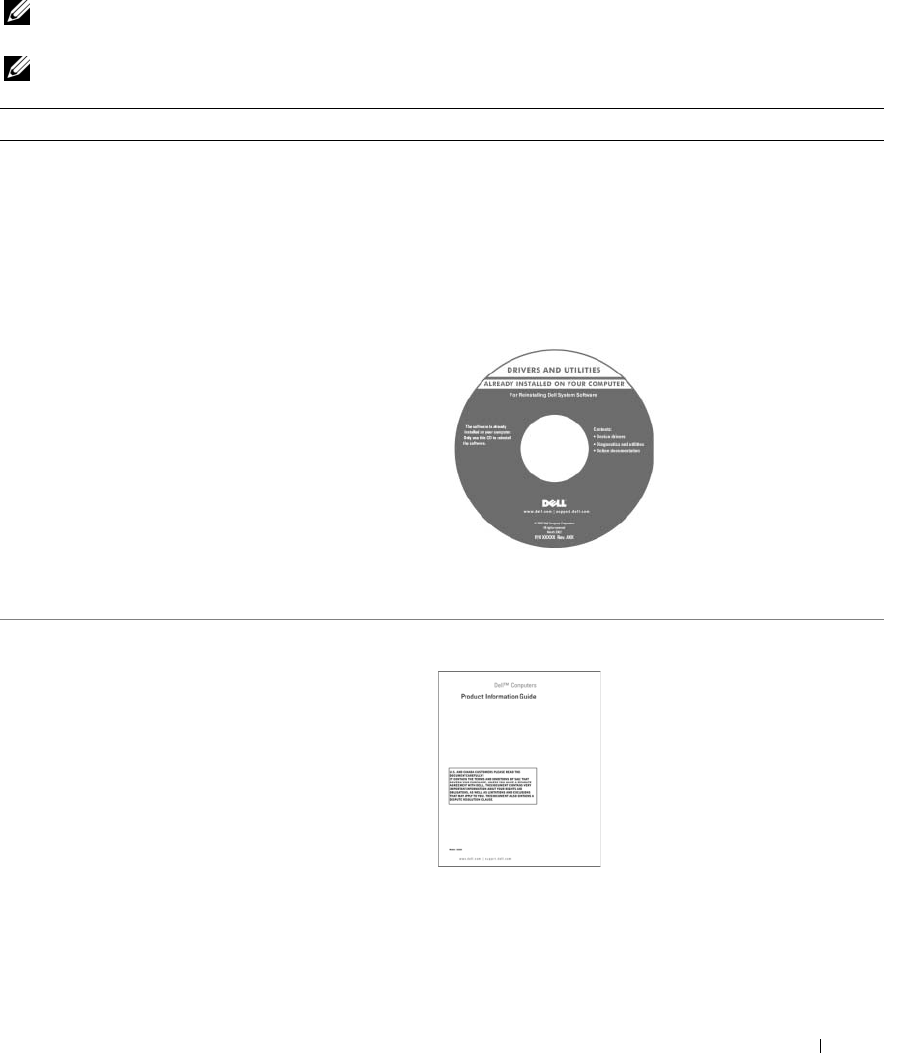
Finding Information 13
Finding Information
NOTE: Some features or media may be optional and may not ship with your computer. Some features or media may
not be available in certain countries.
NOTE: Additional information may ship with your computer.
What Are You Looking For? Find It Here
• A diagnostic program for my computer
• Drivers for my computer
• Notebook System Software (NSS)
Drivers and Utilities CD (also known as ResourceCD)
The Drivers and Utilities CD contains drivers that were
installed during assembly of the computer. Use the Drivers
and Utilities CD to load any required drivers, including the
drivers required if your computer has a RAID controller
(see "Reinstalling Drivers and Utilities" on page 124). You
can also use this CD to run the Dell™ Diagnostics (see
"Dell Diagnostics" on page 91).
Readme files may be
included on your CD to
provide last-minute
updates about technical
changes to your computer
or advanced technical-
reference material for
technicians or experienced
users.
NOTE: Drivers and documentation updates can be found at
support.dell.com.
• Warranty information
• Terms and Conditions (U.S. only)
• Safety instructions
• Regulatory information
• Ergonomics information
• End User License Agreement
Dell Product Information Guide
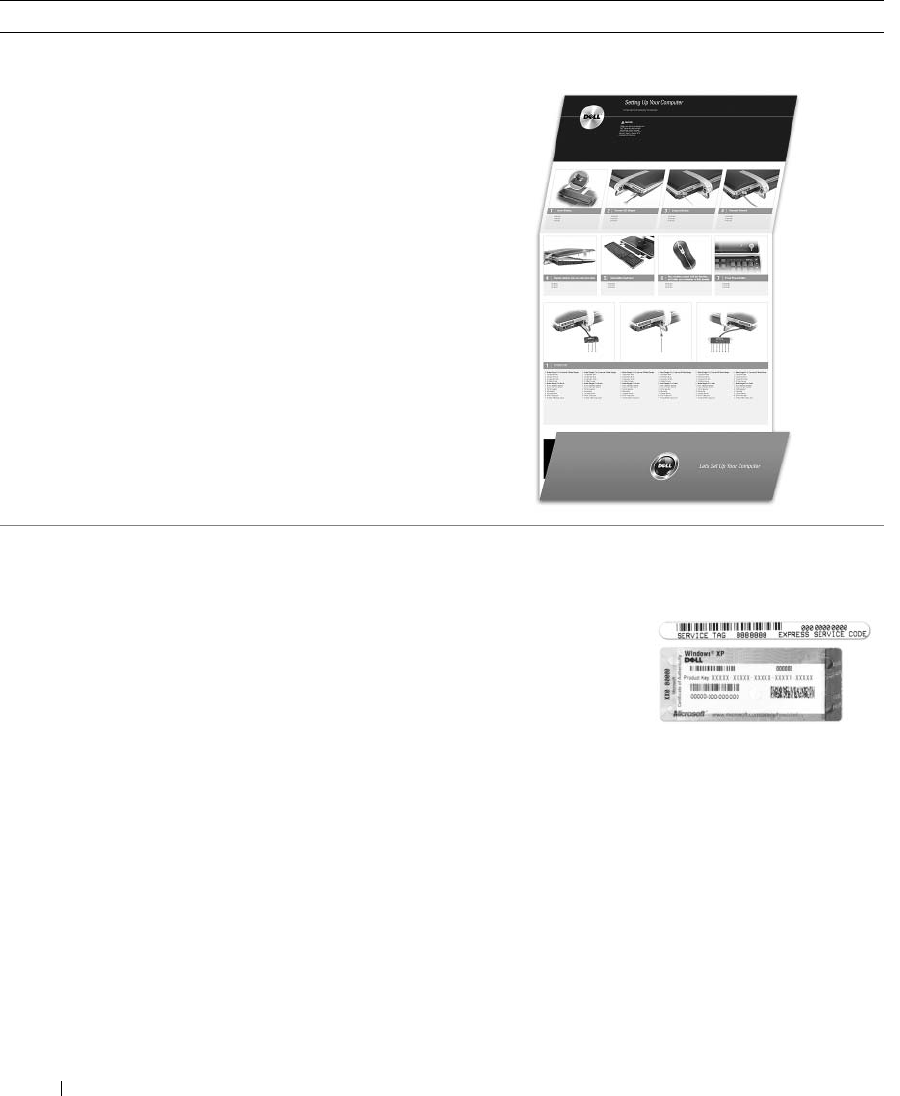
14 Finding Information
• How to set up my computer
Setup Diagram
• Service Tag and Express Service Code
• Microsoft Windows License Label
• Model Name, electrical ratings, Agency approval marks
Service Tag and Microsoft
®
Windows
®
License
The service tag label is located inside the computer base
battery compartment of your computer.
• Enter the Express
Service Code to direct
your call when
contacting support.
The Microsoft Windows License Label in on the base of
your computer.
Model Name, electrical ratings, and Agency approval marks
are
located inside the computer base battery compartment
of your computer. See
"Removing the Battery" on page 59
.
What Are You Looking For? Find It Here

Finding Information 15
• Solutions — Troubleshooting hints and tips, articles
from technicians, and online courses, frequently asked
questions
• Community — Online discussion with other Dell
customers
• Upgrades — Upgrade information for components, such
as memory, the hard drive, and the operating system
• Customer Care — Contact information, service call and
order status, warranty, and repair information
• Service and support — Service call status and support
history, service contract, online discussions with
technical support
• Reference — Computer documentation, details on my
computer configuration, product specifications, and
white papers
• Downloads — Certified drivers, patches, and software
updates
• Notebook System Software (NSS) — If you reinstall the
operating system for your computer, you should also
reinstall the NSS utility. NSS provides critical updates
for your operating system and support for Dell 3.5-inch
USB floppy drives, Intel
®
processors, optical drives, and
USB devices. NSS is necessary for correct operation of
your Dell computer. The software automatically detects
your computer and operating system and installs the
updates appropriate for your configuration.
Dell Support Website — support.dell.com
NOTE: Select your region or business segment to view the
appropriate support site.
To download Notebook System Software:
1
Go to
support.dell.com
, select your region or business
segment, and enter your Service Tag.
2
Select
Drivers & Downloads
and click
Go
.
3
Click your operating system and search for the keyword
Notebook System Software
.
NOTE: The support.dell.com user interface may vary
depending on your selections.
• Software upgrades and troubleshooting hints —
Frequently asked questions, hot topics, and general
health of your computing environment
Dell Support Utility
The Dell Support Utility is an automated upgrade and
notification system installed on your computer. This
support provides real-time health scans of your computing
environment, software updates, and relevant self-support
information. Access the Dell Support Utility from the
icon in the taskbar. For more information, see "Dell Support
Utility" on page 94.
• How to use Windows XP
• How to work with programs and files
• How to personalize my desktop
Windows Help and Support Center
1
Click
Start
→
Help and Support
.
2
Type a word or phrase that describes your problem and
click the arrow icon.
3
Click the topic that describes your problem.
4
Follow the instructions on the screen.
What Are You Looking For? Find It Here

16 Finding Information
• Information on network activity, the Power Management
Wizard, hotkeys, and other items controlled by Dell
QuickSet.
Dell QuickSet Help
To view
Dell QuickSet Help
,
right-click the icon
in the Microsoft Windows taskbar.
For more information on Dell QuickSet, see "Dell
QuickSet" on page 139.
• How to reinstall my operating system
Operating System CD
The operating system is already installed on your computer.
To reinstall your operating system, use the Operating
System CD. See "Reinstalling Windows XP" on page 128.
After you reinstall your
operating system, use the
Drivers and Utilities CD
(ResourceCD) to reinstall
drivers for the devices that
came with your computer.
Your operating system
product key label is located
on your computer.
NOTE: The color of your CD
varies based on the operating system you ordered.
• Information on Microsoft
Windows XP Media Center
Edition
• Standard remote control instructions
Dell Media Center User’s Guide
What Are You Looking For? Find It Here
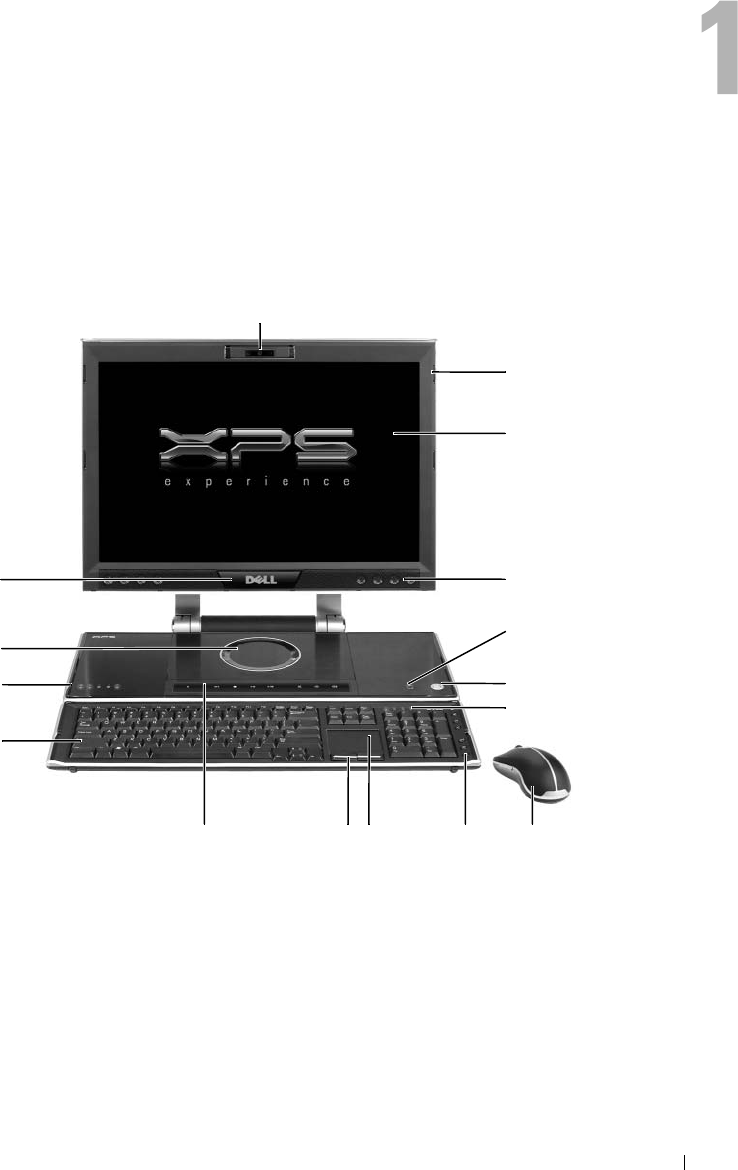
About Your Computer 17
About Your Computer
Front View
1
camera
2
display latches (4)
3
display
4
speakers (8)
5
MediaDirect button
6
power button
7
keyboard status lights (4)
8
mouse
9keyboard
media control
buttons
10
touch pad
11
touch pad buttons (2)
12 base
media control buttons
13
keyboard
14
device status lights (5)
15
DVD drive
16
infrared sensor
1
5
2
1012
4
14
3
6
15
7
911
13
8
16
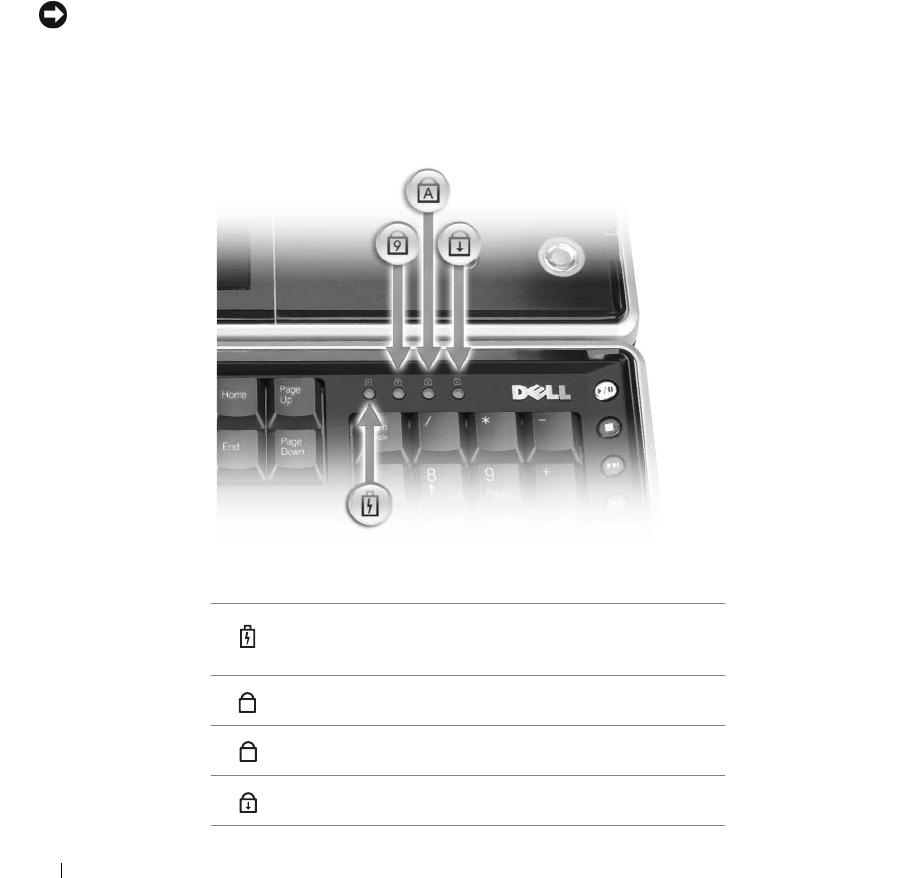
18 About Your Computer
CAMERA —Built-in camera for video-conferencing.
DISPLAY —For more information about your display, see "Using the Display" on page 51.
DISPLAY LATCHES (4) — To keep the display closed.
SPEAKERS (8) — To adjust the volume of the integrated speaker, press the volume control buttons, mute button, or
volume-control keyboard shortcuts. For more information, see "Key Combinations" on page 34.
MEDIADIRECT BUTTON —Controls access to Dell MediaDirect™. For more information, see "Using Dell Media
Experience and Dell MediaDirect" on page 44.
POWER BUTTON —Press the power button to turn on the computer or exit a
power management mode.
NOTICE: To avoid losing data, turn off your computer by performing a Microsoft® Windows® operating system
shutdown rather than by pressing the power button.
If the computer stops responding, press and hold the power button until the computer turns off completely (which
may take several seconds).
KEYBOARD STATUS LIGHTS (4)
The blue lights located at the top right of the keyboard indicate the following:
Turns on steadily or blinks to indicate keyboard battery
charge status.
Turns on when the numeric keypad is enabled.
Turns on when the uppercase letter function is enabled.
Turns on when the scroll lock function is enabled.
9
A
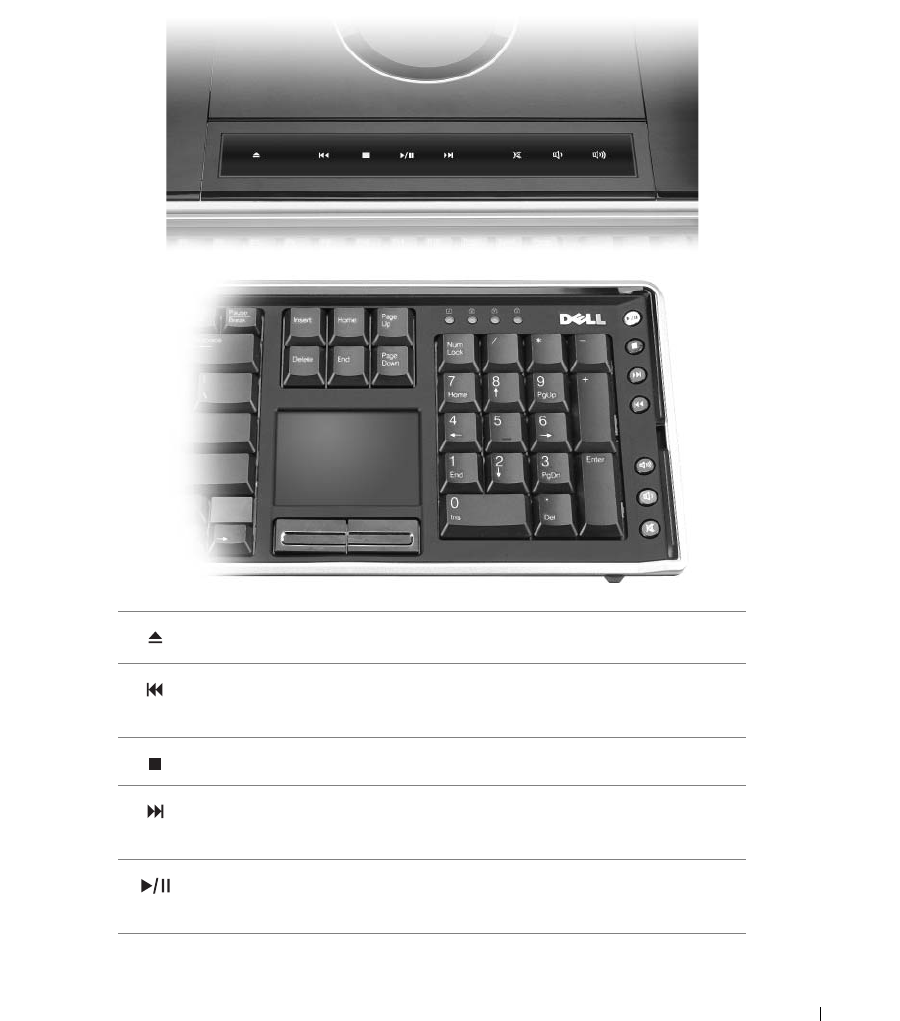
About Your Computer 19
MOUSE —Wireless mouse. For more information, see "Using the Keyboard and Mouse" on page 29.
MEDIA CONTROL BUTTONS —Control CD and DVD playback.
Press to open or close the DVD drive. If media is present in the closed
drive, pressing this button will open the drive and eject the media.
Press once to go back to the start of the current playing track/chapter.
Press multiple times to skip back to previous track/chapters. Press and
hold to rewind within the current track/chapter.
Press to stop the CD or DVD.
Press once to skip forward one track/chapter. Press multiple times to skip
forward multiple tracks/chapters. Press and hold to fast-forward within the
current track/chapter.
Press to either play or pause the media. If there is no media playing in the
drive, pressing this button opens either the CD or DVD menu with Media
Center Experience, depending on the type of disk in the drive.
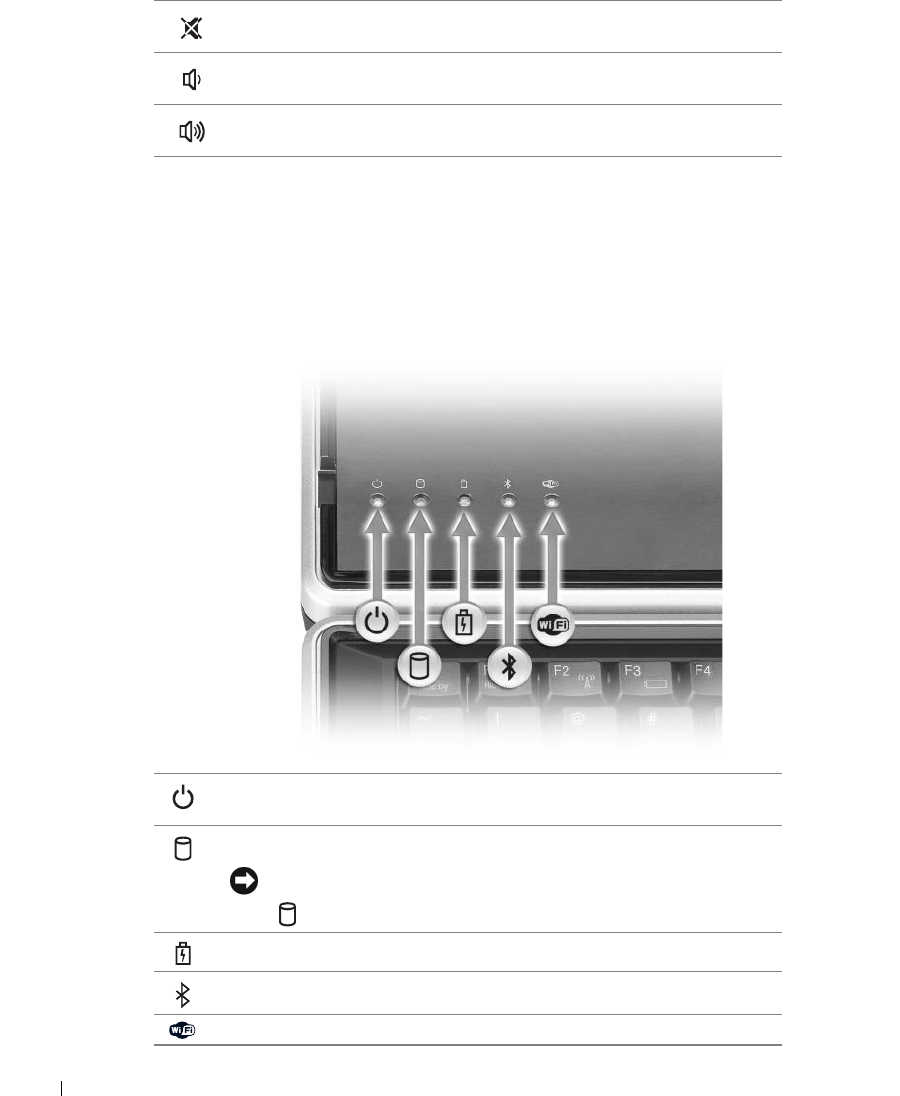
20 About Your Computer
TOUCH PAD —Provides the functionality of a mouse. See "Touch Pad" on page 35 for more information.
TOUCH PAD BUTTONS (2) — Provide the functionality of a mouse. See "Touch Pad" on page 35 for more
information.
KEYBOARD —The wireless keyboard includes a numeric keypad as well as the Windows logo key. For information on
supported keyboard shortcuts, see "Numeric Keypad" on page 33.
DEVICE STATUS LIGHTS (5)
Press to turn off the volume of audio output from internal or external
speakers.
Press to decrease the volume of audio output from internal or external
speakers.
Press to increase the volume of audio output from internal or external
speakers.
Turns on when you turn on the computer and blinks when the computer is
in a power management mode.
Turns on when the computer reads or writes data.
NOTICE: To avoid loss of data, never turn off the computer while the
light is flashing.
Turns on steadily or blinks to indicate battery charge status.
Turns on when Bluetooth® wireless technology is enabled.
Turns on when wireless devices are enabled.
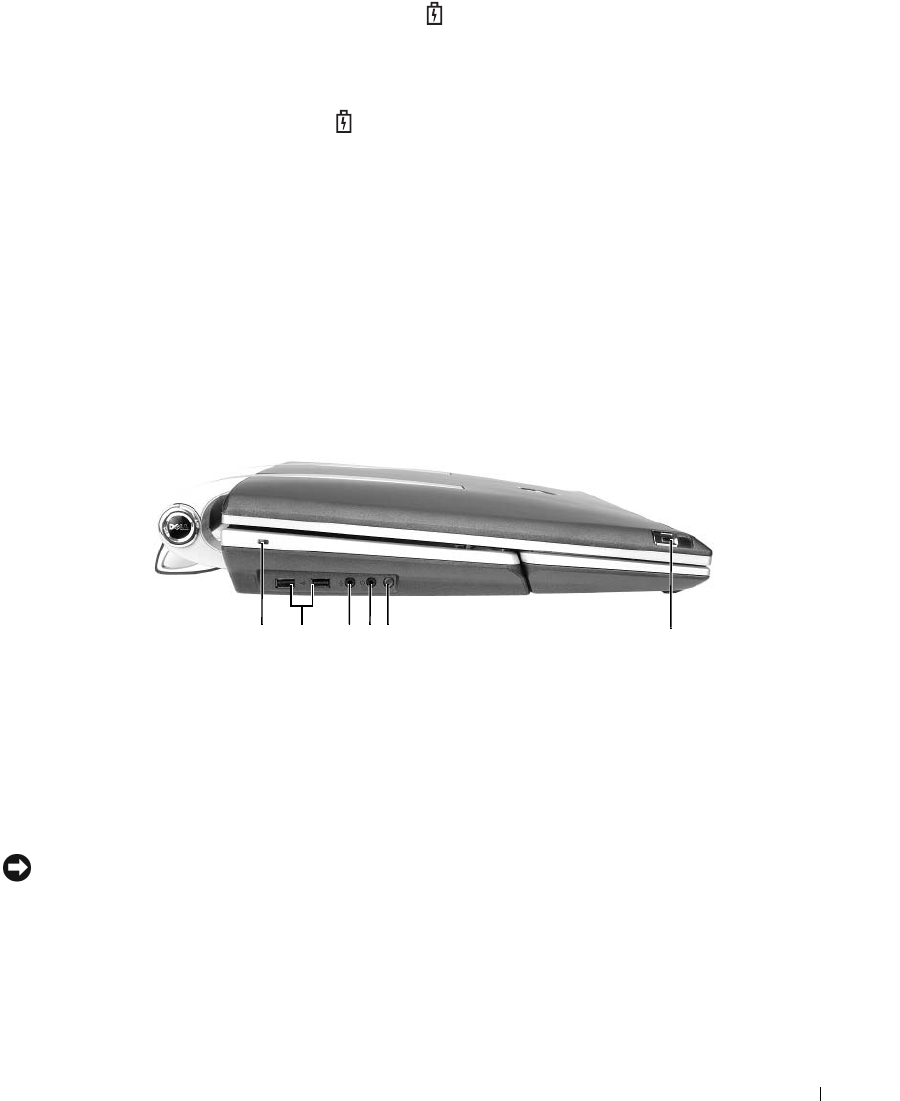
About Your Computer 21
If the computer is connected to an electrical outlet, the light operates as follows:
– Solid blue: The battery is charging.
– Flashing blue: The battery is almost fully charged.
– Off: The battery is adequately charged (or external power is not available to charge the battery).
If the computer is running on a battery, the light operates as follows:
– Off: The battery is adequately charged (or the computer is turned off).
– Flashing orange: The battery charge is low.
– Solid orange: The battery charge is critically low.
DVD DRIVE —Plays CDs and DVDs. The DVD drive is controlled by the media buttons. For more information, see
"Using Multimedia" on page 39.
INFRARED SENSOR —Used to control your Media Center PC from up to 20 feet away with the standard remote
control.
Left View
SECURITY CABLE SLOT —Lets you attach a commercially available antitheft device to the computer. For more
information, see the instructions included with the device.
NOTICE: Before you buy an antitheft device, ensure that it will work with the security cable slot.
1
security cable slot
2
USB 2.0 connectors (2)
3
microphone connector
4
headphone connector
5
wireless connection button
(Bluetooth wireless
technology)
6
display latch release
124 6
3 5
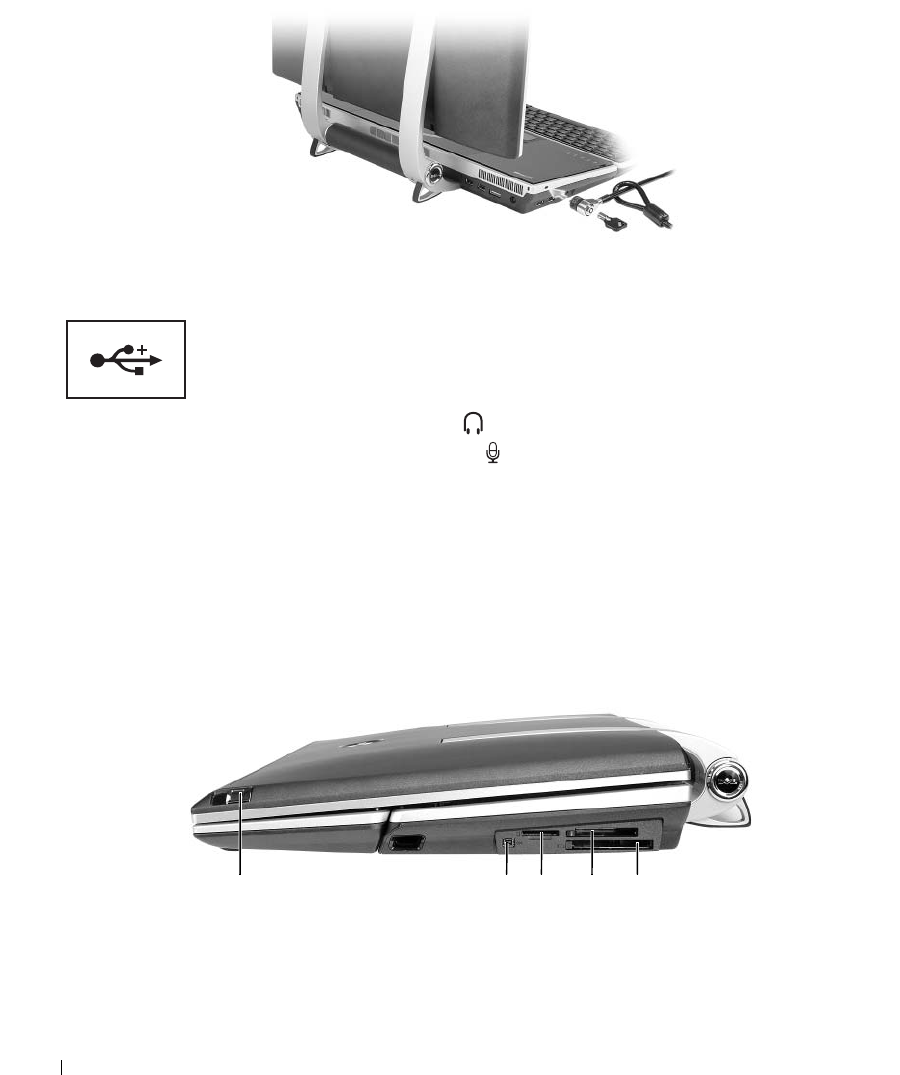
22 About Your Computer
USB 2.0 CONNECTORS (2)
HEADPHONE CONNECTOR —Attach headphones to the connector.
MICROPHONE CONNECTOR —Attach a microphone to the connector for voice or musical input into a sound or
telephony program.
WIRELESS CONNECTION BUTTON —Puts the computer into "discover" mode to connect the wireless keyboard and
mouse with the system using Bluetooth wireless technology if the pairing is lost. For more information, see "Pairing
the Keyboard" on page 29 and "Pairing the Mouse" on page 31.
DISPLAY LATCH RELEASE —Slide these latches forward to open your display.
Right View
Connects USB devices, such as a mouse, keyboard, or
printer.
1
display latch release
2
IEEE 1394 connector
(firewire)
3
media memory card reader
4
compact flash card reader
5
ExpressCard Slot
1 2 3 4 5

About Your Computer 23
IEEE 1394 CONNECTOR (FIREWIRE)—Connects devices supporting IEEE 1394 high-speed transfer rates, such as
some digital video cameras, hard drives, and CD drives.
MEDIA MEMORY CARD READER —Provides a fast and convenient way to view and share digital photos, music, and
videos stored on a media memory card. The media memory card reader reads the following digital media memory
cards:
• Secure Digital (SD) card/SDIO
• MultiMediaCard (MMC)
• Memory Stick (MS)
• Memory Stick Pro
• xD-Picture Card
With a commonly available adapter, the memory card reader also reads the following digital media memory cards:
• MiniSD
•RSMMC
• Memory Stick Duo
• Memory Stick Pro Duo
COMPACT FLASH CARD READER —Provides a fast and convenient way to view and share digital photos, music, and
videos stored on a media memory card. The media memory card reader reads the following digital media memory
cards:
• Compact Flash Type I
• Compact Flash Type II
• Microdrive
EXPRESSCARD SLOT —Supports 34- and 54-mm PCI ExpressCards or USB-based ExpressCards. See "Using
Cards" on page 83.
NOTE: PCMCIA cards will not work in the ExpressCard slot.
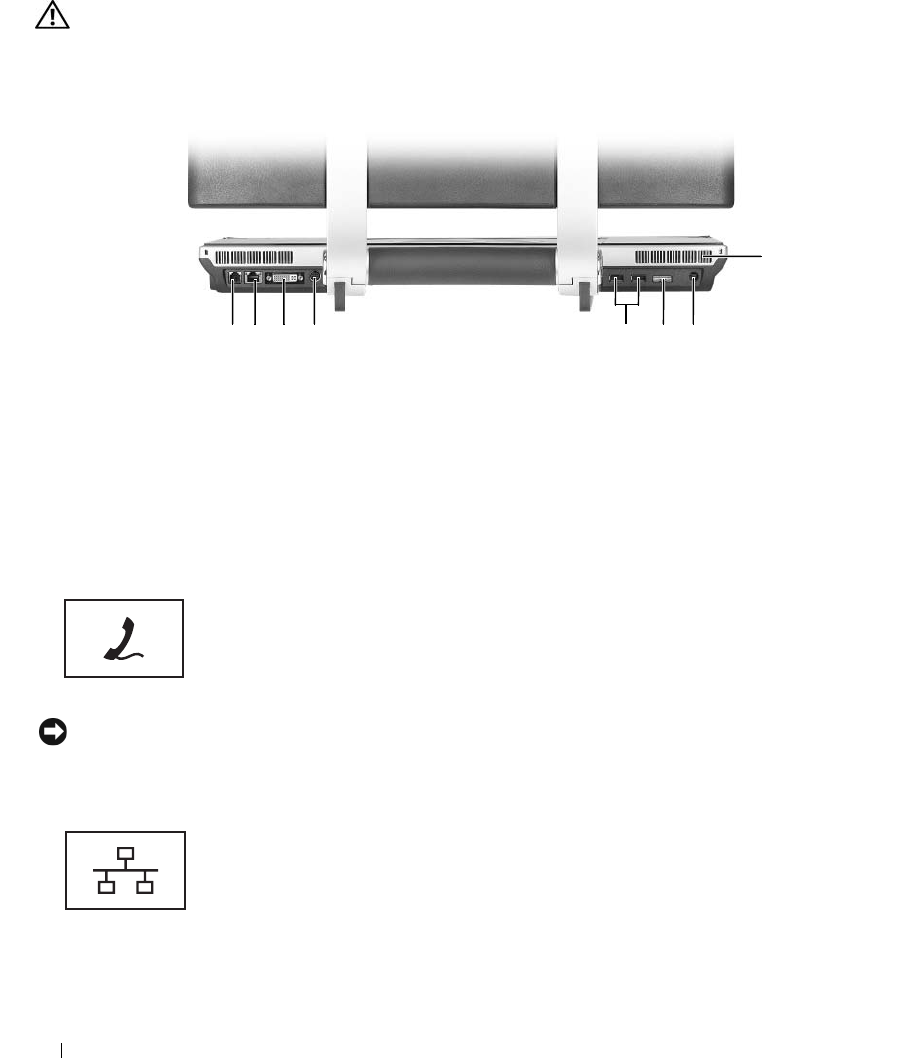
24 About Your Computer
Back View
CAUTION: Do not block, push objects into, or allow dust to accumulate in the air vents. Do not store your
computer in a low-airflow environment, such as a closed briefcase, while it is running. Restricting the airflow
can damage the computer or cause a fire.
MODEM CONNECTOR (RJ-11)
NETWORK CONNECTOR (RJ-45)
NOTICE: The network connector is slightly larger than the modem connector. To avoid damaging the computer,
do not plug a telephone line into the network connector.
1
modem connector (RJ-11)
2
network connector (RJ-45)
3
digital-video interface (DVI-I)
connector
4
S-video TV-out connector
5
USB 2.0 connectors (2)
6
audio/IR blaster adapter
connector
7
AC adapter connector
8
air vents (3)
If you ordered the optional internal modem, connect the telephone line to the
modem connector.
For information on using the modem, see the online modem documentation
supplied with your computer. See "Finding Information" on page 13.
Connects the computer to a network. The two lights next to the connector
indicate status and activity for wired network connections.
For information on using the network adapter, see the online network adapter
documentation supplied with your computer.
1 2 3 4 65 7
8
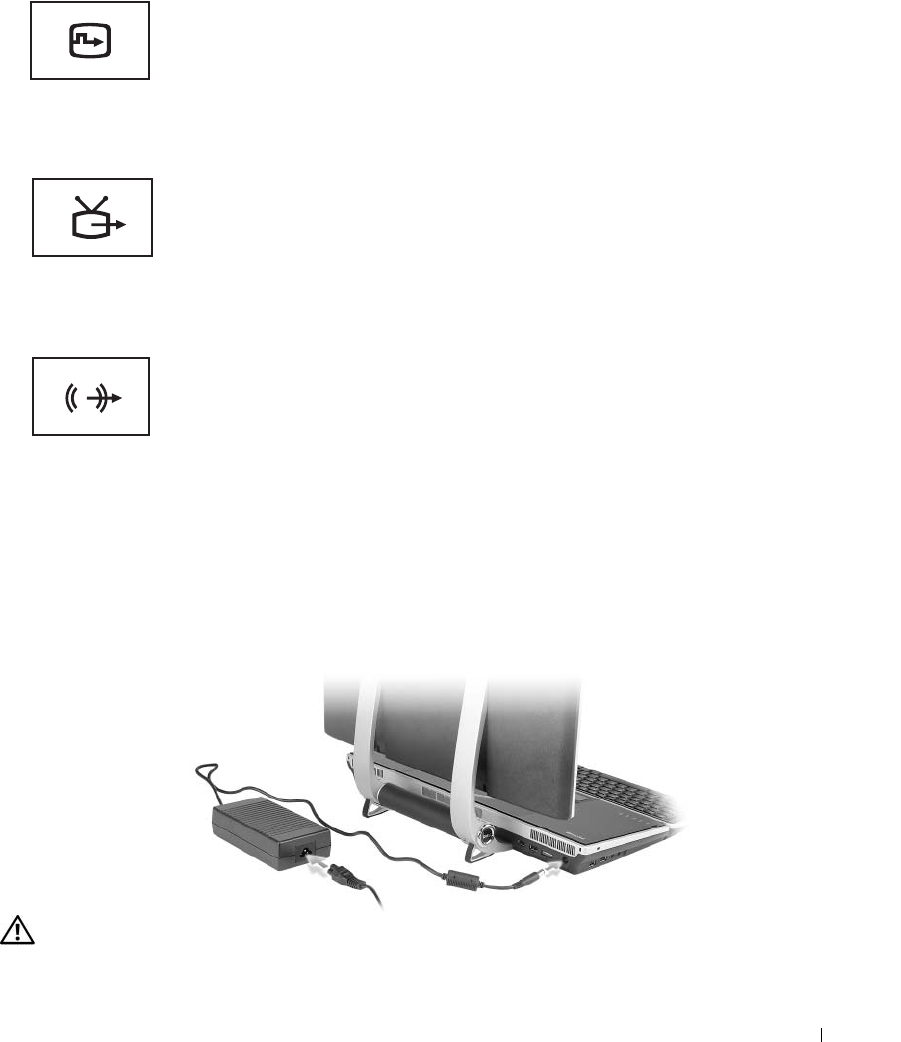
About Your Computer 25
DIGITAL-VIDEO INTERFACE (DVI-I) CONNECTOR
S-VIDEO TV-OUT CONNECTOR
AUDIO/IR BLASTER ADAPTER CONNECTOR
AC ADAPTER CONNECTOR —Connects an AC adapter to the computer.
The AC adapter converts AC power to the DC power required by the computer. You can connect the AC adapter
with your computer turned either on or off.
CAUTION: The AC adapter works with electrical outlets worldwide. However, power connectors and power
strips vary among countries. Using an incompatible cable or improperly connecting the cable to the power strip
or electrical outlet may cause fire or equipment damage.
Connects an external DVI-compatible monitor or a High Definition TV.
With an adapter cable, you can also connect an external VGA-compatible
monitor to the DVI connector.
Connects your computer to a TV through this analog video out port. An
adapter can be used for composite and component video out. See "Using
Your Computer With a TV or Audio Device" on page 45.
Connects the following devices:
• multi-channel analog audio I/O to connect 7.1 speakers or 5.1 speakers
with line input, microphones, MP3 players, tape decks, etc.
• digital S/PDIF output (TOSLINK optical connection) to connect home
theater receivers, minidisk players, or high-end digital decoding 5.1 speakers
• IR blaster outputs are used by Windows Media Center Edition to control
external consumer electronic devices, such as satellite/cable boxes, VCRs,
etc.
For details, see "Connecting Audio/IR Blaster Adapter" on page 47.
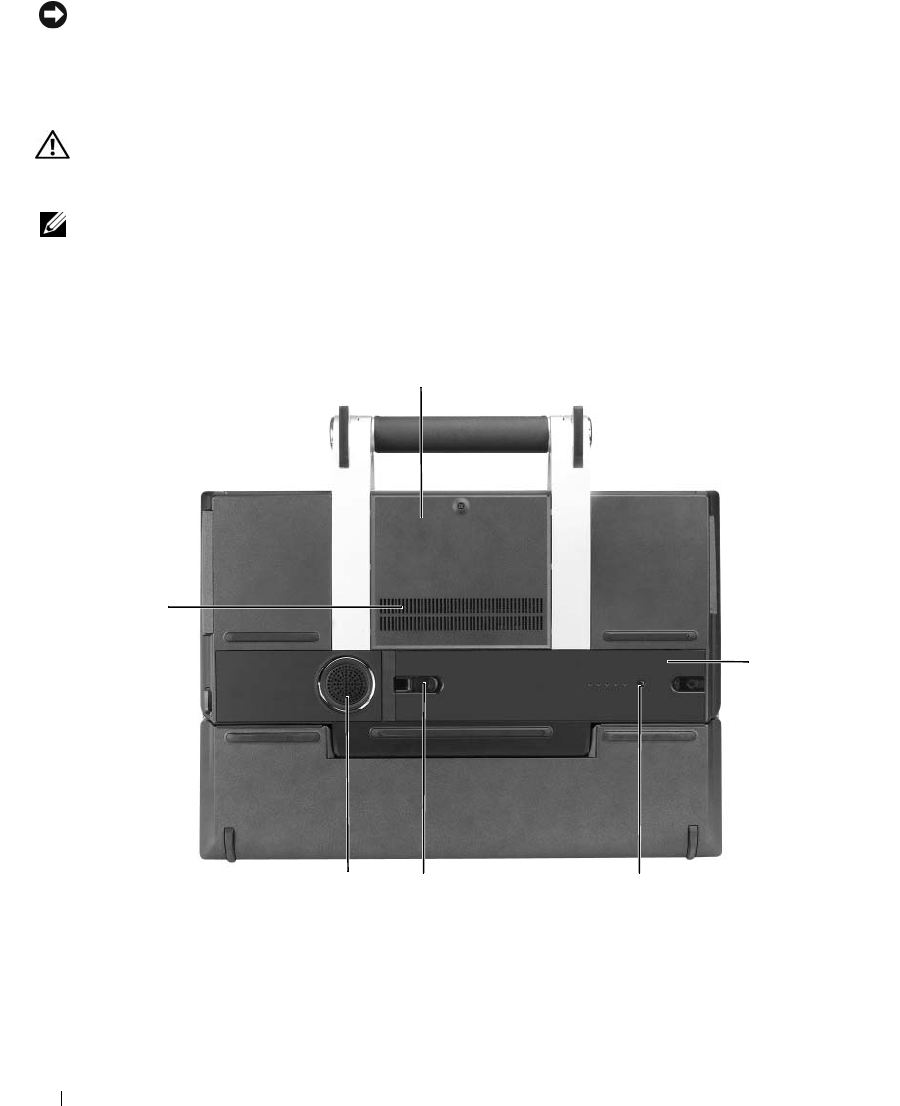
26 About Your Computer
NOTICE: When you disconnect the AC adapter cable from the computer, grasp the connector, not the cable itself,
and pull firmly but gently to avoid damaging the cable. When you wrap the AC adapter cable, ensure that you follow
the angle of the connector on the AC adapter to avoid damaging the cable.
AIR VENTS (3) — The computer uses an internal fan to create airflow through the vents, which prevents the
computer from overheating. There are three sets of air vents on the back of the computer.
CAUTION: Do not block, push objects into, or allow dust to accumulate in the air vents. Do not store your
computer in a low-airflow environment, such as a closed briefcase, while it is running. Restricting the airflow
can damage the computer or cause a fire.
NOTE: The computer turns on the fan when the computer gets hot. Fan noise is normal and does not indicate a
problem with the fan or the computer.
Bottom View
1
memory module cover
2
battery
3
battery charge gauge
4
battery latch release
5
subwoofer cover
6
fan air vents
6
5
1
4
2
3

About Your Computer 27
MEMORY MODULE COVER —Covers the compartment that contains the secondary memory module. See "Memory"
on page 133.
BATTERY —When a battery is installed, you can use the computer without connecting the computer to an
electrical outlet. See "Using a Battery" on page 57.
BATTERY CHARGE GAUGE —Identifies the amount of charge remaining in the battery. See "Charge Gauge" on
page 62.
BATTERY LATCH RELEASE —Releases the battery. See "Replacing the Battery" on page 57 for instructions.
SUBWOOFER COVER —Covers the compartment that contains the subwoofer.
FAN AIR VENTS —The computer uses an internal fan to create airflow through the fan air vents, which prevents the
computer from overheating.
NOTE: The computer turns on the fan when the computer gets hot. Fan noise is normal and does not indicate a
problem with the fan or the computer.
CAUTION: Do not block, push objects into, or allow dust to accumulate in the air vents. Do not store your
computer in a low-airflow environment, such as a closed briefcase, while it is running. Restricting the airflow
can damage the computer or cause a fire.

28 About Your Computer
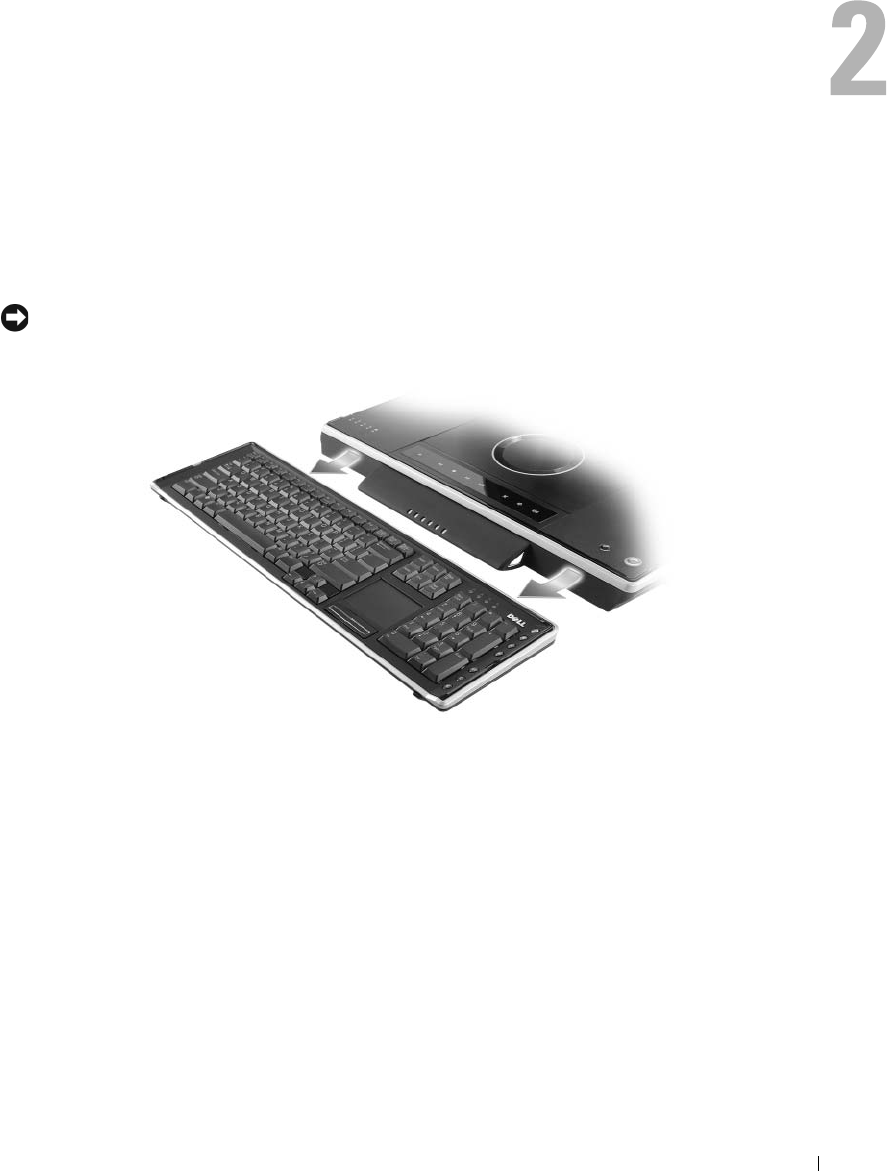
Using the Keyboard and Mouse 29
Using the Keyboard and Mouse
Your computer comes with a detachable wireless keyboard and a wireless mouse with Bluetooth®
wireless technology. Before you use your computer for the first time, both the keyboard and the
mouse must be paired with your computer. See "Pairing the Keyboard" on page 29 and "Pairing the
Mouse" on page 31.
NOTICE: Do not attempt to move the computer with the keyboard attached and the display open or the
keyboard will fall away from the computer base.
To detach the keyboard, grasp the sides of the keyboard and pull it straight out and away from the
computer base.
The keyboard must be awake to recognize keystrokes. Ensure the keyboard is awake by touching the
touchpad.
Pairing the Keyboard
Before using your wireless keyboard for the first time, you must pair it with the computer so that the
computer recognizes the keyboard. If the computer and keyboard become unpaired and the
computer fails to recognize the keyboard, you can repair them.
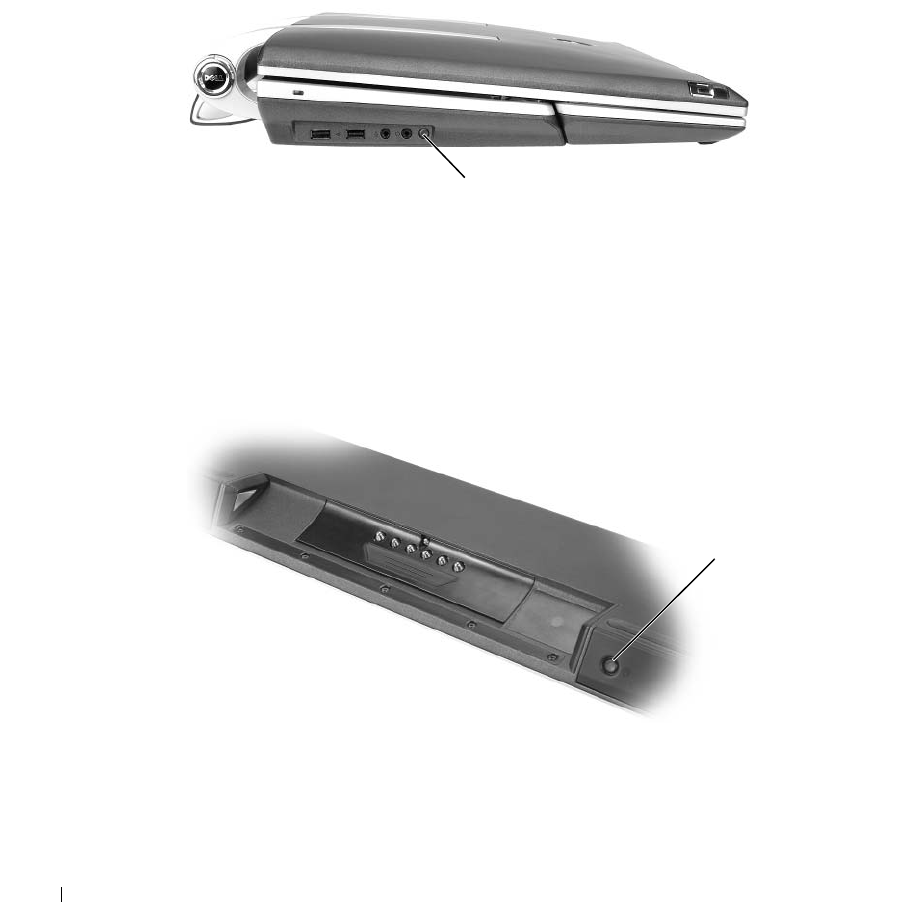
30 Using the Keyboard and Mouse
Keyboard Pairing Failed
If your keyboard fails to connect, follow these steps:
1
Press the power button to restart the computer and wait about three minutes for the operating system
to load and the computer to initialize the drivers.
2
Press the wireless connection button on the left side of the computer base and hold until the Bluetooth
light on the system flashes.
3
Press the wireless connection button on the back of the keyboard and hold for about four seconds to
put the keyboard into "discover" mode. The Caps lock, Scroll, and Num lock wireless Bluetooth lights
on the keyboard will be solid blue. Release the wireless connection button on the keyboard and these
lights will all start flashing.
The computer may go through a series of beeps before the pairing occurs.
1wireless connection button
on computer base
1wireless connection button
on keyboard
1
1
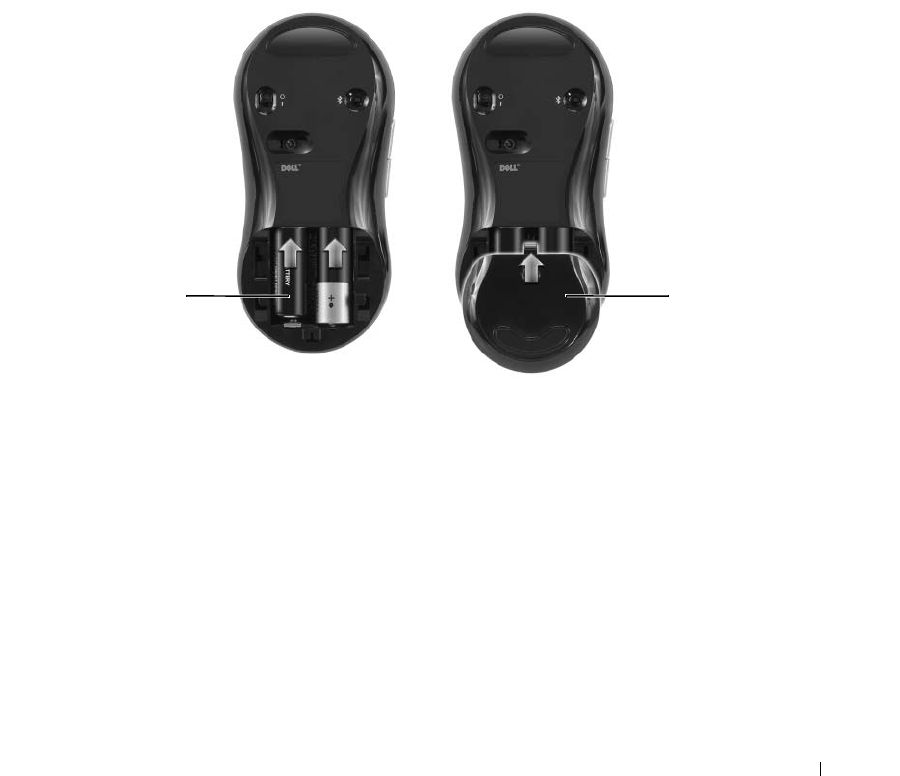
Using the Keyboard and Mouse 31
4
Test the pairing by touching the touchpad to move the cursor to ensure that pairing was successful.
If pairing was unsuccessful, repeat these steps as necessary to pair your keyboard with your computer.
Pairing the Mouse
The Dell™ XPS™ M2010 Mouse Connection Wizard should launch the first time you turn on your
computer. It will help you pair your mouse with your computer.
Mouse Pairing With the Wizard
Follow the instructions on the screen:
1
Insert two AA batteries, which are shipped uninstalled, into the mouse and replace the battery cover.
1batteries 2battery cover
1 2
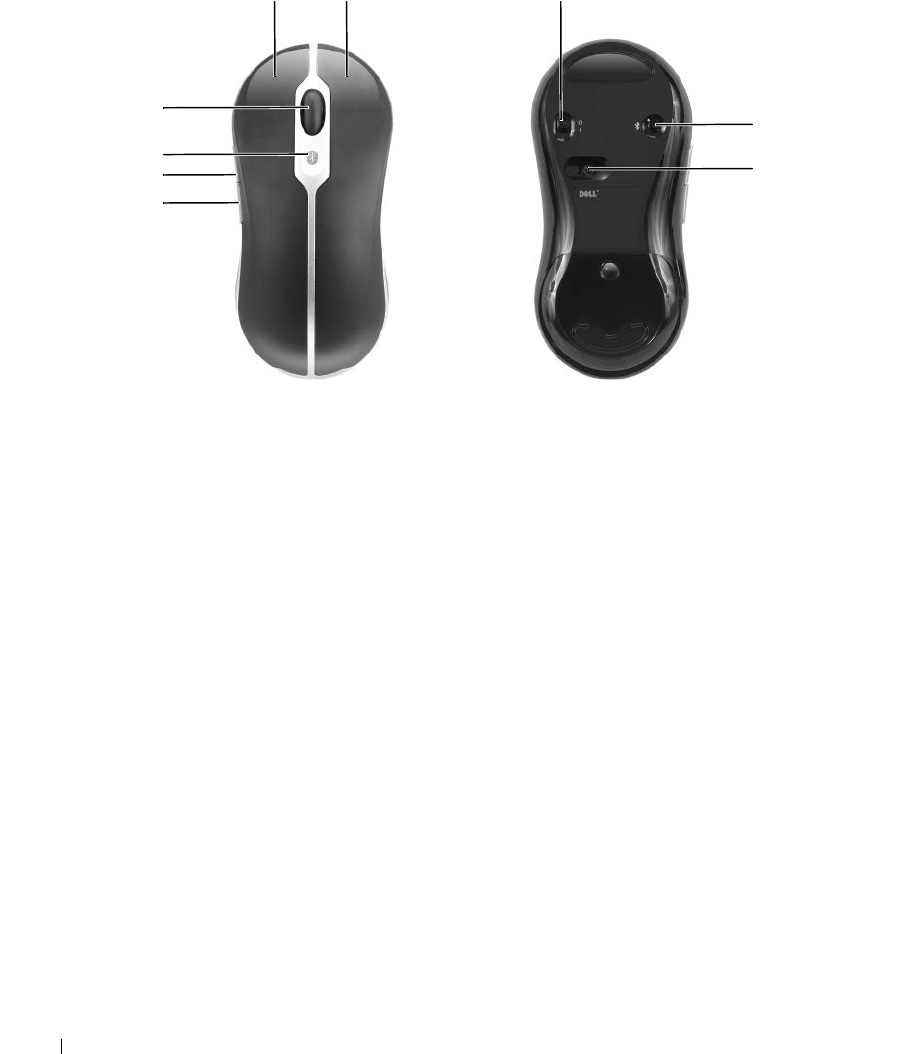
32 Using the Keyboard and Mouse
2
Power on the mouse by sliding the power switch on the bottom of the mouse to the
On
position. The
optical sensor lights when the mouse is on.
3
Press the wireless (Bluetooth) connection button on the bottom of the mouse.
4
Click
Next
on the Wizard within 60 seconds to complete the pairing. The message
Your mouse
has been connected and is ready to use
displays when the pairing is complete.
5
If the mouse and computer failed to pair, turn the power switch off and back on again, then press the
wireless (Bluetooth) connection button again.
6
Click
Next
on the Wizard to pair the mouse with the computer.
Repeat these steps as necessary to pair your mouse with your computer.
1back button 2forward button 3wireless light
4scroll wheel 5left mouse button 6right mouse button
7power switch 8wireless (Bluetooth)
connection button
9optical sensor
4
3
2
1
56
8
7
9
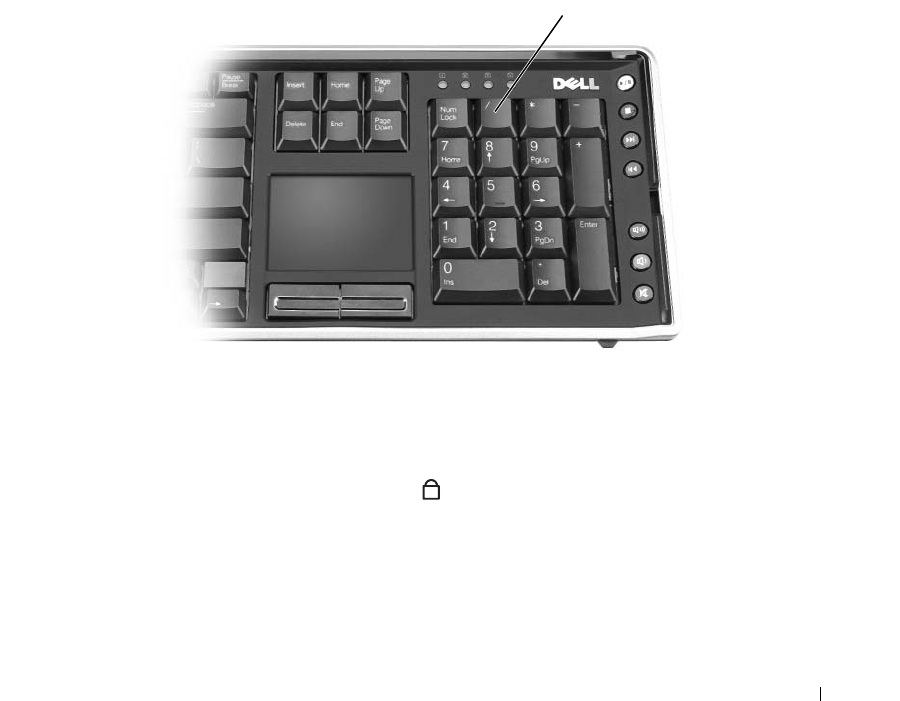
Using the Keyboard and Mouse 33
Mouse Pairing Failed
If for some reason the Wizard does not launch, or the Wizard repeatedly fails to pair your mouse with the
computer:
1
Power on the mouse by sliding the switch on the bottom of the mouse to the
On
position.
2
Press the wireless (Bluetooth) connection button on the left side of the computer base to put the
computer into "discover" mode. The wireless (Bluetooth) light on the system will blink.
3
Press the wireless (Bluetooth) connection button on the bottom of the mouse to put the mouse into
"discover" mode. The blue wireless light on the mouse will blink, and the connection will be made to
pair the computer with the mouse. The total time to complete mouse pairing is less than 20 seconds.
After completing the pairing, the blue wireless light on the mouse will stop blinking and continue to
light for 2 to 3 seconds, and then go out.
Numeric Keypad
The numeric keypad functions like the numeric keypad on an external keyboard. Each key on the keypad
has multiple functions.
• To enable the keypad, press <Num Lk>. The light indicates that the keypad is active.
• To disable the keypad, press <Num Lk> again.
1numeric keypad
1
9

34 Using the Keyboard and Mouse
Key Combinations
System Functions
Battery
Display Functions
Wireless Networking Technology Function
Display Switch
Power Management
<Ctrl><Shift><Esc> Opens the Task Manager window.
<Fn><F3> Displays the Dell QuickSet Battery Meter (see "Dell
QuickSet Battery Meter" on page 62).
<Fn><F2> Enables and disables wireless 802.11 networking
technology. It does not disable the Bluetooth wireless
technology.
NOTE: This feature can be disabled by the BIOS setup
program.
<Fn><F8> Allows you to switch the currently active display from the
LCD to a connected CRT or external monitor, projector,
or TV. To select a display, press and hold <Fn> and press
<F8> until the desired display is highlighted, then
release.
<Fn><Esc> Activates a power management mode. You can
reprogram this keyboard shortcut to activate a different
power management mode using the Advanced tab in the
Power Options Properties window.
<Fn><F1> Puts the system into hibernate mode. Dell QuickSet is
required. See "Dell QuickSet" on page 139.

Using the Keyboard and Mouse 35
Microsoft Windows Logo Key Functions
To adjust keyboard operation, such as the character repeat rate, open the Control Panel, click Printers
and Other Hardware, and click Keyboard. For information about the Control Panel, see the Microsoft®
Windows® Help and Support Center. To access the Help and Support Center, see "Windows Help and
Support Center" on page 15.
Touch Pad
The touch pad detects the pressure and movement of your finger to allow you to move the cursor on the
display. Use the touch pad and touch pad buttons as you would use a mouse.
Windows logo key and
<m>
Minimizes all open windows.
Windows logo key and
<Shift><m>
Restores all minimized windows. This key
combination functions as a toggle to restore
minimized windows following the use of the
Windows logo key and <m> key combination.
Windows logo key and <e> Runs Windows Explorer.
Windows logo key and <r> Opens the Run dialog box.
Windows logo key and <f> Opens the Search Results dialog box.
Windows logo key and
<Ctrl><f>
Opens the Search Results-Computer dialog box (if
the computer is connected to a network).
Windows logo key and
<Pause>
Opens the System Properties dialog box.
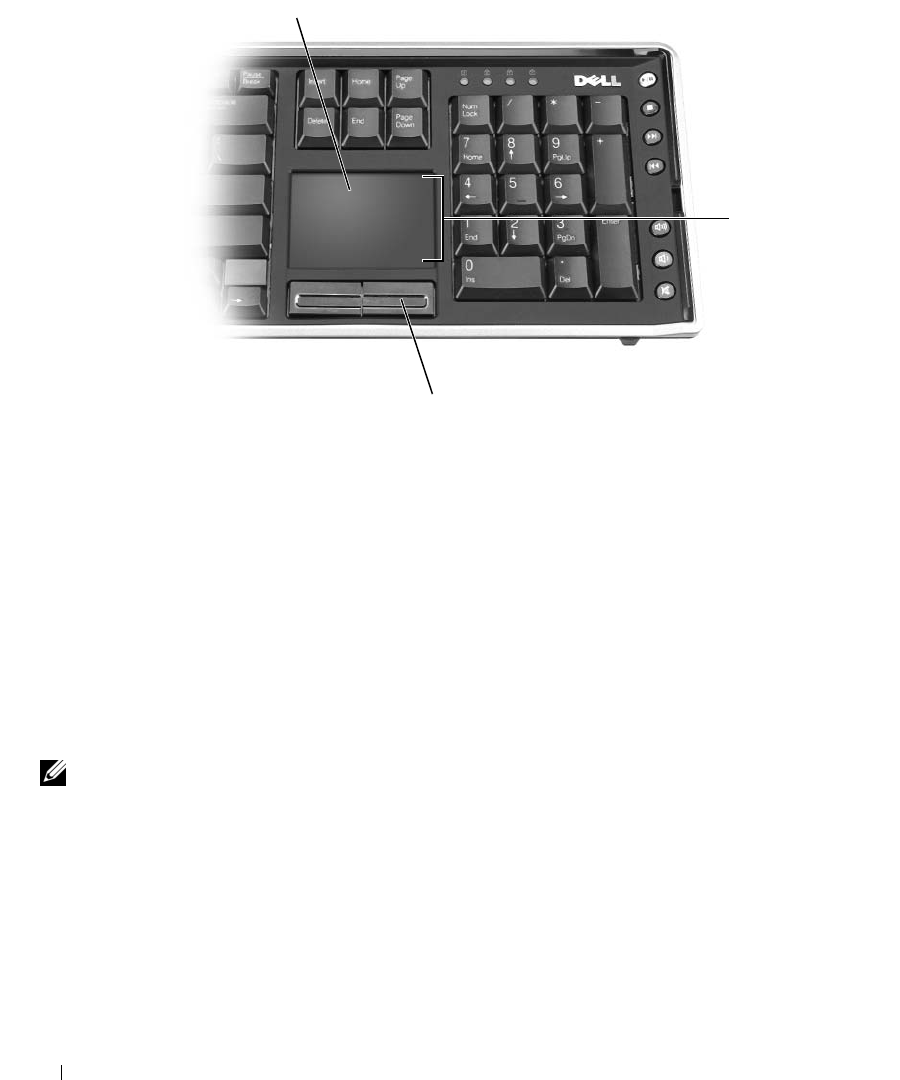
36 Using the Keyboard and Mouse
• To move the cursor, lightly slide your finger over the touch pad.
• To select an object, lightly tap once on the surface of the touch pad or use your thumb to press the left
touch-pad button.
• To select and move (or drag) an object, position the cursor on the object and tap twice on the touch
pad. On the second tap, leave your finger on the touch pad and move the selected object by sliding
your finger over the surface.
• To double-click an object, position the cursor on the object and tap twice on the touch pad or use your
thumb to press the left touch-pad button twice.
• The touch pad has scrolling capability in the scroll zone on the right side of the touch pad. Scrolling is
enabled by default. To disable this feature, modify the mouse properties through the Control Panel.
NOTE: The scroll zones may not work with all application programs. For the scroll zones to function properly, the
application program must be able to use the touch-pad scroll feature.
Customizing the Touch Pad and Mouse
You can use the Mouse Properties window to adjust settings for both the mouse and touch pad.
1
Open the Control Panel, click
Printers and Other Hardware
, and then click
Mouse
.
2
In the
Mouse Properties
window, clicking the adjustment settings for the mouse will also adjust the
touch pad settings.
3
Click
OK
to save the settings and close the window.
1touch pad 2scroll zone 3 touch pad buttons
1
2
3

Using the Keyboard and Mouse 37
Keyboard Battery
The wireless keyboard is powered by a rechargeable lithium ion battery. The keyboard battery will
recharge when the keyboard is affixed to the computer base and the base is running on AC power. The
keyboard battery does not charge when it is detached from the computer base, even if the computer is
running on AC power.
The keyboard battery indicator light on the keyboard will glow blue when the keyboard is attached to the
computer base and drawing power from the computer only when the computer is connected to AC
power. When the keyboard is detached from the computer base, the indicator does not light unless the
rechargeable keyboard battery has less than 15% charge remaining. In this case, the indicator will light
orange to alert you to the low battery, and you should attach the keyboard to the base to allow the
keyboard battery to recharge. If the keyboard battery fails, the keyboard power indicator will flash orange.
Dell QuickSet Battery Meter
If Dell QuickSet is installed, press <Fn><F3> to display the QuickSet Battery Meter window. The
Battery Status tab displays the charge status for the battery in your keyboard, as well as the primary
computer battery.
For more information about QuickSet, right-click the icon in the taskbar, and click Help.
Replacing the Keyboard Battery
CAUTION: Before you begin any of the procedures in this section, follow the safety instructions in the Product
Information Guide.
To remove the keyboard battery:
1
Turn the keyboard over.
2
Remove the captive screw at the top of the keyboard battery.
3
Slide the battery forward and out of the keyboard.
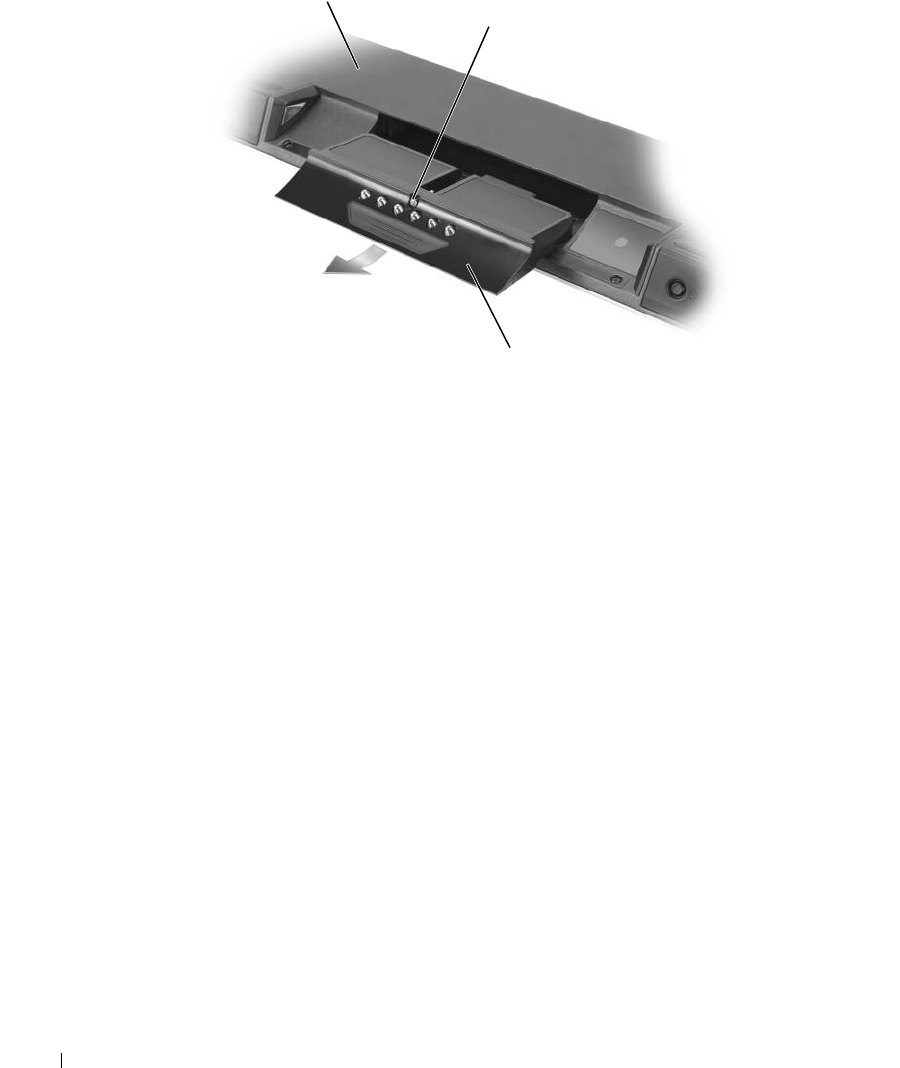
38 Using the Keyboard and Mouse
To replace the keyboard battery, follow the removal instructions in reverse.
1keyboard 2captive screw 3keyboard battery
2
1
3
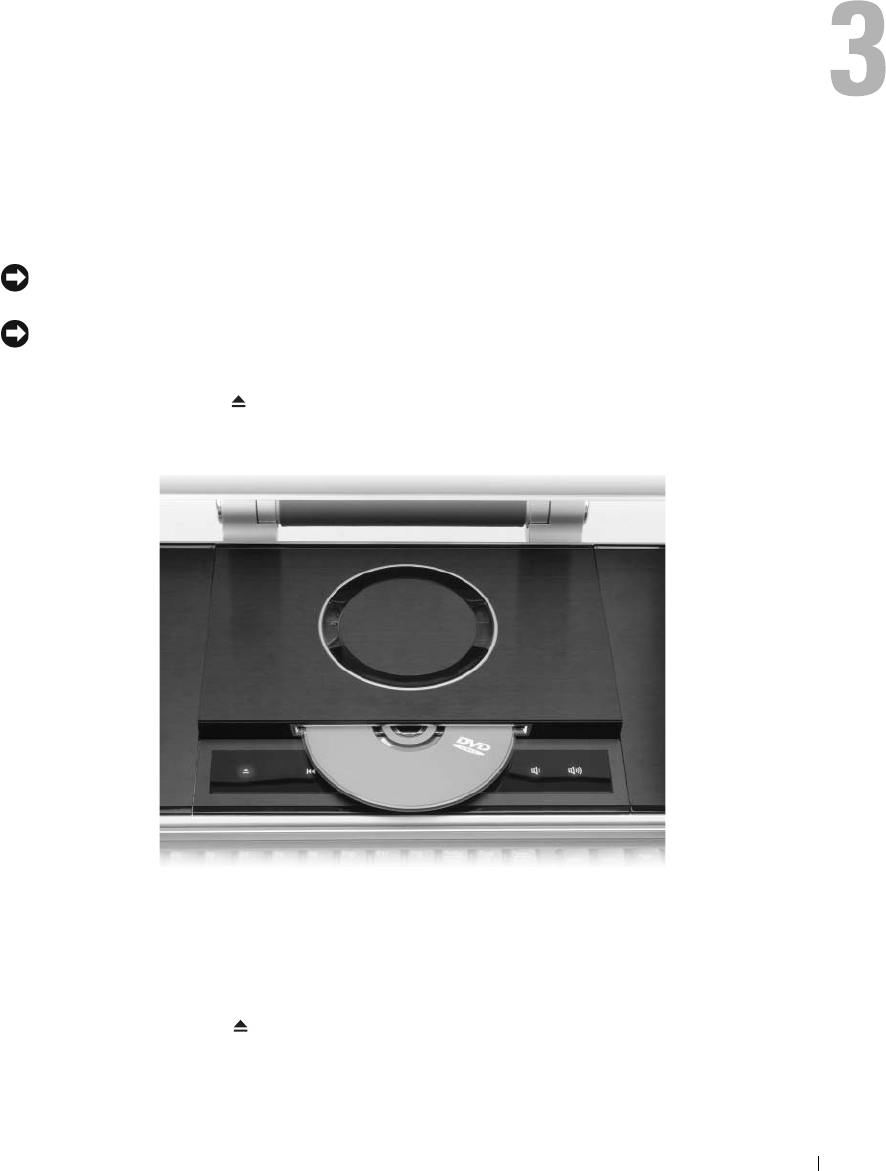
Using Multimedia 39
Using Multimedia
Playing CDs or DVDs
NOTICE: Do not press down on the DVD drive when you open or close it. Keep the tray closed when you are
not using the drive. Do not block the drive from opening fully.
NOTICE: Do not move the computer while playing CDs or DVDs.
To play a CD or DVD:
1
Press the eject button on the media button panel in front of the DVD drive. The drive will
raise up exposing the slot.
2
Holding the disc by its outside edges, carefully insert the disc into the slot with the label side
facing up.
3
Carefully push the disc into the drive until the drive takes up the disc. The drive will retract itself.
To remove the disc from the drive:
1
Press the eject button on the media button panel in front of the DVD drive. The drive will
raise up and eject the disc.
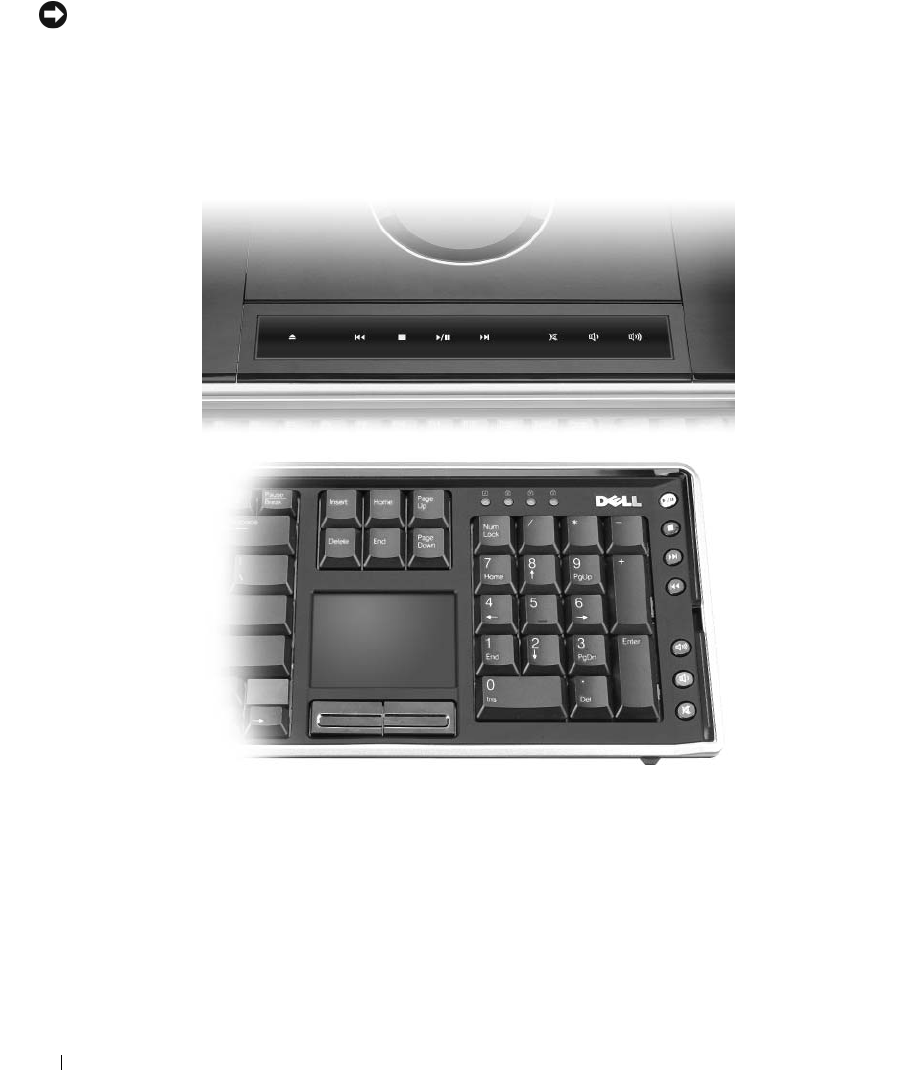
40 Using Multimedia
2
Remove the disc.
NOTICE: Do not manually push the drive down.
3
Push the eject button to retract the drive. If you wait 30 seconds, the drive will retract itself.
To format discs for storing data, to create music discs, or to copy discs, see the software that came with
your computer.
The media player includes the following basic buttons to control CD and DVD playback:

Using Multimedia 41
Adjusting the Volume
NOTE: When the speakers are muted, you do not hear the CD or DVD playing.
In addition to using the media control buttons to adjust the volume, you can also adjust the volume in
the following way:
1
Click
Start
→
All Programs
→
Accessories
→
Entertainment
→
Volume Control
.
2
Click and drag the bar in the
Volume Control
column and slide it up or down to increase or decrease
the volume.
For additional volume control options, click Help in the Volume Control window.
The Volume Meter displays the current volume level, including mute, on your computer. Either click the
icon in the taskbar and select or deselect Disable On Screen Volume Meter, or press the volume
control buttons to enable or disable the Volume Meter on the screen.
Press to open or close the DVD drive. If media is present in the closed
drive, pressing this button will open the drive and eject the media.
Press once to go back to the start of the current playing track/chapter.
Press multiple times to skip back to previous track/chapters. Press and
hold to rewind within the current track/chapter.
Press to stop the CD or DVD.
Press once to skip forward one track/chapter. Press multiple times to skip
forward multiple tracks/chapters. Press and hold to fast-forward within the
current track/chapter.
Press once to skip forward one track/chapter. Press multiple times to skip
forward multiple tracks/chapters. Press and hold to fast-forward within the
current track/chapter.
Press to turn off the volume of audio output from internal or external
speakers.
Press to decrease the volume of audio output from internal or external
speakers.
Press to increase the volume of audio output from internal or external
speakers.
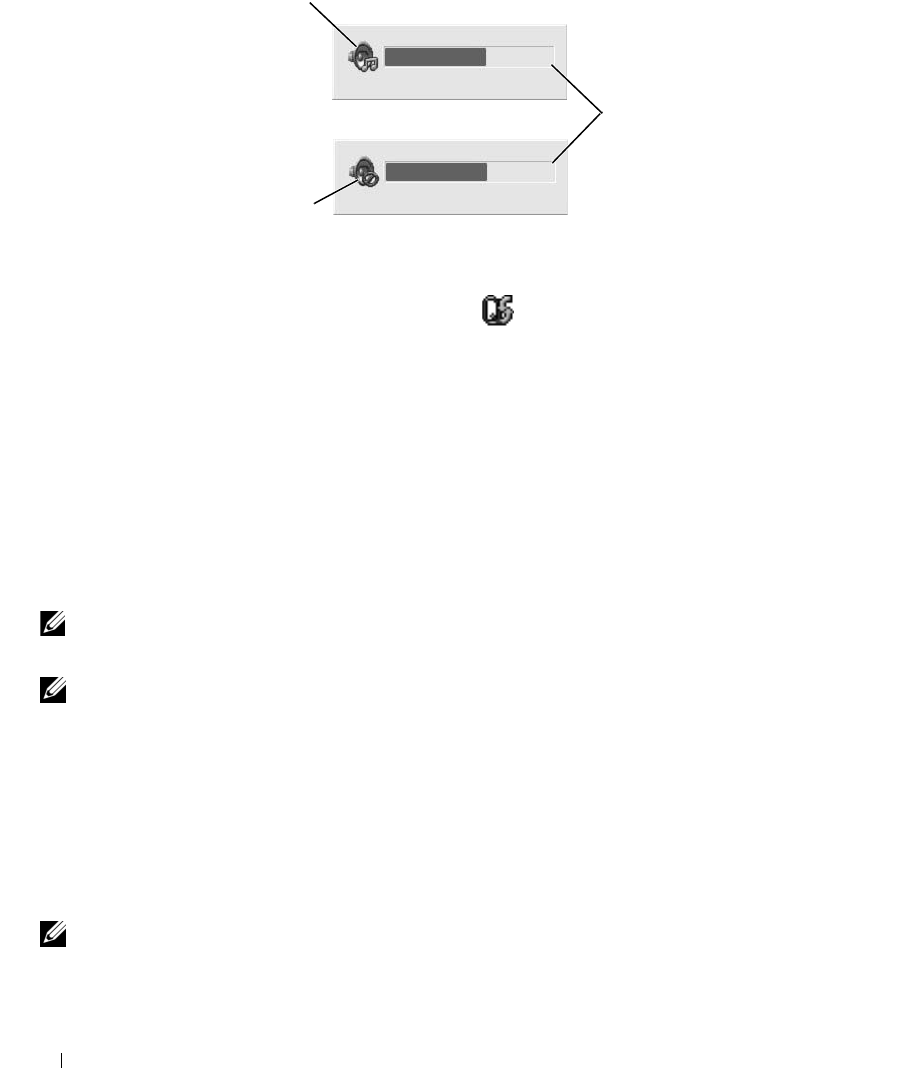
42 Using Multimedia
For more information about QuickSet, right-click the icon in the taskbar and click Help.
Adjusting the Picture
If an error message notifies you that the current resolution and color depth are using too much memory
and preventing DVD playback, adjust the display properties.
1
Click
Start
→
Control Panel
→
Display
→
Settings
.
2
Under
Screen resolution
, click and drag the bar to reduce the resolution setting.
3
In the drop-down menu under
Color quality
, click
Medium (16 bit)
→
OK
.
Copying CDs and DVDs
NOTE: Ensure that you observe all copyright laws when creating CDs or DVDs.
This section applies only to computers that have a DVD+/-RW drive.
NOTE: The types of CD or DVD drives offered by Dell may vary by country.
The following instructions explain how to make an exact copy of a CD or DVD using Roxio Creator Plus
- Dell Edition. You can also use Roxio Creator Plus for other purposes, such as creating music CDs from
audio files stored on your computer or backing up important data. For help, open Roxio Creator Plus,
and then click the question mark icon in the upper-right corner of the window.
How to Copy a CD or DVD
The DVD-writable drives installed in Dell™ computers can write to and read DVD+/-R, DVD+/-RW
and DVD+R DL (dual layer) media, but cannot write to and may not read DVD-RAM media.
NOTE: Most commercial DVDs have copyright protection and cannot be copied using Roxio Creator Plus.
1
Click
Start
→
All Programs
→
Roxio
→
Creator Projects
, and click
RecordNow Copy
.
2
On the
Copy
tab, click
Disc Copy
.
1volume icon 2Volume Meter 3mute icon
1
3
2

Using Multimedia 43
3
To copy the CD or DVD:
•
If you have one CD or DVD drive
, ensure that the settings are correct and click the
Disc Copy
button. The computer reads your source CD or DVD and copies the data to a temporary folder on
your computer hard drive.
When prompted, insert a blank CD or DVD into the drive and click
OK
.
•
If you have two CD or DVD drives
, select the drive into which you have inserted your source CD or
DVD and click the
Disc
Copy
button. The computer copies the data from the source CD or DVD
to the blank CD or DVD.
Once you have finished copying the source CD or DVD, the CD or DVD that you have created
automatically ejects.
Using Blank CDs and DVDs
DVD-writable drives can write to both CD and DVD recording media.
Use blank CD-Rs to record music or permanently store data files. After creating a CD-R, you cannot
write to that CD-R again (see the Sonic documentation for more information). Use blank CD-RWs to
write to CDs or to erase, rewrite, or update data on CDs.
Blank DVD+/-Rs can be used to permanently store large amounts of information. After you create a
DVD+/-R disc, you may not be able to write to that disc again if the disc is "finalized" or "closed" during
the final stage of the disc creation process. Use blank DVD+/-RWs if you plan to erase, rewrite, or
update information on that disc later.
CD-Writable Drives
DVD-Writable Drives
Media Type Read Write Rewritable
CD-R Yes Yes No
CD-RW Yes Yes Yes
Media Type Read Write Rewritable
CD-R Yes Yes No
CD-RW Yes Yes Yes
DVD+R Yes Yes No
DVD-R Yes Yes No
DVD+RW Yes Yes Yes
DVD-RW Yes Yes Yes
DVD+R DL Yes Yes No

44 Using Multimedia
Helpful Tips
• Use Microsoft
®
Windows
®
Explorer to drag and drop files to a CD-R or CD-RW only after you start
Roxio Creator Plus
and open a Creator project.
• Use CD-Rs to burn music CDs that you want to play in regular stereos. CD-RWs do not play in most
home or car stereos.
• You cannot create audio DVDs with
Roxio Creator Plus
.
• Music MP3 files can be played only on MP3 players or on computers that have MP3 software installed.
• Commercially available DVD players used in home theater systems may not support all available DVD
formats. For a list of formats supported by your DVD player, see the documentation provided with your
DVD player or contact the manufacturer.
• Do not burn a blank CD-R or CD-RW to its maximum capacity; for example, do not copy a 650-MB
file to a blank 650-MB CD. The CD-RW drive needs 1–2 MB of the blank space to finalize the
recording.
• Use a blank CD-RW to practice CD recording until you are familiar with CD recording techniques. If
you make a mistake, you can erase the data on the CD-RW and try again. You can also use blank
CD-RWs to test music file projects before you record the project permanently to a blank CD-R.
• See the Roxio website at
www.sonic.com
for additional information.
Using Dell Media Experience and Dell MediaDirect
NOTE: Changing or disabling the Dell QuickSet default settings can limit Dell MediaDirect™ functionality. For more
information about Dell QuickSet, see "Dell QuickSet" on page 139.
Press the Dell MediaDirect button, located next to the power button, to launch either Windows Media
Center Manager or Dell MediaDirect.
If the computer is turned on or in standby mode
If you press the Dell MediaDirect button while the computer is turned on or in standby mode, either
Windows XP Media Center Manager or Dell Media Experience™ launches, depending on your system
setup. If both applications are present, Windows XP Media Center Manager launches.
NOTE: If both Microsoft Windows XP Media Center Edition and Dell Media Experience are installed on your
computer, you must launch Dell Media Experience. Click Start
→
All Programs or click the Media Experience icon
on the desktop.
DVD-R DL Yes No No
DVD-RAM Maybe No No
Media Type Read Write Rewritable
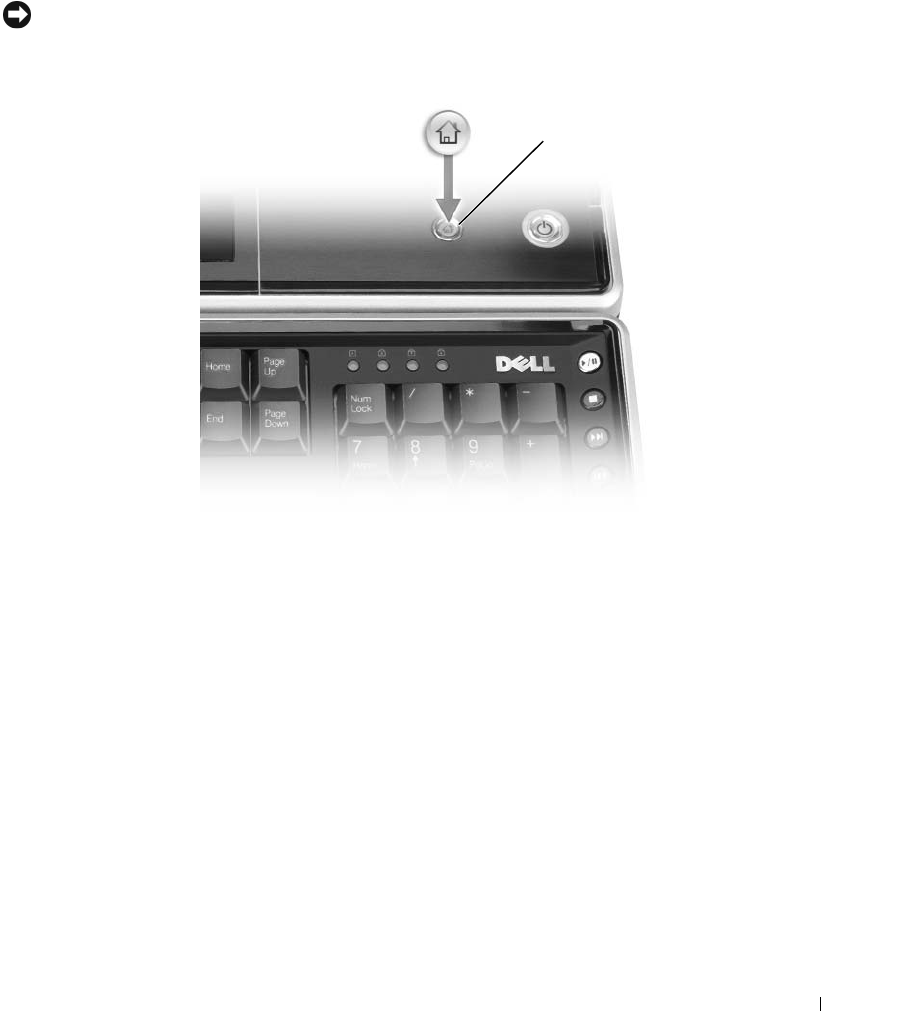
Using Multimedia 45
If the computer is turned off or in hibernate mode
When your computer is turned off or in hibernate mode, you can press the Dell MediaDirect button to
start the computer and automatically launch the Dell MediaDirect application.
NOTE: You cannot reinstall the Dell Media Experience or Dell MediaDirect feature if you voluntarily reformat the
hard drive. You need the installation software to reinstall the media applications. Contact Dell for assistance. See
"Contacting Dell" on page 154.
Dell MediaDirect and Dell Media Experience Help
The Dell media application on your computer provides help information. When you launch the media
application, click on the desktop icon for additional help.
Using Your Computer With a TV or Audio Device
Use the adapters that came with your Dell computer to connect various electronic devices to your
computer:
• Composite video adapter
• Component video adapter
• Audio/IR Blaster adapter
1Dell MediaDirect button
1
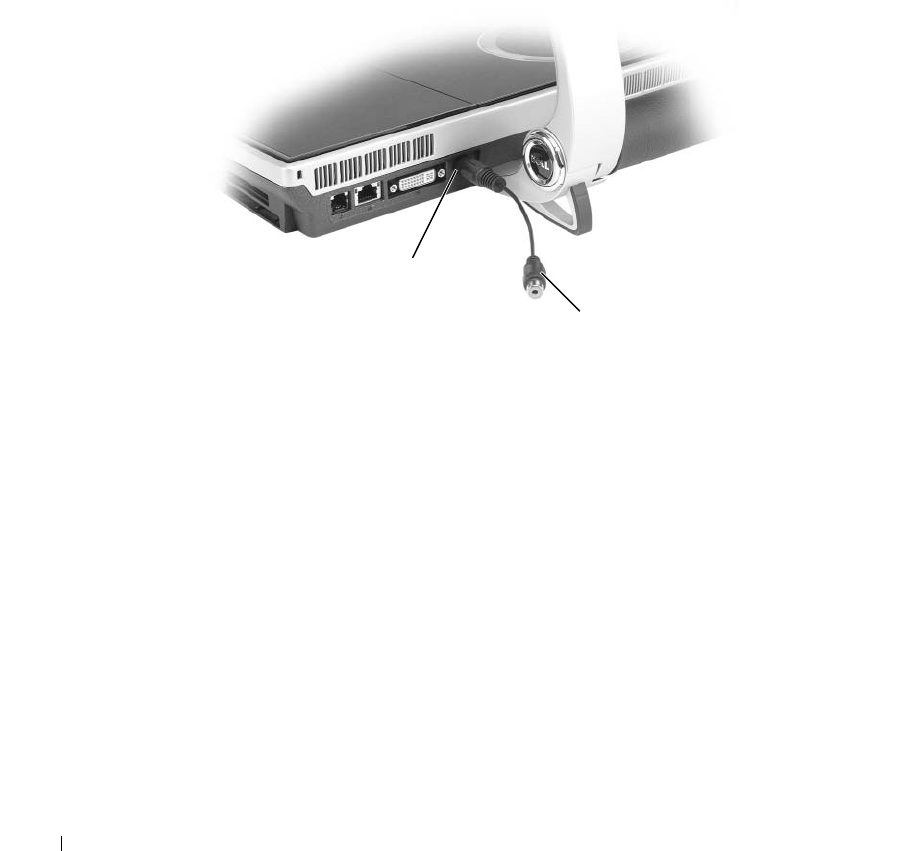
46 Using Multimedia
Your computer has an S-video TV-out connector that, together with a standard S-video cable, a
composite video adapter cable, or a component video adapter cable, enables you to connect the
computer to a TV. You want to use the best input that your display or TV will support. The best options
are DVI and component. There are arguments for either one, depending on the exact display or TV type.
If neither one of these connectors is supported, then S-Video or composite are the alternate options.
The following section discusses the various adapters you received and possible configurations, depending
on the device you want to connect.
Connecting a Composite Video Adapter
Use the composite video adapter to connect:
• Standard definition TV
•VCR
•DVR
1s-video TV-out connector 2composite video adapter
2
1
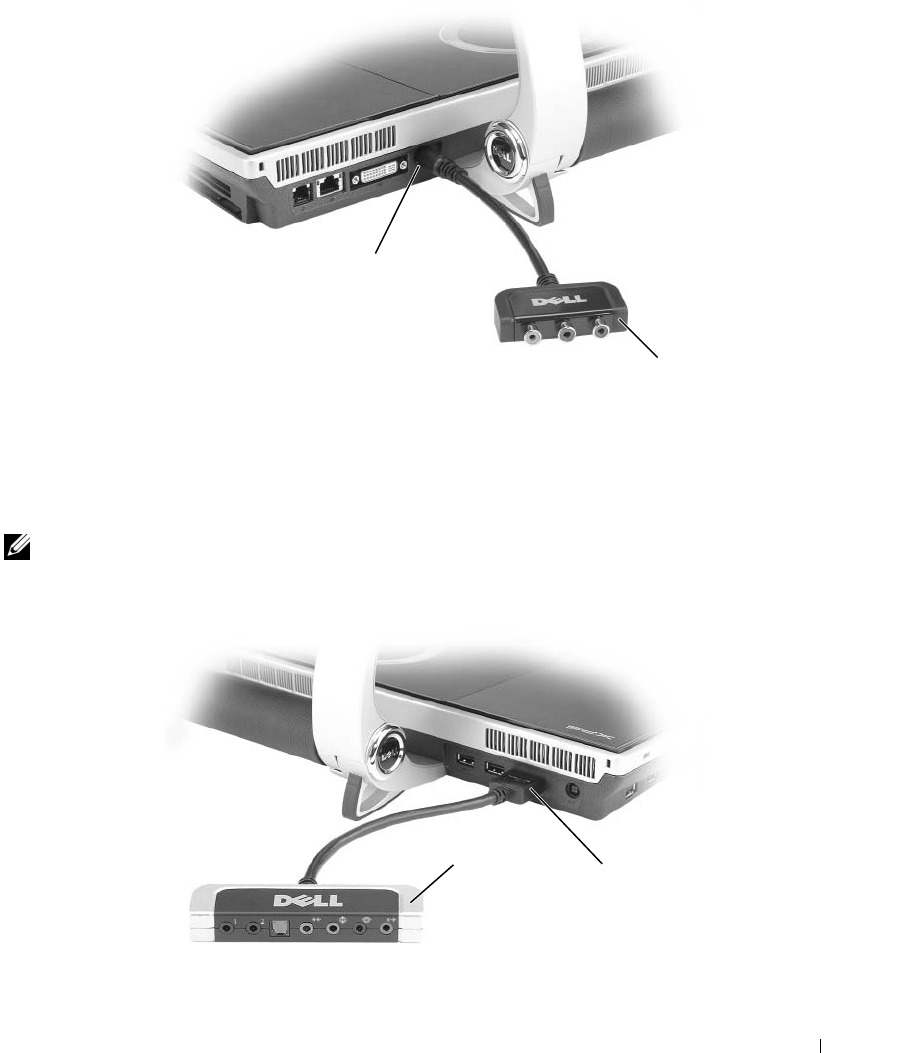
Using Multimedia 47
Connecting a Component Video Adapter
Use the component video adapter to connect:
• High definition TV
• High definition DVR or DVD player
NOTE: If your TV has a DVI-I connector, use the DVI-I connector instead of the component adapter.
Connecting Audio/IR Blaster Adapter
1s-video TV-out connector 2component video adapter
1audio/IR blaster adapter 2audio connector
2
1
12
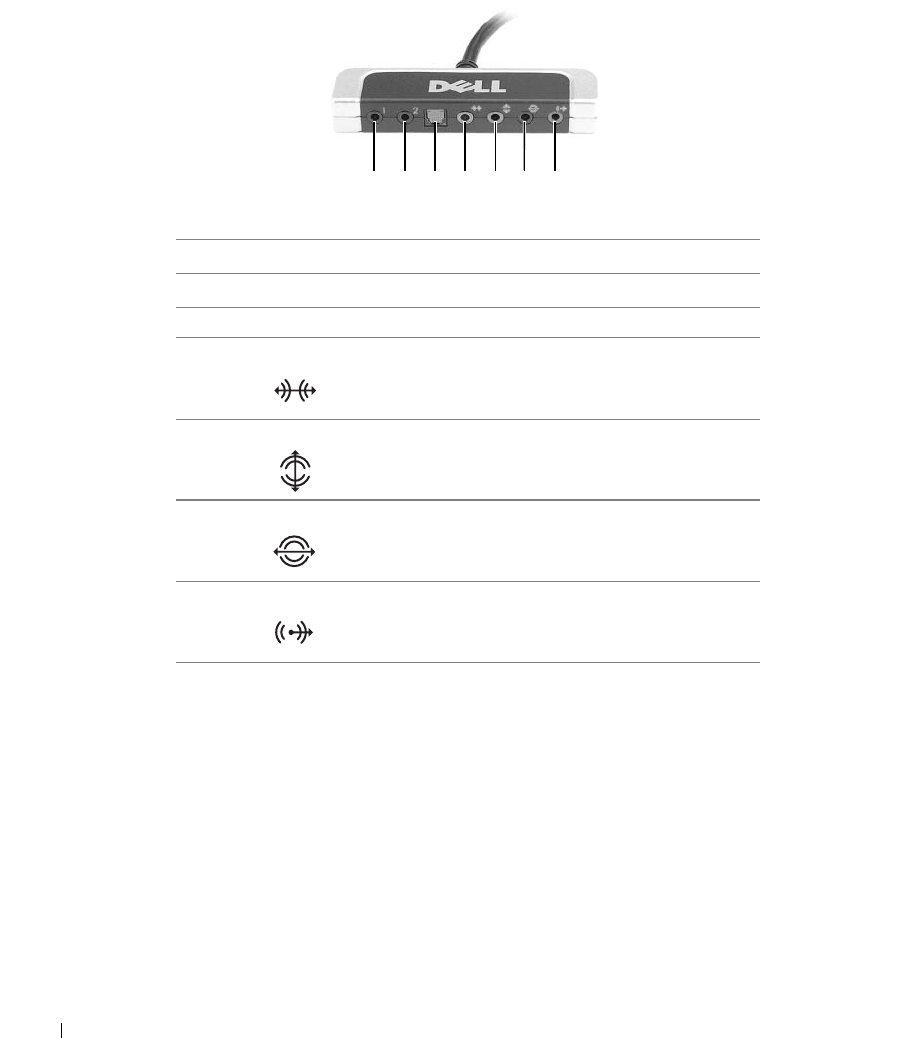
48 Using Multimedia
The audio/IR blaster adapter has the following ports:
The IR blaster output ports are used by Windows Media Center to remotely control these external
consumer electronics devices:
• Satellite box
• Cable box
•VCR
The Digital S/PDIF output (TOSLINK optical connection) port is used to connect:
• Home theatre receivers
• Minidisk players
• High-end digital decoding 5.1 speakers
11IR blaster port black
22IR blaster port black
3S/PDIF digital S/PDIF port
4 side L/R output connector gray
5 center/sub output connector orange
6 rear L/R output connector black
7 front L/R output connector lime green
1234567

Using Multimedia 49
The multi-channel analog audio I/O ports are used to connect:
•7.1 speakers
• 5.1 speakers with line input
• Monaural/stereo microphones
• External audio sources
• MP3 players
• Tape decks
NOTE: Some video and audio cables for connecting your computer to a TV or other audio device may not be
included with your computer. Cables and TV/digital audio adapter cables are available for purchase from Dell.
Enabling S/PDIF Digital Audio
You can enable digital audio for DVD playback on your computer.
1
Click
Start
, point to
All
Programs
, and click
PowerDVD
to launch the
Cyberlink PowerDVD
application.
2
Insert a DVD into the DVD drive.
If the DVD begins playing, click the stop button.
3
Click the
Settings
option.
4
Click the
DVD
option.
5
Click the
DVD Audio Setting
icon.
6
Click the arrows beside the
Speaker Configuration
setting to scroll through the options, and select the
SPDIF
option.
7
Click the
Back
button once, and then click the
Back
button again to return to the main menu screen.
Enabling S/PDIF in the Windows Audio Driver
1
Double-click the speaker icon in the Windows notification area.
2
Click the
Options
menu and then click
Advanced Controls
.
3
Click
Advanced
.
4
Click
S/PDIF Interface
.
5
Click
Close
.
6
Click
OK
.

50 Using Multimedia
Setting Up the Cyberlink (CL) Headphones
NOTE: The CL headphone feature is available only if your computer has a DVD drive.
If your computer has a DVD drive, you can enable digital audio for DVD playback.
1
Click
Start
, point to
All Programs
, and click
PowerDVD
to launch the
Cyberlink PowerDVD
program.
2
Insert a DVD into the DVD drive.
If the DVD begins playing, click the stop button.
3
Click the
Settings
option.
4
Click the
DVD
option.
5
Click the
DVD Audio Setting
icon.
6
Click the arrows beside the
Speaker Configuration
setting to scroll through the options, and select the
Headphones
option.
7
Click the arrows beside the
Audio listening mode
setting to scroll through the options, and select the
CL Headphone
option.
8
Click the arrows beside the
Dynamic range compression
option to select the most suitable option.
9
Click the
Back
button once, and then click the
Back
button again to return to the main menu screen.
Enabling the Display Settings for a TV
NOTE: To ensure that the display options appear correctly, connect the TV to the computer before you enable the
display settings.
1
Click the
Start
button, point to
Settings
, and then click
Control Panel
.
2
Double-click
Display
and click the
Settings
tab.
3
Click
Advanced
.
4
Click the tab for your video card.
NOTE: To determine the type of video card installed in your computer, see the Windows Help and Support Center.
To access the Help and Support Center, click Start → Help and Support. Under Pick a Task, click Use Tools to view
your computer information and diagnose problems. Then, under My Computer Information, select Hardware.
5
In the display devices section, select the appropriate option for using either a single display or multiple
displays, ensuring that the display settings are correct for your selection.
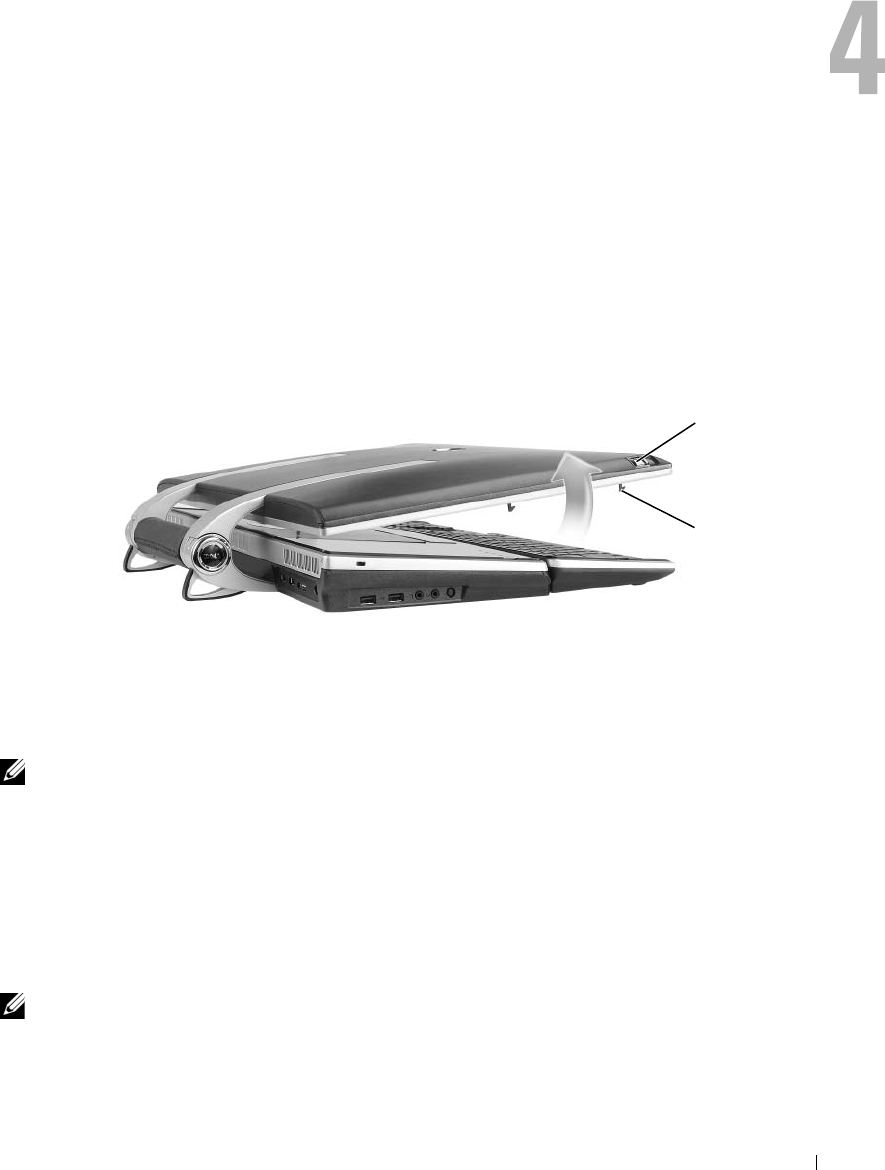
Using the Display 51
Using the Display
Opening the Display Panel
1
Slide the two display latch releases, one on each side of the back of the display panel, toward the
front of the computer to release the four display latches.
Two latches are holding the display panel to the computer base and two latches are holding the
display panel to the keyboard.
2
Raise the display panel to open the computer. As you raise the display panel, the four latches will
retract into the display panel.
NOTE: If the system battery is drained and there is no power source, the latches will not retract.
Closing the Display Panel
1
Before closing the display panel, ensure that the keyboard is firmly secured against the computer
base.
2
Slowly lower the display panel toward the computer base. As you lower the display panel, the four
display latches will emerge from the display panel to secure the display to the computer base and
keyboard.
NOTE: If the system battery is drained and there is no power source, the latches will not automatically
emerge, but you can manually activate them by sliding the display latch release buttons forward.
1display latch release (2) 2display latch (4)
2
1
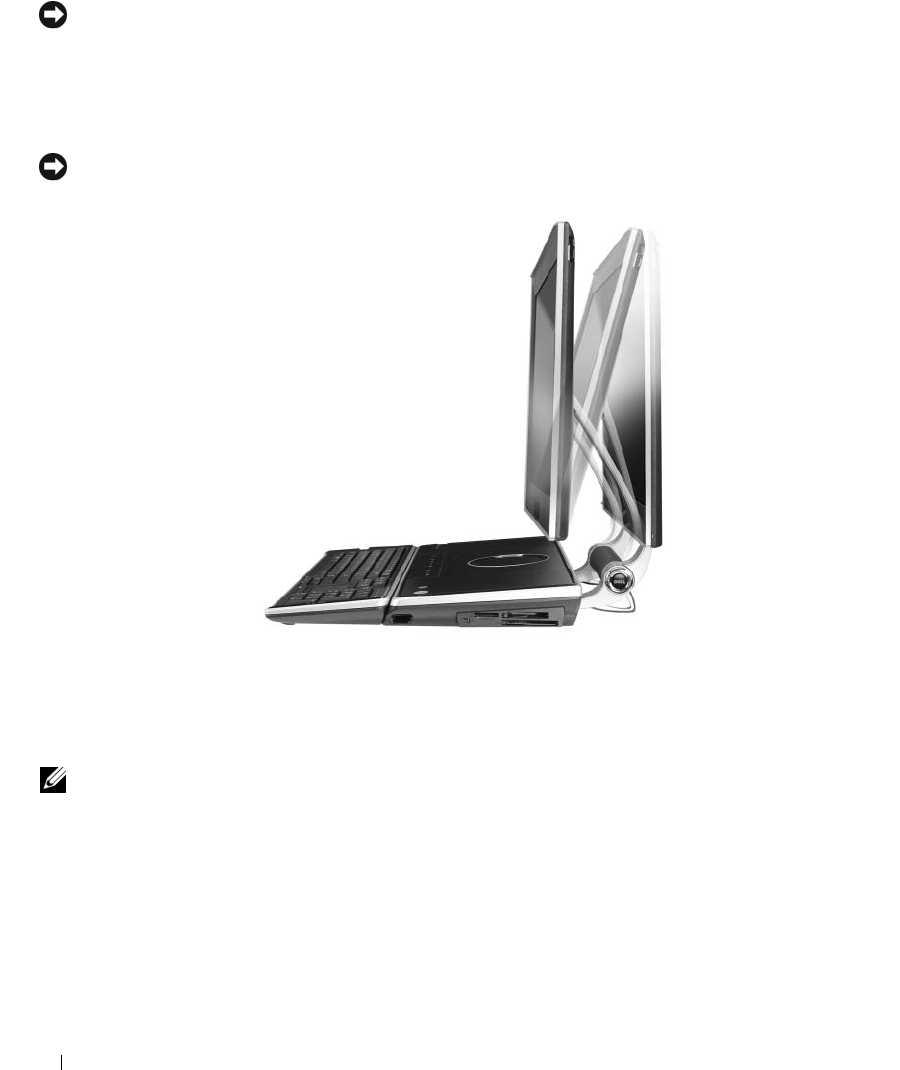
52 Using the Display
3
Firmly close the lid so all four latches are engaged.
NOTICE: Ensure that all four latches are engaged securely before picking up the computer to move it or the
keyboard could fall and be damaged.
Adjusting the Display Panel
The display on your computer is adjustable, so you can find a viewing angle that is comfortable for you.
NOTICE: Do not position the display so that it blocks the DVD drive from opening completely.
Adjusting Brightness
When a Dell™ computer is running on battery power, you can conserve power by setting the brightness
to the lowest comfortable setting by pressing <Fn> and the up- or down-arrow key on the keyboard.
NOTE: Brightness key combinations only affect the display on your portable computer, not monitors or projectors
that you attach to your portable computer or docking device. If your computer is connected to an external monitor
and you try to change the brightness level, the Brightness Meter may appear, but the brightness level on the
external device does not change.
You can press the following keys to adjust display brightness:
• Press <Fn> and the up-arrow key to increase brightness on the integrated display only (not on an
external monitor).
• Press <Fn> and the down-arrow key to decrease brightness on the integrated display only (not on an
external monitor).

Using the Display 53
Switching the Video Image
When you start the computer with an external device (such as an external monitor or projector)
attached and turned on, the image may appear on either the computer display or the external device.
Press <Fn><F8> to switch the video image between the display only, the external device only, or the
display and the external device simultaneously. Highlight your display choice and the display is selected
when you release the keys.
Setting Display Resolution and Refresh Rate
NOTE: If you change the display resolution from the current settings, the image may appear blurry or text may be
hard to read. Before you change any of the display settings, make a note of the current settings for future
reference.
To display a program at a specific resolution, both the graphics card and the display must support the
program, and the necessary video drivers must be installed.
NOTE: Use only the Dell-installed video drivers, which are designed to offer the best performance with your Dell-
installed operating system.
If you choose a resolution or color palette that is higher than the display supports, the settings adjust
automatically to the closest supported values.
1
Click
Start
→
Control Panel
→
Display
.
2
In the
Display Properties
window, click the
Settings
tab.
3
Try different settings for
Color quality
and
Screen resolution
.
NOTE: As the resolution increases, icons and text appear smaller on the screen.
If the video resolution setting is higher than that supported by the display, the computer enters pan
mode. In pan mode, the entire screen cannot be displayed at one time. For example, the taskbar that
usually appears at the bottom of the desktop may no longer be visible. To view the rest of the screen, use
the touch pad to pan up, down, left, and right.
NOTICE: You can damage an external monitor by using an unsupported refresh rate. Before adjusting the refresh
rate on an external monitor, see the user’s guide for the monitor.
Dual Independent Display Mode
You can attach an external monitor or projector to your computer and use it as an extension of your
display (known as "dual independent display" or "extended desktop" mode). This mode allows you to use
both screens independently and drag objects from one screen to the other, effectively doubling the
amount of viewable work space.
1
Connect the external monitor, TV, or projector to the computer.
2
Click
Start
→
Control Panel
→
Display
.
3
In the
Display Properties
window, click the
Settings
tab.

54 Using the Display
NOTE: If you choose a resolution or color palette that is higher than the display supports, the settings adjust
automatically to the closest supported values. For more information, see your operating system documentation.
4
Click the monitor 2 icon, click the
Extend my Windows desktop...
check box, and then click
Apply
.
5
Change
Screen Area
to the appropriate sizes for both displays and click
Apply
.
6
If prompted to restart the computer, click
Apply the new color setting without restarting
and
click
OK
.
7
If prompted, click
OK
to resize your desktop.
8
If prompted, click
Yes
to keep the settings.
9
Click
OK
to close the
Display Properties
window.
To disable dual independent display mode:
1
Click the
Settings
tab in the
Display Properties
window.
2
Click the monitor 2 icon, uncheck the
Extend my Windows desktop...
option, and then click
Apply
.
If necessary, press <Fn><F8> to bring the screen image back to the computer display.
Swapping Primary and Secondary Displays
To swap your primary and secondary display designations (for example, to use your external monitor as
your primary display):
1
Click
Start
→
Control Panel
→
Display
.
2
Click the
Settings
tab
→
Advanced
→
Identify
.
See the documentation that came with your video card for additional information.
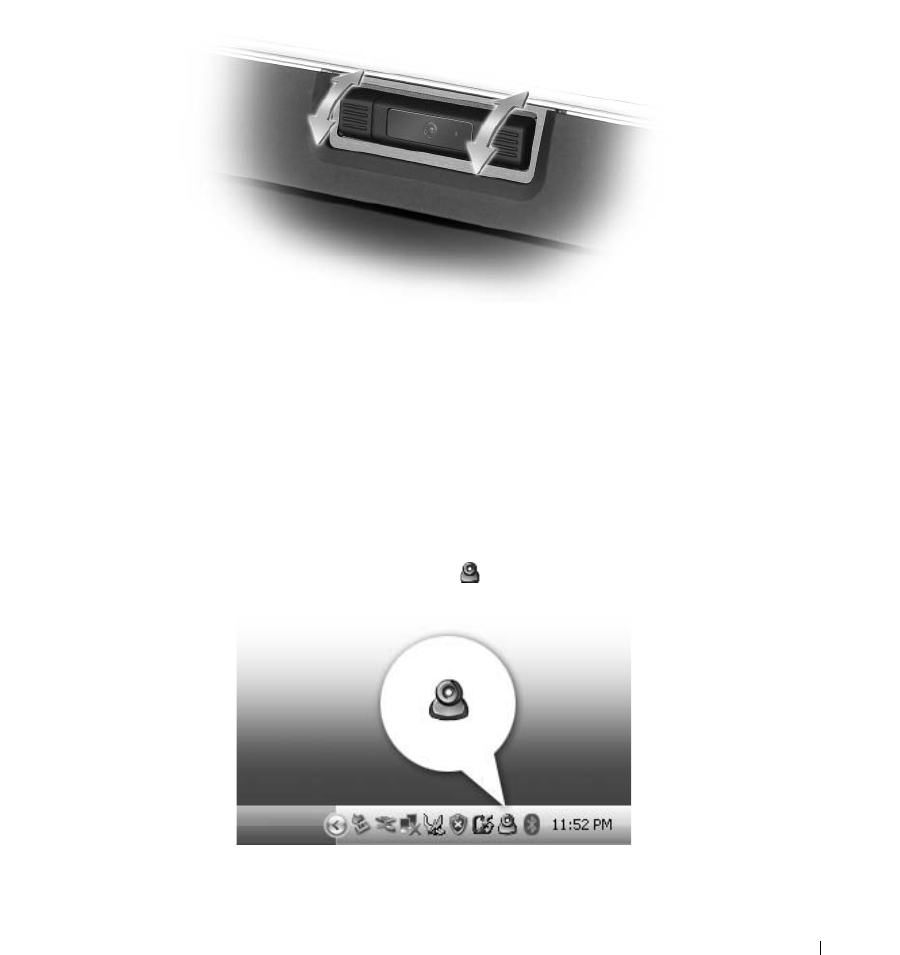
Using the Display 55
Using the Camera
Your computer has a camera integrated into the display panel. The camera allows you to take photos and
videos and to communicate visually with other computer users. The tilt of the camera is manually
adjustable. For more information, see "Specifications" on page 141.
Setting Up the Camera
To set up your camera, see the printed camera Setup Guide that shipped with your computer. For
additional information on using your camera, see the camera Help file.
Accessing Help
To access the camera Help file:
1
Click
Start
→
All Programs
→
Logitech
→
Logitech QuickCam
.
2
Then click
QuickCapture
→
Help
.
You can also access Help from the Logitech Video icon in the system tray.
Click the icon and select Help from the menu.

56 Using the Display
Taking a Picture or Recording a Video
To take a picture:
1
Click the Logitech Video icon in the system tray.
2
Select
QuickCapture
from the menu.
The
QuickCapture
window displays and the blue LED on the camera turns on. You are able to view
yourself on the camera through the
QuickCapture
window.
3
To take a picture, click
TakeaPicture
. To record a video, click
RecordaVideo
.
4
Your picture or video will be saved by default in the My Pictures folder of My Documents unless you
change the settings.
5
For more information, see the Logitech Video Help. See "Accessing Help" on page 55.
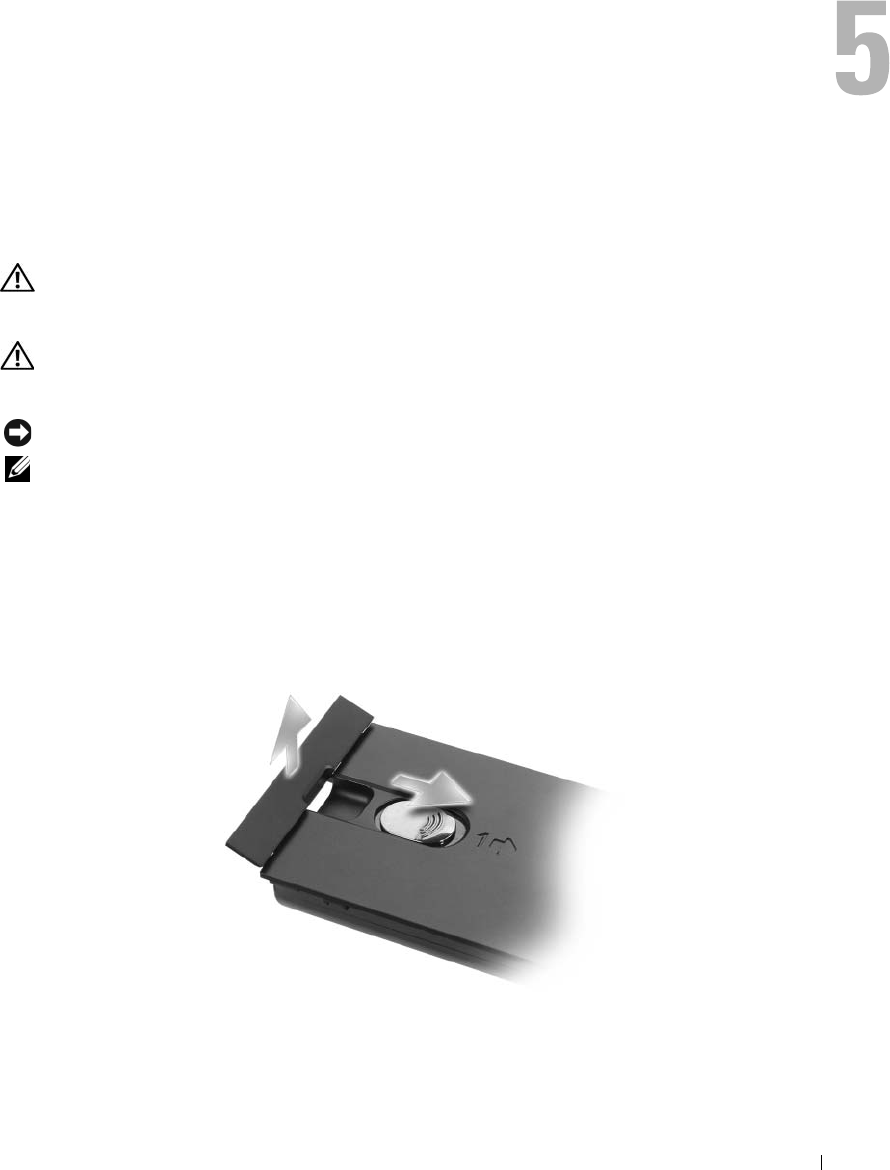
Using a Battery 57
Using a Battery
Replacing the Battery
CAUTION: Using an incompatible battery may increase the risk of fire or explosion. Replace the battery
only with a compatible battery purchased from Dell. The battery is designed to work with your Dell™
computer. Do not use a battery from other computers with your computer.
CAUTION: Before performing these procedures, turn off the computer, disconnect the AC adapter from the
electrical outlet and the computer, disconnect the modem from the wall connector and computer, and
remove any other external cables from the computer.
NOTICE: You must remove all external cables from the computer to avoid possible connector damage.
NOTE: The Service Tag label is located inside the battery compartment of your computer.
Inserting the Battery
1
Ensure the keyboard is securely attached and the display is closed and latched before turning the
computer over. See "Closing the Display Panel" on page 51. Then place the computer upside down
on a clean flat surface.
2
Push the latch release button (#1) on the battery to open the battery access door.
3
Insert the battery straight down into the battery compartment with the battery access door in the
open position.
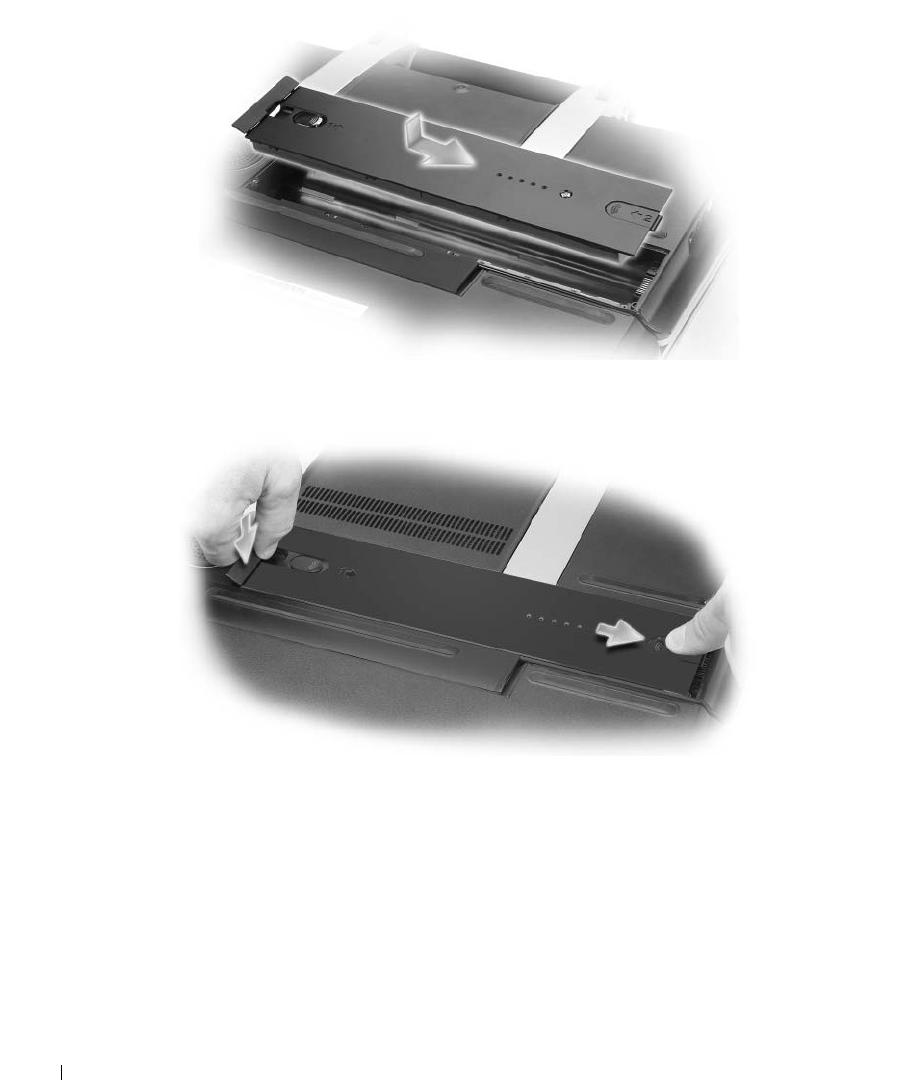
58 Using a Battery
4
Slide the battery in the direction of the #1 arrow until it snaps into place.
5
Close the battery access door by pushing it down with your finger.
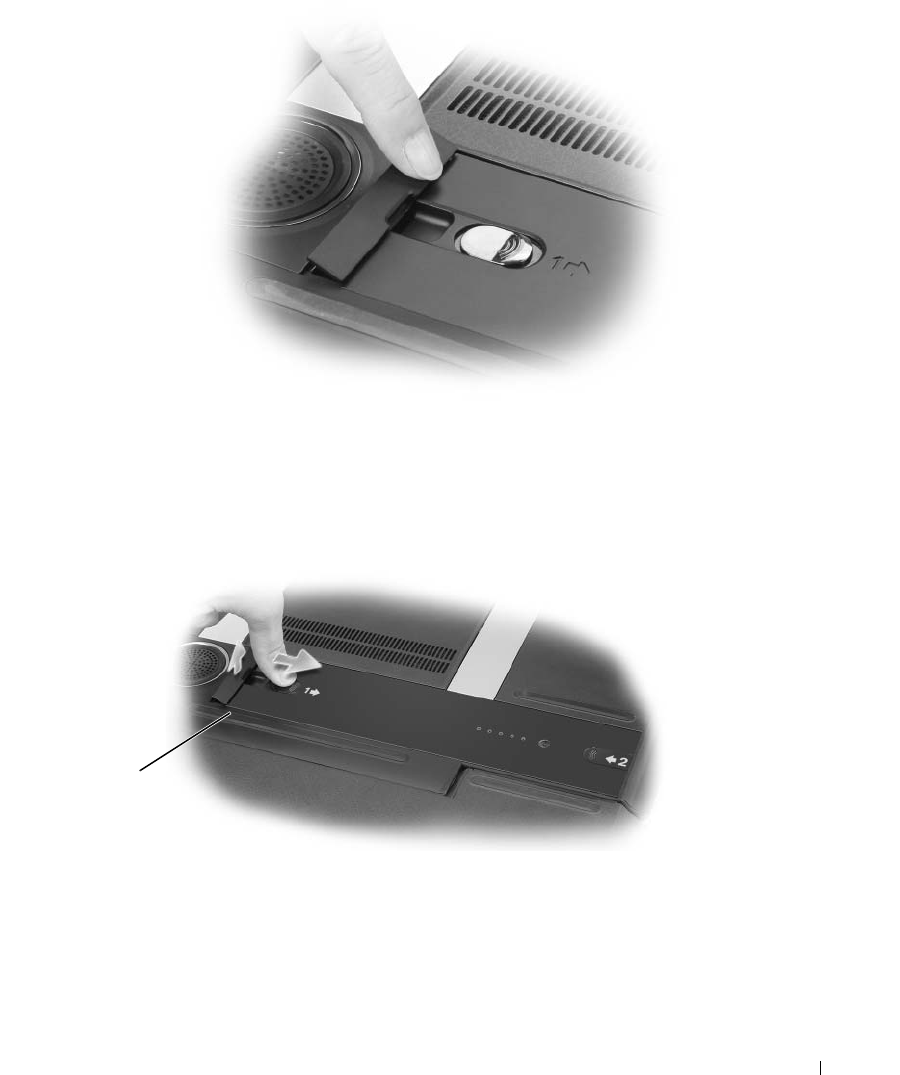
Using a Battery 59
Removing the Battery
1
Ensure that the computer is turned off.
2
Slide the battery latch release on the bottom of the computer in the direction of the #1 arrow. The
battery access door will pop up.
1battery access door
1
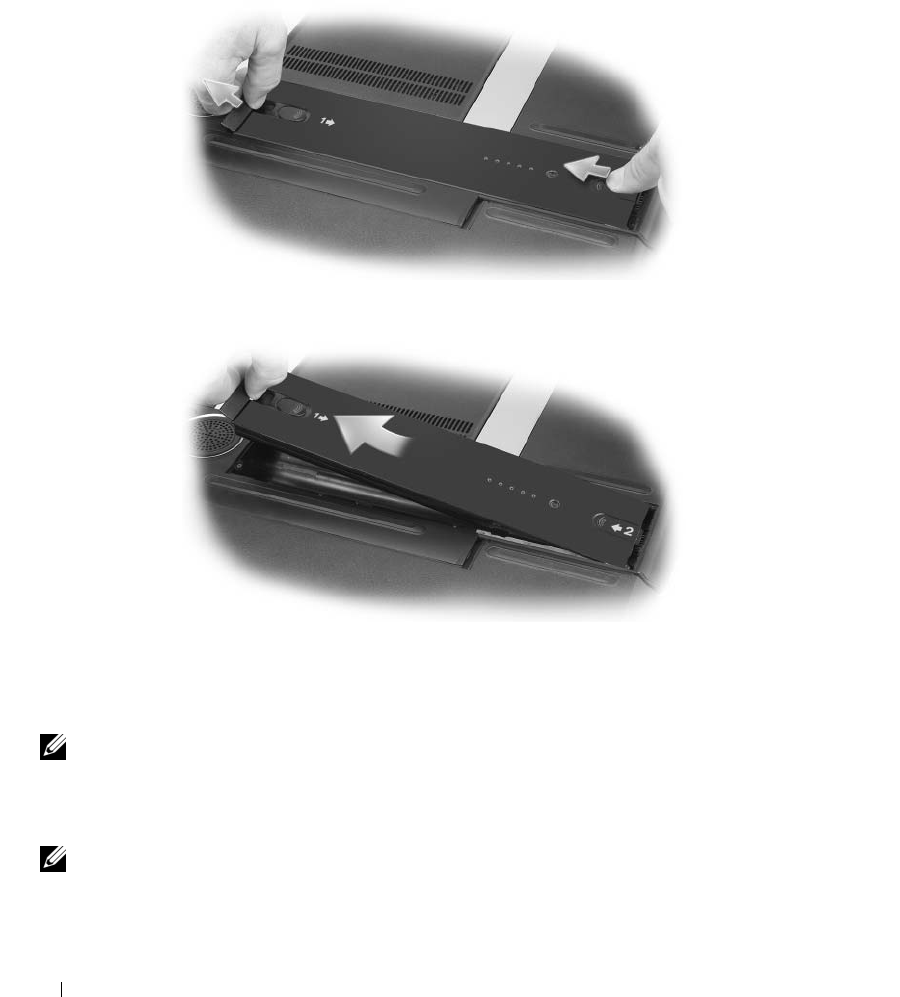
60 Using a Battery
3
Using your thumbs, slide the battery in the direction of the #2 arrow by inserting one thumb into the
recess next to the battery access door and the other thumb into the indention surrounding the #2
arrow.
4
Lift the battery straight up and out of the computer.
Battery Performance
NOTE: For information about the Dell warranty for your computer, see the Product Information Guide or separate
paper warranty document that shipped with your computer.
For optimal computer performance and to help preserve BIOS settings, operate your Dell portable
computer with the main battery installed at all times. One battery is supplied as standard equipment.
NOTE: Because the battery may not be fully charged, use the AC adapter to connect your new computer to an
electrical outlet the first time you use the computer. For best results, operate the computer with the AC adapter
until the battery is fully charged. To view battery charge status, go to Control Panel→ Performance and
Maintenance→ Power Options→ Power Meter.

Using a Battery 61
Battery operating time varies depending on operating conditions.
NOTE: Battery operating time (the time the battery can hold a charge) decreases over time. Depending on how
often the battery is used and the conditions under which it is used, you may need to purchase a new battery during
the life of your computer.
NOTE: It is recommended that you connect your computer to an electrical outlet when writing to a CD or DVD.
Battery operating time varies depending on operating conditions. Operating time is significantly reduced
when you perform operations including, but not limited to, the following:
• Using optical drives
• Using wireless communications devices, PC Cards, ExpressCards, media memory cards, or USB
devices
• Using high-brightness display settings, 3D screen savers, or other power-intensive programs such as
complex 3D graphics applications
• Running the computer in maximum performance mode. See "Configuring Power Management
Settings" on page 65 for information about accessing Windows Power Options Properties or Dell
QuickSet, which you can use to configure power management settings.
You can check the battery charge before you insert the battery into the computer. See "Checking the
Battery Charge" on page 61 and "Inserting the Battery" on page 57. You can also set power management
options to alert you when the battery charge is low. See "Configuring Power Management Settings" on
page 65.
CAUTION: Using an incompatible battery may increase the risk of fire or explosion. Replace the battery only
with a compatible battery purchased from Dell. The battery is designed to work with your Dell computer. Do not
use a battery from other computers with your computer.
CAUTION: Do not dispose of batteries with household waste. When your battery no longer holds a charge, call
your local waste disposal or environmental agency for advice on disposing of a lithium-ion battery. See "Battery
Disposal" in the Product Information Guide.
CAUTION: Misuse of the battery may increase the risk of fire or chemical burn. Do not puncture, incinerate,
disassemble, or expose the battery to temperatures above 65°C (149°F). Keep the battery away from children.
Handle damaged or leaking batteries with extreme care. Damaged batteries may leak and cause personal injury
or equipment damage.
Checking the Battery Charge
The Dell QuickSet Battery Meter, the Microsoft® Windows® Power Meter window and icon, the
battery charge gauge and health gauge, and the low-battery warning provide information on the battery
charge. The Dell QuickSet Battery Meter also provides information on the keyboard battery charge
status.

62 Using a Battery
Dell QuickSet Battery Meter
If Dell QuickSet is installed, press <Fn><F3> to display the QuickSet Battery Meter window. The
Battery Meter displays the status, battery health, charge level, and charge completion time for the battery
in your computer.
For more information about QuickSet, right-click the icon in the taskbar, and click Help.
Microsoft Windows Power Meter
The Microsoft Windows Power Meter indicates the remaining battery charge. To check the Power Meter,
double-click the icon on the taskbar.
If the computer is connected to an electrical outlet, a icon appears.
Charge Gauge
By either pressing once or pressing and holding the status button on the charge gauge on the battery, you
can check:
• Battery charge (check by pressing and
releasing
the status button)
• Battery health (check by pressing and
holding
the status button)
The battery operating time is largely determined by the number of times it is charged. After hundreds of
charge and discharge cycles, batteries lose some charge capacity—or battery health. That is, a battery can
show a status of "charged" but maintain a reduced charge capacity (health).
Check the Battery Charge
To check the battery charge, press and release the status button on the battery charge gauge to illuminate
the charge-level lights. Each light represents approximately 20 percent of the total battery charge. For
example, if the battery has 80 percent of its charge remaining, four of the lights are on. If no lights
appear, the battery has no charge.
Check the Battery Health
NOTE: You can check battery health in one of two ways: by using the charge gauge on the battery as described
below and by using the Battery Meter in Dell QuickSet. For information about QuickSet, right-click the icon in
the taskbar, and click Help.
To check the battery health using the charge gauge, press and hold the status button on the battery
charge gauge for at least 3 seconds. If no lights appear, the battery is in good condition, and more than
80 percent of its original charge capacity remains. Each light represents incremental degradation. If five
lights appear, less than 60 percent of the charge capacity remains, and you should consider replacing the
battery. See "Battery" on page 144 for more information about the battery operating time.

Using a Battery 63
Low-Battery Warning
NOTICE: To avoid losing or corrupting data, save your work immediately after a low-battery warning. Then
connect the computer to an electrical outlet. If the battery runs completely out of power, hibernate mode begins
automatically.
A pop-up window warns you when the battery charge is approximately 90 percent depleted. The
computer enters hibernate mode when the battery charge is at a critically low level.
You can change the settings for the battery alarms in QuickSet or the Power Options Properties window.
See "Configuring Power Management Settings" on page 65 for information about accessing QuickSet or
the Power Options Properties window.
Charging the Battery
NOTE: When the computer is turned off, the AC adapter charges a completely discharged battery to 80 percent in
about 90 minutes. Full battery charge time will be longer. Charge time is longer with the computer turned on. You
can leave the battery in the computer for as long as you like. The battery’s internal circuitry prevents the battery
from overcharging.
When you connect the computer to an electrical outlet or install a battery while the computer is
connected to an electrical outlet, the computer checks the battery charge and temperature. If necessary,
the AC adapter then charges the battery and maintains the battery charge.
If the battery is hot from being used in your computer or being in a hot environment, the battery may
not charge when you connect the computer to an electrical outlet.
The battery is too hot to start charging if the light flashes alternately blue and orange. Disconnect
the computer from the electrical outlet and allow the computer and the battery to cool to room
temperature. Then connect the computer to an electrical outlet to continue charging the battery.
For more information about resolving problems with a battery, see "Power Problems" on page 106.
Conserving Battery Power
Perform the following actions to conserve battery power:
• Connect the computer to an electrical outlet when possible because battery life is largely determined
by the number of times the battery is used and recharged.
• Place the computer in standby mode or hibernate mode when you leave the computer unattended for
long periods of time. See "Power Management Modes" on page 64.
• Use the Power Management Wizard or the
Power Options Properties
window to select options to
optimize your computer’s power usage. These options can also be set to change when you press the
power button, close the display, or press <Fn><Esc>.
NOTE: See "Configuring Power Management Settings" on page 65 for information on conserving battery power.

64 Using a Battery
Storing a Battery
Remove the computer battery when you store your computer for an extended period of time. A battery
discharges during prolonged storage. After a long storage period, recharge the battery fully before you use
it. See "Charging the Battery" on page 63.
Power Management Modes
The power indicator LED indicates the power state of the computer. The Dell badge on the back of the
display panel indicates the power state of the computer when the computer is used in closed-lid
operation.
Standby Mode
Standby mode conserves power by turning off the display and the hard drive after a predetermined
period of inactivity (a time-out). When the computer exits standby mode, it returns to the same
operating state it was in before entering standby mode.
NOTICE: If your computer loses AC and battery power while in standby mode, it may lose data.
To enter standby mode:
• Click the
Start
button, click
Turn off computer
, and then click
Stand by
.
or
• Depending on how you set the power management options in the
Power Options Properties
window
or the QuickSet Power Management Wizard, use one of the following methods:
– Press the power button.
– Close the display.
– Press <Fn><Esc>.
To exit standby mode, press the power button or open the display, depending on how you set the power
management options. You can only make the computer exit standby mode by pressing a key or touching
the touch pad if this option has been enabled. First you must enable USB Wake Support under Power
Management in System Setup. Then right click the Bluetooth icon in the system tray, click Options,
Power State Power LED
Normal operating state Blue solid light
Low power state Blue light blinking slowly
Standby mode Blue light blinking slowly
Hibernate mode Off
Mechanically off (no AC power) Off

Using a Battery 65
select the Other tab, and select HID Profile Wakeup Setting to select the devices to wake from standby.
To wake from standby, the computer must also be connected to AC power. For more information, see
"System Setup Screens" on page 114.
Hibernate Mode
Hibernate mode conserves power by copying system data to a reserved area on the hard drive and then
completely turning off the computer. When the computer exits hibernate mode, it returns to the same
operating state it was in before entering hibernate mode.
NOTICE: You cannot remove devices while your computer is in hibernate mode.
Your computer enters hibernate mode if the battery charge level becomes critically low.
To manually enter hibernate mode:
•
C
lick the
Start
button, click
Turn off computer
, and then click
Hibernate
.
or
• Depending on how you set the power management options in the
Power Options Properties
window
or the QuickSet Power Management Wizard, use one of the following methods to enter hibernate
mode:
– Press the power button.
– Close the display.
– Press <Fn><F1>.
NOTE: Some PC Cards or ExpressCards may not operate correctly after the computer exits hibernate mode.
Remove and reinsert the card (see "Removing a Card" on page 85), or simply restart (reboot) your computer.
To exit hibernate mode, press the power button. The computer may take a short time to exit hibernate
mode. You cannot make the computer exit hibernate mode by pressing a key or touching the touch pad.
For more information on hibernate mode, see the documentation that came with your operating system.
Configuring Power Management Settings
You can use the QuickSet Power Management Wizard or Windows Power Options Properties to
configure the power management settings on your computer.
• For more information about QuickSet, right-click the icon in the taskbar and click
Help
.
• To access the
Power Options Properties
window, click the
Start
button, point to
Control Panel
→
Performance and Maintenance
, and then click
Power Options
. For information on any field in the
Power Options Properties
window, click the question mark icon on the title bar and then click on the
area where you need information.

66 Using a Battery

Setting Up Your Computer 67
Setting Up Your Computer
Connecting to the Internet
NOTE: ISPs and ISP offerings vary by country.
To connect to the Internet, you need a modem or network connection and an Internet service
provider (ISP). Your ISP will offer one or more of the following Internet connection options:
• Dial-up connections that provide Internet access through a telephone line. Dial-up connections
are considerably slower than DSL and cable modem connections.
• DSL connections that provide high-speed Internet access through your existing telephone line.
With a DSL connection, you can access the Internet and use your telephone on the same line
simultaneously.
• Cable modem connections that provide high-speed Internet access through your local cable TV
line.
If you are using a dial-up connection, connect a telephone line to the modem connector on your
computer and to the telephone wall jack before you set up your Internet connection. If you are using
a DSL or cable modem connection, contact your ISP for setup instructions.
Setting Up Your Internet Connection
To set up an Internet connection with a provided ISP desktop shortcut:
1
Save and close any open files, and exit any open programs.
2
Double-click the ISP
icon on the Microsoft
®
Windows
®
desktop.
3
Follow the instructions on the screen to complete the setup.
If you do not have an ISP icon on your desktop or if you want to set up an Internet connection with
a different ISP:
1
Save and close any open files, and exit any open programs.
2
Click the
Start
button and click
Internet Explorer
.
The
New Connection Wizard
appears.
3
Click
Connect to the Internet
.

68 Setting Up Your Computer
4
In the next window, click the appropriate option:
• If you do not have an ISP and want to select one, click
Choose from a list of Internet service
providers (ISPs)
.
• If you have already obtained setup information from your ISP but you did not receive a setup CD,
click
Set up my connection manually
.
• If you have a CD, click
Use the CD I got from an ISP
.
5
Click
Next
.
If you selected
Set up my connection manually
, continue to step 6. Otherwise, follow the instructions
on the screen to complete the setup.
NOTE: If you do not know which type of connection to select, contact your ISP.
6
Click the appropriate option under
How do you want to connect to the Internet?
, and then click
Next
.
7
Use the setup information provided by your ISP to complete the setup.
If you are having problems connecting to the Internet, see "E-Mail, Modem, and Internet Problems" on
page 96. If you cannot connect to the Internet but have successfully connected in the past, the ISP might
have a service outage. Contact your ISP to check the service status, or try connecting again later.
Transferring Information to a New Computer
The Microsoft Windows XP operating system provides a Files and Settings Transfer Wizard to move data
from a source computer to a new computer. You can transfer data, such as:
• E-mail messages
• Toolbar settings
• Window sizes
• Internet bookmarks
You can transfer the data to the new computer over a network connection, or you can store it on
removable media, such as a writable CD, for transfer to the new computer.
NOTE: For instructions on setting up a direct cable connection between two computers, go to
support.microsoft.com and search for Microsoft Knowledge Base Article #293118, titled How to Use Files and
Settings Transfer Wizard in Windows XP. This information may not be available in some countries.
For transferring information to a new computer, you must run the Files and Settings Transfer Wizard.
You can use the optional Operating System CD for this process or you can create a wizard disk with the
Files and Settings Transfer Wizard utility.
Running the Files and Settings Transfer Wizard With the Operating System CD
NOTE: This procedure requires the Operating System CD. This CD is optional and may not be included with all
computers.

Setting Up Your Computer 69
Prepare the New Computer for the File Transfer
1
Start the Files and Settings Transfer Wizard by clicking
Start
→
All Programs
→
Accessories
→
System
Tools
→
Files and Settings Transfer Wizard
.
2
When the
Files and Settings Transfer Wizard
welcome screen appears, click
Next
.
3
On the
Which computer is this?
screen, click
New Computer
and click
Next
.
4
On the
Do you have a Windows XP CD?
screen, click
I will use the wizard from the Windows XP CD
and click
Next
.
5
When the
Now go to your old computer
screen appears, go to your old or source computer. Do
not
click
Next
at this time.
Copy Data From the Old Computer
1
On the old computer, insert the Windows XP
Operating System
CD.
2
On the
Welcome to Microsoft Windows XP
screen, click
Perform additional tasks
.
3
Under
What do you want to do?
, click
Transfer files and settings
.
4
On the
Files and Settings Transfer Wizard
welcome screen, click
Next
.
5
On the
Which computer is this?
screen, click
Old Computer
and click
Next
.
6
On the
Select a transfer method
screen, click the transfer method you prefer.
7
On the
What do you want to transfer?
screen, select the items you want to transfer and click
Next
.
After the information has been copied, the
Completing the Collection Phase
screen appears.
8
Click
Finish
.
Transfer Data to the New Computer
1
On the
Now go to your old computer
screen on the new computer, click
Next
.
2
On the
Where are the files and settings?
screen, select the method you chose for transferring your
settings and files and click
Next
.
The wizard reads the collected files and settings and applies them to your new computer.
When all of the settings and files have been applied, the
Finished
screen appears.
3
Click
Finished
and restart the new computer.
Running the Files and Settings Transfer Wizard Without the Operating System CD
To run the Files and Settings Transfer Wizard without the optional Operating System CD, you must
create a wizard disk that lets you create a backup of your data files. Create the wizard disk on removable
media so that you can move it from your new computer to your old computer.

70 Setting Up Your Computer
Create a Wizard Disk
1
Start the Files and Settings Transfer Wizard by clicking
Start
→
All Programs
→
Accessories
→
System
Tools
→
Files and Settings Transfer Wizard
.
2
When the
Files and Settings Transfer Wizard
welcome screen appears, click
Next
.
3
On the
Which computer is this?
screen, click
New Computer
and click
Next
.
4
On the
Do you have a Windows XP CD?
screen, click
I want to create a Wizard Disk in the following
drive:
and click
Next.
5
Insert the removable media, such as a writable CD, and click
OK
.
6
When the disk creation completes and the
Now go to your old computer
message appears,
do not
click
Next
.
7
Go to the old computer.
Copy Data From the Old Computer
1
On the old computer, insert the wizard disk.
2
Click the
Start
button and click
Run
.
3
In the
Open
field on the
Run
window, browse to the path for
fastwiz
(on the appropriate removable
media) and click
OK
.
4
On the
Files and Settings Transfer Wizard
welcome screen, click
Next
.
5
On the
Which computer is this?
screen, click
Old Computer
and click
Next
.
6
On the
Select a transfer method
screen, click the transfer method you prefer.
7
On the
What do you want to transfer?
screen, select the items you want to transfer and click
Next
.
After the information has been copied, the
Completing the Collection Phase
screen appears.
8
Click
Finish
.
Transfer Data to the New Computer
1
On the
Now go to your old computer
screen on the new computer, click
Next
.
2
On the
Where are the files and settings?
screen, select the method you chose for transferring your
settings and files and click
Next
. Follow the instructions on the screen.
The wizard reads the collected files and settings and applies them to your new computer.
When all of the settings and files have been applied, the
Finished
screen appears.
3
Click
Finished
and restart the new computer.
NOTE: For more information about this procedure, search support.dell.com for document #PA1089586 (How Do I
Transfer Files From My Old Computer to My New Dell™ Computer Using the Microsoft Windows XP Operating
System CD?).
NOTE: Access to the Dell Knowledge Base document may not be available in certain countries.

Setting Up Your Computer 71
Setting Up a Printer
NOTICE: Complete the operating system setup before you connect a printer to the computer.
See the documentation that came with the printer for setup information, including how to:
• Obtain and install updated drivers.
• Connect the printer to the computer.
• Load paper and install the toner or ink cartridge.
For technical assistance, refer to the printer owner's manual or contact the printer manufacturer.
Printer Cable
Your printer connects to your computer with a USB cable. Your printer may not come with a printer
cable, so if you purchase a cable separately, ensure that it is compatible with your printer and computer.
If you purchased a printer cable at the same time you purchased your computer, the cable may arrive in
the box in which your computer was shipped.
Connecting a USB Printer
NOTE: You can connect USB devices while the computer is turned on.
1
Complete the operating system setup if you have not already done so.
2
Attach the USB printer cable to the USB connectors on the computer and the printer. The USB
connectors fit only one way.
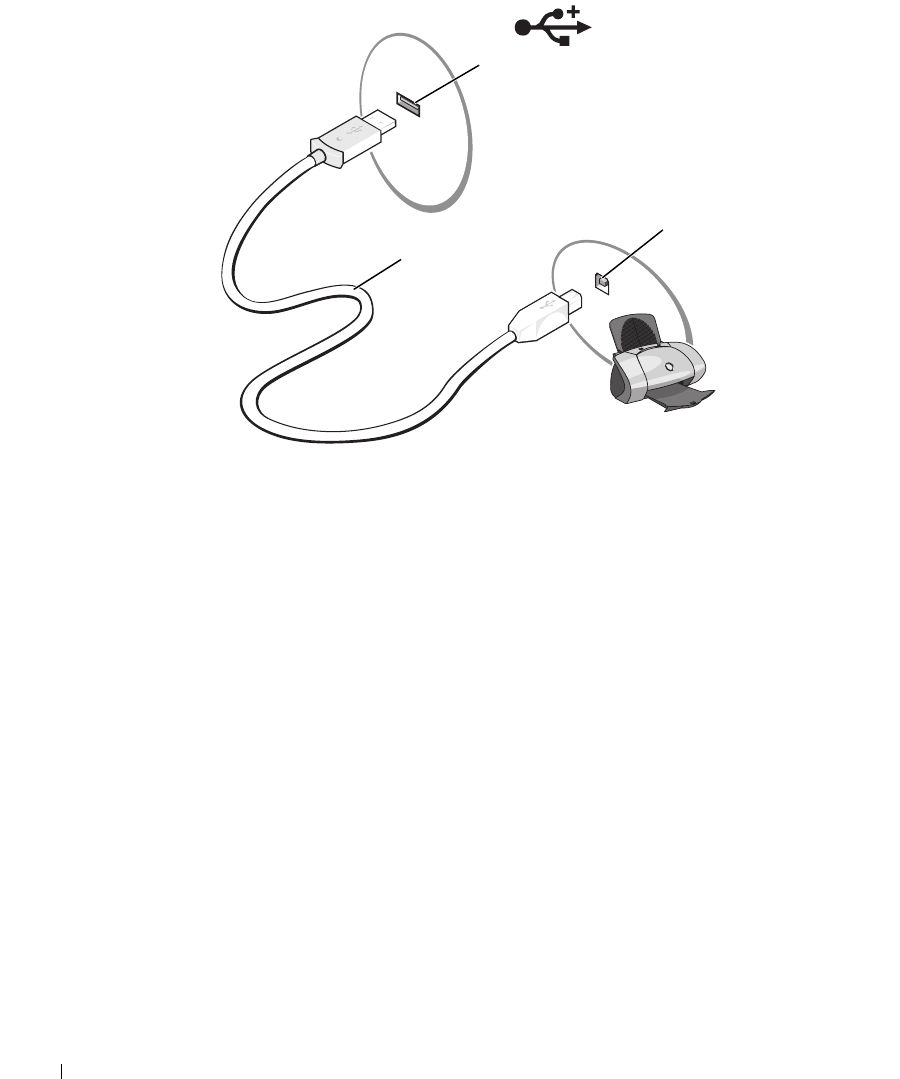
72 Setting Up Your Computer
3
Turn on the printer and then turn on the computer. If the
Add New Hardware Wizard
window
appears, click
Cancel
.
4
Install the printer driver if necessary. See the documentation that came with your printer.
Power Protection Devices
Several devices are available to protect against power fluctuations and failures:
• Surge protectors
• Line conditioners
• Uninterruptible power supplies (UPS)
Surge Protectors
Surge protectors and power strips equipped with surge protection help prevent damage to your computer
from voltage spikes that can occur during electrical storms or after power interruptions. Some surge
protector manufacturers include warranty coverage for certain types of damage. Carefully read the device
warranty when choosing a surge protector. A device with a higher joule rating offers more protection.
Compare joule ratings to determine the relative effectiveness of different devices.
1USB connector on
computer
2USB printer cable 3connector on printer
2
1
3

Setting Up Your Computer 73
NOTICE: Most surge protectors do not protect against power fluctuations or power interruptions caused by
nearby lightning strikes. When lightning occurs in your area, disconnect the telephone line from the telephone wall
jack and disconnect your computer from the electrical outlet.
Many surge protectors have a telephone jack for modem protection. See the surge protector
documentation for modem connection instructions.
NOTICE: Not all surge protectors offer network adapter protection. Disconnect the network cable from the
network wall jack during electrical storms.
Line Conditioners
NOTICE: Line conditioners do not protect against power interruptions.
Line conditioners are designed to maintain AC voltage at a fairly constant level.
Uninterruptible Power Supplies
NOTICE: Loss of power while data is being saved to the hard drive may result in data loss or file damage.
NOTE: To ensure maximum battery operating time, connect only your computer to a UPS. Connect other devices,
such as a printer, to a separate power strip that provides surge protection.
A UPS protects against power fluctuations and interruptions. UPS devices contain a battery that
provides temporary power to connected devices when AC power is interrupted. The battery charges while
AC power is available. See the UPS manufacturer documentation for information on battery operating
time and to ensure that the device is approved by Underwriters Laboratories (UL).

74 Setting Up Your Computer
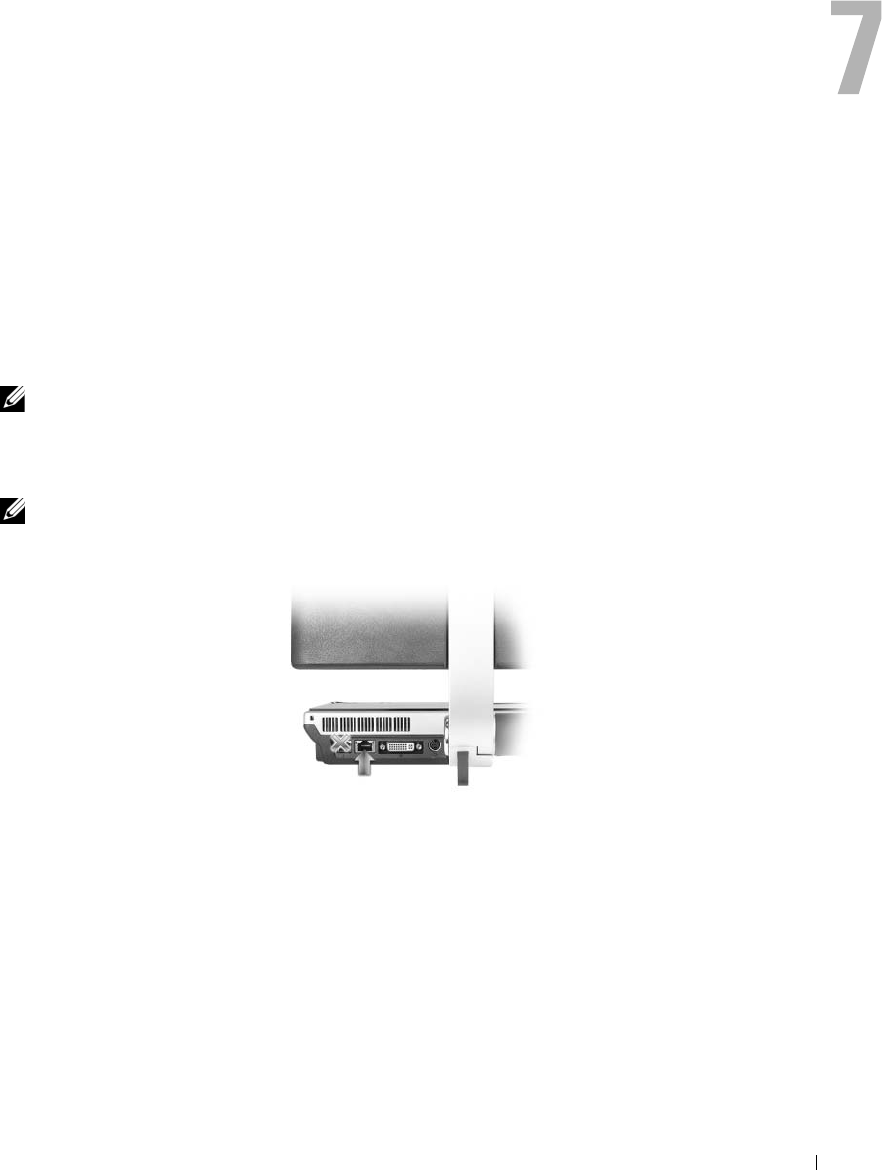
Using Networks (LAN or Wireless) 75
Using Networks (LAN or Wireless)
Physically Connecting to a Network or Broadband Modem
Before you connect your computer to a network, the computer must have a network adapter
installed and a network cable connected to it.
To connect a network cable:
1
Connect the network cable to the network adapter connector on the back of your computer.
NOTE: Insert the cable connector until it clicks into place, and then gently pull the cable to ensure that it is
securely attached.
2
Connect the other end of the network cable to a network connection device or a network wall
connector.
NOTE: Do not use a network cable with a telephone wall connector.
Network Setup Wizard
The Microsoft® Windows® XP operating system provides a Network Setup Wizard to guide you
through the process of sharing files, printers, or an Internet connection between computers in a
home or small office.
1
Click the
Start
button, point to
All Programs
→
Accessories
→
Communications
, and then click
Network Setup Wizard
.
2
On the welcome screen, click
Next
.
3
Click
Checklist for creating a network
.

76 Using Networks (LAN or Wireless)
NOTE: Selecting the connection method labeled This computer connects directly to the Internet enables the
integrated firewall provided with Windows XP Service Pack 2 (SP2).
4
Complete the checklist.
5
Return to the Network Setup Wizard and follow the instructions on the screen.
Wireless Local Area Network (WLAN)
A WLAN is a series of interconnected computers that communicate with each other over the air waves
rather than through a network cable connected to each computer. In a WLAN, a radio communications
device called an access point or wireless router connects network computers and provides Internet, or
network, access. The access point or wireless router and the wireless network card in the computer
communicate by broadcasting data from their antennas over the air waves.
What You Need to Establish a WLAN Connection
Before you can set up a WLAN, you need:
• High-speed (broadband) Internet access (such as cable or DSL)
• A broadband modem that is connected and working
• A wireless router or access point
• A wireless network card for each computer that you want to connect to your WLAN
• A network cable with the network (RJ-45) connector
Checking Your Wireless Network Card
Depending on what you selected when you purchased your computer, the computer has a variety of
configurations. To confirm that your computer has a wireless network card and to determine the type of
card, use one of the following:
• The
Start
button and the
Connect To
option
• The order confirmation for your computer
Start Button and Connect To Option
1
Click the
Start
button.
2
Point to
Connect To
, and then click
Show all connections
.
If Wireless Network Connection does not appear under LAN or High-Speed Internet, you may not have
a wireless network card.

Using Networks (LAN or Wireless) 77
If Wireless Network Connection appears, you have a wireless network card. To view detailed information
about the wireless network card:
1
Right-click
Wireless Network Connection.
2
Click
Properties
. The
Wireless Network Connection Properties
window appears. The wireless network
card’s name and model number are listed on the
General
tab.
NOTE: If your computer is set to the Classic Start menu option, you can view network connections by clicking the
Start button, pointing to Settings, and then pointing to Network Connections. If Wireless Network Connection does
not appear, you may not have a wireless network card.
The Order Confirmation for Your Computer
The order confirmation that you received when you ordered your computer lists the hardware and
software that shipped with your computer.
Setting Up a New WLAN
Connecting a Wireless Router and a Broadband Modem
1
Contact your Internet service provider (ISP) to obtain specific information about the connection
requirements for your broadband modem.
2
Ensure that you have wired Internet access through your broadband modem before you attempt to set
up a wireless Internet connection. See "Physically Connecting to a Network or Broadband Modem" on
page 75.
3
Install any software required for your wireless router. Your wireless router may have been shipped with
an installation CD. Installation CDs usually contain installation and troubleshooting information.
Install the required software according to the instructions provided by the router manufacturer.
4
Shut down your computer and any other wireless-enabled computers in the vicinity through the
Start
menu.
5
Disconnect your broadband modem power cable from the electrical outlet.
6
Disconnect the network cable from the computer and the modem.
NOTE: Wait for a minimum of 5 minutes after disconnecting your broadband modem before you continue with the
network setup.
7
Disconnect the AC adapter cable from your wireless router to ensure that there is no power connected
to the router.
8
Insert a network cable into the network (RJ-45) connector on the unpowered broadband modem.
9
Connect the other end of the network cable into the Internet network (RJ-45) connector on the
unpowered wireless router.
10
Ensure that no network or USB cables, other than the network cable connecting the modem and the
wireless router, are connected to the broadband modem.
NOTE: Restart your wireless equipment in the order described below to prevent a potential connection failure.

78 Using Networks (LAN or Wireless)
11
Tu r n o n
only
your broadband modem and wait for at least 2 minutes for the broadband modem to
stabilize. After 2 minutes, proceed to step 12.
12
Turn on your wireless router and wait for at least 2 minutes for the wireless router to stabilize. After
2 minutes, proceed to the step 13.
13
Start your computer and wait until the boot process completes.
14
See the documentation that came with your wireless router to do the following in order to set up the
wireless router:
• Establish communication between your computer and your wireless router.
• Configure your wireless router to communicate with your broadband router.
• Find out your wireless router’s broadcast name. The technical term for the name of your router’s
broadcast name is Service Set Identifier (SSID) or network name.
15
If necessary, configure your wireless network card to connect to the wireless network. See "Connecting
to a WLAN" on page 78.
Connecting to a WLAN
NOTE: Before you connect to a WLAN, ensure that you have followed the instructions in "Wireless Local Area
Network (WLAN)" on page 76.
NOTE: The following networking instructions do not apply to internal cards with Bluetooth® wireless technology
or cellular products.
This section provides general procedures for connecting to a network via wireless technology. Specific
network names and configuration details vary. See "Wireless Local Area Network (WLAN)" on page 76
for more information about how to prepare for connecting your computer to a WLAN.
Your wireless network card requires specific software and drivers for connecting to a network. The
software is already installed.
NOTE: If the software is removed or corrupted, follow the instructions in the user documentation for your wireless
network card. Verify the type of wireless network card installed in your computer and then search for that name on
the Dell™ Support website at support.dell.com. For information on the type of wireless network card that is
installed in your computer, see "Checking Your Wireless Network Card" on page 76.
Determining the Wireless Network Device Manager
Depending on the software installed on your computer, different wireless configuration utilities may
manage your network devices:
• Your wireless network card’s client utility
• The
Microsoft Windows
XP operating system

Using Networks (LAN or Wireless) 79
To determine which wireless configuration utility is managing your wireless network card:
1
Click the
Start
button, point to
Settings
, and then click
Control Panel
.
2
Double-click
Network Connections
.
3
Right-click the
Wireless Network Connection
icon, and then click
View Available Wireless Networks
.
If the Choose a wireless network window states Windows cannot configure this connection, the wireless
network card’s client utility is managing the wireless network card.
If the Choose a wireless network window states Click an item in the list below to connect to a wireless
network in range or to get more information, the Windows XP operating system is managing the
wireless network card.
For specific information about the wireless configuration utility installed on your computer, see your
wireless network documentation in the Windows Help and Support Center.
To access the Help and Support Center:
1
Click the
Start
button and click
Help and Support
.
2
Under
Pick a Help topic
, click
Dell User and System Guides
.
3
Under
Device Guides
, select the documentation for your wireless network card.
Completing the Connection to the WLAN
When you turn on your computer and a network (for which your computer is not configured) is detected
in the area, a pop-up appears near the network icon in the notification area (in the lower-right corner of
the Windows desktop).
Follow the instructions provided in any utility prompts that appear on your screen.
Once you have configured your computer for the wireless network that you selected, another pop-up
notifies you that your computer is connected to that network.
Thereafter, whenever you log on to your computer within the range of the wireless network that you
selected, the same pop-up notifies you of the wireless network connection.
NOTE: If you select a secure network, you must enter a WEP or WPA key when prompted. Network security
settings are unique to your network. Dell cannot provide this information.
NOTE: Your computer can take up to one minute to connect to the network.
Enabling/Disabling the Wireless Network Card
NOTE: If you are unable to connect to a wireless network, ensure that you have all the components for
establishing a WLAN (see "What You Need to Establish a WLAN Connection" on page 76), and then verify that your
wireless network card is enabled by pressing <Fn><F2>.
You can turn your computer’s wireless networking function on and off by pressing the <Fn><F2> key
combination.

80 Using Networks (LAN or Wireless)
Monitoring the Status of the Wireless Network Card Through Dell QuickSet
The wireless activity indicator provides you with an easy way to monitor the status of your computer’s
wireless devices. Right-click the Dell QuickSet icon in your taskbar to select or deselect Wireless Activity
Indicator Off to turn the wireless activity indicator on or off.
The wireless activity indicator displays whether your computer’s integrated wireless devices are enabled
or disabled. When you turn the wireless networking function on or off, the wireless activity indicator
changes to display the status.
For more information about the wireless activity indicator, see the Dell QuickSet Help file. For
information about QuickSet and how to access the Dell QuickSet Help file, see "Dell QuickSet" on
page 139.
Mobile Broadband or Wireless Wide Area Network (WWAN)
Much like a WLAN, a Mobile Broadband network (also known as a WWAN) is a series of interconnected
computers that communicate with each other through wireless technology. However, a Mobile
Broadband network uses cellular technology and therefore provides Internet access in the same varied
locations from which cellular telephone service is available. Your computer can maintain the Mobile
Broadband network connection regardless of its physical location, as long as the computer remains in the
service area of your cellular service provider.
What You Need to Establish a Mobile Broadband Network Connection
NOTE: You can use a Mobile Broadband ExpressCard to establish a Mobile Broadband network connection.
To set up a Mobile Broadband network connection, you need:
• A Mobile Broadband ExpressCard. For instructions on using ExpressCards, see "Supported Cards" on
page 83.
• The Dell Mobile Broadband Card Utility (already installed on your computer if you purchased the card
when you purchased your computer, or on the CD that accompanied your card if purchased separately
from your computer)
If the utility is corrupted or deleted from your computer, see the Dell Mobile Broadband Card Utility
user’s guide for instructions. The user’s guide is available through the Windows Help and Support
Center (or on the CD that accompanied your card if you purchased it separately from your computer).
To access the Help and Support Center, see "Windows Help and Support Center" on page 15.
Checking Your Dell Mobile Broadband Card
Depending on what you selected when you purchased your computer, the computer has a variety of
configurations. To determine your computer configuration, see one of the following:
• Your order confirmation
• Microsoft Windows Help and Support Center

Using Networks (LAN or Wireless) 81
To check your Mobile Broadband card in the Help and Support Center:
1
Click the
Start
button and click
Help and Support
.
2
Under
Pick a task
, click
Use Tools to view your computer information and diagnose problems
.
3
Under
Tools
, click
My Computer Information
and then click
Find information about the hardware
installed on this computer.
On the My Computer Information - Hardware screen, you can view the type of Mobile Broadband card
installed in your computer as well as other hardware components.
NOTE: The Mobile Broadband card is listed under Modems.
Connecting to a Mobile Broadband Network
NOTE: These instructions only apply to Mobile Broadband ExpressCards. They do not apply to internal cards with
Bluetooth wireless technology.
NOTE: Before you connect to the Internet, you must activate Mobile Broadband service through your cellular
service provider. For instructions and for additional information about using the Dell Mobile Broadband Card Utility,
see the user's guide available through the Windows Help and Support Center. To access the Help and Support
Center, see "Windows Help and Support Center" on page 13. The user's guide is also available on the Dell Support
website at support.dell.com and on the CD included with your Mobile Broadband card if you purchased the card
separately from your computer.
Use the Dell Mobile Broadband Card Utility to establish and manage a Mobile Broadband network
connection to the Internet:
1
Click the
Dell Mobile Broadband Card Utility icon
in the Windows taskbar to run the utility.
2
Click
Connect
.
NOTE: The Connect button changes to the Disconnect button.
3
Follow the instructions on the screen to manage the network connection with the utility.
OR
1
Click the
Start
button, point to
All Programs
→
Dell Wireless
.
2
Click
Dell Wireless Broadband
and follow the instructions on the screen.
Windows Firewall
The Windows Firewall provides basic protection from unauthorized access to the computer while the
computer is connected to the Internet. The firewall is automatically enabled when you run the Network
Setup Wizard. When the firewall is enabled for a network connection, the firewall icon appears with a
red background in the Network Connections section of the Control Panel.
Note that enabling the Windows Firewall does not reduce the need for virus-checking software.
For more information, see the Help and Support Center for the Microsoft Windows XP operating
system. To access the Help and Support Center, see "Windows Help and Support Center" on page 15.

82 Using Networks (LAN or Wireless)

Using Cards 83
Using Cards
Supported Cards
Your computer has two slots for memory storage media that provides a fast and convenient way to
view and share digital photos, music, and videos stored on a media memory card, and one slot for an
ExpressCard for WWAN support. Cards are available for purchase from Dell.
NOTE: Your computer does not support PC cards.
For more information, see "Specifications" on page 141.
Media Memory Card Reader
The media memory card reader reads the following digital media memory cards:
• Secure Digital (SD) card/SDIO
• MultiMediaCard (MMC)
• Memory Stick (MS)
• Memory Stick Pro
• xD-Picture Card
With a commonly available adapter, the memory card reader also reads the following digital media
memory cards:
• MiniSD
•RSMCC
• Memory Stick Duo
• Memory Stick Pro Duo
Compact Flash Card Reader
The compact flash card reader reads the following digital media memory cards:
• Compact Flash Type I
• Compact Flash Type II
• Microdrive
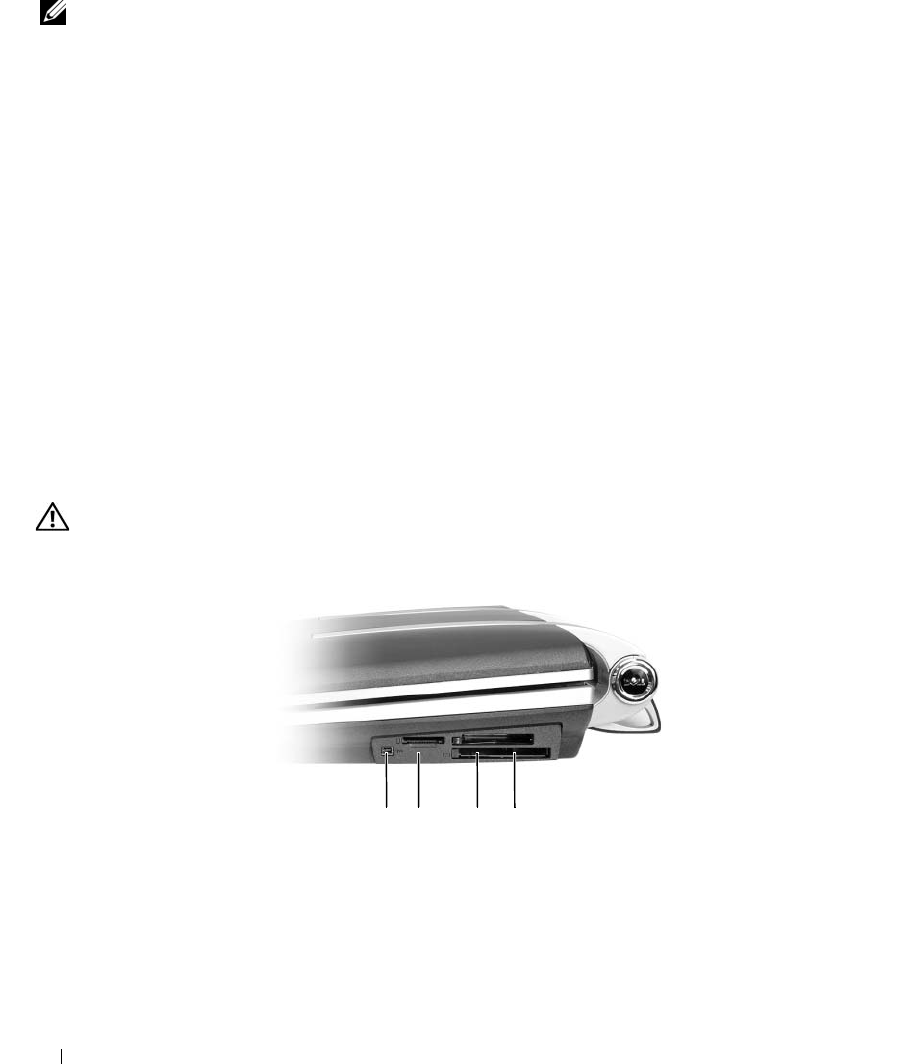
84 Using Cards
ExpressCard Reader
NOTE: PCMCIA cards will not work in the ExpressCard reader.
The ExpressCard slot has one connector that supports both 34-mm and 54-mm ExpressCards.
For more information on WWAN support with the ExpressCard, see "Mobile Broadband or Wireless
Wide Area Network (WWAN)" on page 80.
Extended Cards
An extended card is longer than a standard card and extends outside the computer. Follow these
precautions when using extended cards:
• Protect the exposed end of an installed card. Striking the end of the card can damage the system board.
• Always remove an extended card before you pack the computer in its carrying case.
Installing a Media Memory Card or ExpressCard
You can install a media memory card or ExpressCard in the computer while the computer is running.
The computer automatically detects the card.
Cards are generally marked with a symbol (such as a triangle or an arrow) to indicate which end to insert
into the slot. The cards are keyed to prevent incorrect insertion. If card orientation is not clear, see the
documentation that came with the card.
CAUTION: Before you begin any of the procedures in this section, follow the safety instructions in the Product
Information Guide.
11394 connector 2media memory card slot 3compact flash card slot
4ExpressCard slot
123
4

Using Cards 85
To insert a card:
1
Hold the card with its orientation symbol pointing into the slot and the top side of the card facing up.
The latch may need to be in the "in" position before you insert the card.
2
Slide the card into the slot until the card is completely seated in its connector.
If you encounter too much resistance, do not force the card. Check the card orientation and try again.
Removing a Card
NOTICE: Click the icon in the taskbar to select a card and stop it from functioning before you remove it from
the computer. If you do not stop the card in the configuration utility, you could lose data. Do not attempt to eject a
card by pulling its cable, if one is attached.
Press the latch and remove the card or blank. For some latches, you must press the latch twice: once to
pop the latch out, and then a second time to pop the card out.

86 Using Cards
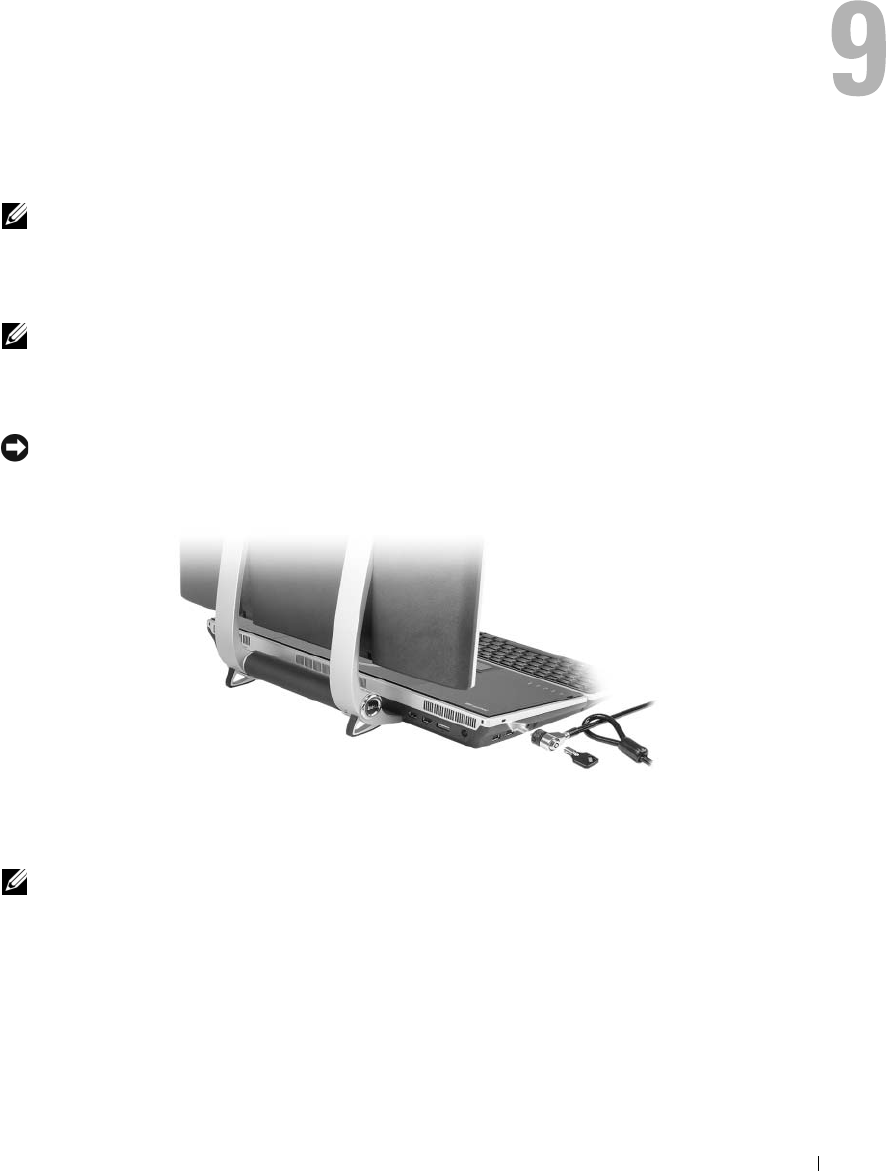
Securing Your Computer 87
Securing Your Computer
NOTE: For information on how to secure your computer while traveling, see "Traveling With Your Computer"
on page 121.
Security Cable Lock
NOTE: Your computer does not ship with a security cable lock.
A security cable lock is a commercially available antitheft device. To use the lock, attach it to the
security cable slot on your Dell™ computer. For more information, see the instructions included
with the device.
NOTICE: Before you buy an antitheft device, ensure that it will work with the security cable slot on your
computer.
Passwords
NOTE: Passwords are disabled when you receive your computer.
A primary password and an administrator password prevent unauthorized access to your computer in
different ways. The following table identifies types and features of passwords available on your
computer.

88 Securing Your Computer
NOTICE: Passwords provide a high level of security for data in your computer. However, they are not foolproof. If
you require more security, obtain and use additional forms of protection, such as smart cards, data encryption
programs, or PC Cards with encryption features.
If you forget any of your passwords, contact your system administrator or contact Dell. See "Contacting
Dell" on page 154. For your protection, Dell support staff will ask you for proof of your identity to ensure
that only an authorized person can use the computer.
Using a Primary/System Password
The primary (system) password allows you to protect the computer from unauthorized access.
Access User Accounts from the Control Panel to create user accounts and add or change passwords.
After assigning a primary password, you must enter it each time you turn on your computer.
If you do not enter a password within 2 minutes, the computer returns to its previous operating state.
NOTICE: If you disable the administrator password, the primary password is also disabled.
If you have assigned an administrator password, you can use it instead of the primary password. The
computer does not specifically prompt you for the administrator password.
Using an Administrator Password
The administrator password is designed to give system administrators or service technicians access to
computers for repair or reconfiguration. The administrators or technicians can assign identical
administrator passwords to groups of computers, allowing you to assign a unique primary password.
To set or change administrator passwords, access User Accounts from the Control Panel.
When you set an administrator password, the Configure Setup option becomes available in system
setup. The Configure Setup option allows you to restrict access to system setup in the same way that a
primary password restricts access to the computer.
The administrator password can be used instead of the primary password. Whenever you are prompted
to enter the primary password, you can enter the administrator password.
NOTICE: If you disable the administrator password, the primary password is also disabled.
If you forget the primary password and do not have an administrator password assigned, or if you have
both a primary and an administrator password assigned but forget them both, contact your system
administrator or contact Dell. See "Contacting Dell" on page 154.
Type of Password Features
Primary/System
• Protects the computer from unauthorized access
Administrator
• Gives system administrators or service technicians
access to computers for repair or reconfiguration
• Allows you to restrict access to system setup in the same
way a primary password restricts access to the computer
• Can be used instead of the primary password

Securing Your Computer 89
Computer Tracking Software
Computer tracking software may enable you to locate your computer if it is lost or stolen. The software is
optional and may be purchased when you order your Dell computer, or you can contact your Dell sales
representative for information about this security feature.
NOTE: Computer tracking software may not be available in certain countries.
NOTE: If you have computer tracking software and your computer is lost or stolen, you must contact the company
that provides the tracking service to report the missing computer.
If Your Computer is Lost or Stolen
• Call a law enforcement agency to report the lost or stolen computer. Include the Service Tag in your
description of the computer. Your Service Tag is in the battery compartment of your computer (see
"Removing the Battery" on page 59)
.
Ask that a case number be assigned and write down the number,
along with the name, address, and phone number of the law enforcement agency. If possible, obtain
the name of the investigating officer.
NOTE: If you know where the computer was lost or stolen, call a law enforcement agency in that area. If you do not
know, call a law enforcement agency where you live.
• If the computer belongs to a company, notify the security office of the company.
• Contact Dell customer service to report the missing computer. Provide the computer Service Tag, the
case number, and the name, address, and phone number of the law enforcement agency to which you
reported the missing computer. If possible, give the name of the investigating officer.
The Dell customer service representative will log your report under the computer Service Tag and record
the computer as missing or stolen. If someone calls Dell for technical assistance and gives your Service
Tag, the computer is identified automatically as missing or stolen. The representative will attempt to get
the phone number and address of the caller. Dell will then contact the law enforcement agency to which
you reported the missing computer.

90 Securing Your Computer

Troubleshooting 91
Troubleshooting
Dell Technical Update Service
The Dell™ Technical Update service provides proactive e-mail notification of software and hardware
updates for your computer. The service is free and can be customized for content, format, and how
frequently you receive notifications.
To enroll for the Dell Technical Update service, go to support.dell.com/technicalupdate.
Dell Diagnostics
CAUTION: Before you begin any of the procedures in this section, follow the safety instructions in the
Product Information Guide.
When to Use the Dell Diagnostics
If you experience a problem with your computer, perform the checks in "Lockups and Software
Problems" on page 102 and run the Dell Diagnostics before you contact Dell for technical assistance.
It is recommended that you print these procedures before you begin.
NOTICE: The Dell Diagnostics works only on Dell computers.
Start the Dell Diagnostics from either your hard drive or from the Drivers and Utilities CD (also
known as the ResourceCD).
Starting the Dell Diagnostics From Your Hard Drive
The Dell Diagnostics is located on a hidden diagnostic utility partition on your hard drive.
NOTE: If your computer cannot display a screen image, contact Dell. See "Contacting Dell" on page 154.
1
Shut down the computer.
2
Connect the computer to an electrical outlet.
3
Diagnostics can be invoked one of two ways:
a
Turn on the computer. When the DELL™ logo appears, press <F12> immediately. Select
Diagnostics from the boot menu and press <Enter>.
NOTE: The keyboard must be awake to recognize the keystroke. Ensure the keyboard is awake by
touching the touchpad.

92 Troubleshooting
If you wait too long and the operating system logo appears, continue to wait until you see the
Microsoft
®
Windows
®
desktop. Then shut down your computer and try again.
b
Press and hold the <Fn> key while powering the computer on.
NOTE: If you see a message stating that no diagnostics utility partition has been found, run the Dell
Diagnostics from the Drivers and Utilities CD.
The computer runs the Pre-boot System Assessment, a series of initial tests of your system board,
keyboard, hard drive, and display.
• During the assessment, answer any questions that appear.
• If a failure is detected, the computer stops and beeps. To stop the assessment and restart the
computer, press <Esc>; to continue to the next test, press <y>; to retest the component that
failed, press <r>.
• If failures are detected during the Pre-boot System Assessment, write down the error code(s) and
contact Dell. See "Contacting Dell" on page 154.
If the Pre-boot System Assessment completes successfully, you receive the message:
Booting Dell Diagnostic Utility Partition. Press any key to continue
.
4
Press any key to start the Dell Diagnostics from the diagnostics utility partition on your hard drive.
Starting the Dell Diagnostics From the Drivers and Utilities CD
1
Insert the
Drivers and Utilities
CD.
2
Shut down and restart the computer.
When the DELL logo appears, press <F12> immediately.
NOTE: The keyboard must be awake to recognize the keystroke. Ensure the keyboard is awake by touching
the touchpad.
If you wait too long and the operating system logo appears, continue to wait until you see the
Microsoft Windows desktop. Then shut down your computer and try again.
The next steps change the boot sequence for one time only. On the next start-up, the computer boots
according to the devices specified in system setup.
3
When the boot device list appears, highlight
CD/DVD/CD-RW Drive
and press <Enter>.
4
Select the
Boot from CD-ROM
option from the menu that appears and press <Enter>.
5
Ty p e
1
to start the menu and press <Enter> to proceed.
6
Select
Run the 32 Bit Dell Diagnostics
from the numbered list. If multiple versions are listed, select
the version appropriate for your computer.
7
When the Dell Diagnostics
Main Menu
appears, select the test you want to run.

Troubleshooting 93
Dell Diagnostics Main Menu
1
After the Dell Diagnostics loads and the
Main
Menu
screen appears, click the button for the option
you want.
2
If a problem is encountered during a test, a message appears with an error code and a description of the
problem. Write down the error code and problem description and follow the instructions on the
screen.
If you cannot resolve the error condition, contact Dell. See "Contacting Dell" on page 154.
NOTE: The Service Tag for your computer is located at the top of each test screen. If you contact Dell,
technical support will ask for your Service Tag.
3
If you run a test from the
Custom Test
or
Symptom Tree
option, click the applicable tab described in
the following table for more information.
Option Function
Express Test Performs a quick test of devices. This test typically takes
10 to 20 minutes and requires no interaction on your
part. Run Express Test first to increase the possibility of
tracing the problem quickly.
Extended Test Performs a thorough check of devices. This test typically
takes one hour or more and requires you to answer
questions periodically.
Custom Test Tests a specific device. You can customize the tests you
want to run.
Symptom Tree Lists the most common symptoms encountered and
allows you to select a test based on the symptom of the
problem you are having.
Tab Function
Results Displays the results of the test and any error conditions
encountered.
Errors Displays error conditions encountered, error codes, and
the problem description.
Help Describes the test and may indicate requirements for
running the test.

94 Troubleshooting
4
When the tests are completed, if you are running the Dell Diagnostics from the
Drivers and Utilities
CD
,
remove the CD.
5
When the tests are complete, close the test screen to return to the
Main
Menu
screen. To exit the Dell
Diagnostics and restart the computer, close the
Main
Menu
screen.
Dell Support Utility
The Dell Support Utility is installed on your computer and available from the Dell Support icon on the
taskbar or from the Start button. Use this support utility for self-support information, software updates,
and health scans of your computing environment.
Accessing the Dell Support Utility
Access the Dell Support Utility from the Dell Support icon on the taskbar or from the Start menu.
If the Dell Support icon does not appear in your taskbar:
1
Click the
Start
button and point to
Programs
.
2
Click
Dell Support
and point to
Dell Support Settings
.
3
Ensure that the
Show icon on the taskbar
option is checked.
NOTE: If the Dell Support Utility is not available from the Start menu, go to support.dell.com and download the
software.
The Dell Support Utility is customized for your computing environment.
The Dell Support icon in the taskbar functions differently when you click, double-click, or right-click the
icon.
Configuration Displays your hardware configuration for the selected
device.
The Dell Diagnostics obtains configuration information
for all devices from system setup, memory, and various
internal tests, and it displays the information in the
device list in the left pane of the screen. The device list
may not display the names of all the components
installed on your computer or all devices attached to your
computer.
Parameters Allows you to customize the test by changing the test
settings.
Tab Function

Troubleshooting 95
Clicking the Dell Support Icon
Click or right-click the icon to perform the following tasks:
• Check your computing environment
• View the Dell Support Utility settings
• Access the help file for the Dell Support Utility
• View frequently asked questions
• Learn more about the Dell Support Utility
• Turn the Dell Support Utility off
Double-Clicking the Dell Support Icon
Double-click the icon to manually check your computing environment, view frequently asked
questions, access the help file for the Dell Support Utility, and view Dell Support settings.
For more information about the Dell Support Utility, click the question mark (?) at the top of the Dell
Support screen.
Drive Problems
CAUTION: Before you begin any of the procedures in this section, follow the safety instructions in the Product
Information Guide.
Fill out the Diagnostics Checklist as you complete these checks. See "Diagnostics Checklist" on
page 153.
ENSURE THAT MICROSOFT WINDOWS RECOGNIZES THE DRIVE —Click the Start button and click My Computer.
If the DVD drive is not listed, perform a full scan with your antivirus software to check for and remove viruses.
Viruses can sometimes prevent Windows from recognizing the drive.
TEST THE DRIVE —Insert another CD or DVD to eliminate the possibility that the original one is defective.
CLEAN THE DISK —See "Cleaning Your Computer" on page 173.
CANNOT READ OR PLAY DISC —If the disc is dirty, clean it with a non-abrasive cloth from the disc center hole to
the outside. If the disc is scratched and warped, do not insert it into the drive. If the disc is inserted upside down,
remove and reinsert in the proper direction.
CHECK THE CABLE CONNECTIONS
CHECK FOR HARDWARE INCOMPATIBILITIES —See "Resolving Software and Hardware Incompatibilities" on page 126.
RUN THE DELL DIAGNOSTICS —
See
"Dell Diagnostics" on page 91
.
DVD drive problems
NOTE: High-speed DVD drive vibration is normal and may cause noise, which does not indicate a defect in the
drive or the CD or DVD.

96 Troubleshooting
NOTE: Because of different regions worldwide and different disc formats, not all DVD titles work in all DVD drives.
DISK WILL NOT EJECT —Press the eject button again. If problem continues, restart the system.
Problems writing to a CD/DVD-RW drive
CLOSE OTHER PROGRAMS —The CD/DVD-RW drive must receive a steady stream of data when writing. If the
stream is interrupted, an error occurs. Try closing all programs before you write to the CD/DVD-RW.
TURN OFF STANDBY MODE IN WINDOWS BEFORE WRITING TO A CD/DVD-RW DISC —See "Standby Mode" on
page 64 or search for the keyword standby in the Windows Help and Support Center for information on power
management modes.
CHANGE THE WRITE SPEED TO A SLOWER RATE —See the help files for your CD or DVD creation software.
ENSURE THAT THE DISC IS LOADED IN THE DRIVE WITH THE LABEL FACING UP —See "Playing CDs or DVDs" on
page 39 for proper insertion instructions.
VERIFY THE TYPE OF DISC BEING USED —CD-R, DVD+R, and DVD-R discs cannot be rewritten.
ENSURE THAT THERE IS ENOUGH FREE SPACE ON THE WRITABLE DISC —Do not burn a blank CD-R or CD-RW
to its maximum capacity. The drive needs 1–2 MB of the blank space to finalize the recording.
If you hear an unfamiliar scraping or grinding sound
• Ensure that the sound is not caused by the program that is running.
• Ensure that the disk or disc is inserted properly.
Hard drive problems
ALLOW THE COMPUTER TO COOL BEFORE TURNING IT ON —A hot hard drive may prevent the operating system
from starting. Try allowing the computer to return to room temperature before turning it on.
RUN CHECK DISK —
1
Click the
Start
button and click
My Computer
.
2
Right-click
Local Disk C:
.
3
Click
Properties
.
4
Click the
Tools
tab.
5
Under
Error-checking
, click
Check Now
.
6
Click
Scan for and attempt recovery of bad sectors
.
7
Click
Start
.
E-Mail, Modem, and Internet Problems
CAUTION: Before you begin any of the procedures in this section, follow the safety instructions in the Product
Information Guide.
NOTE: Connect the modem to an analog telephone jack only. The modem does not operate while it is connected to
a digital telephone network.

Troubleshooting 97
CHECK THE MICROSOFT OUTLOOK® EXPRESS SECURITY SETTINGS —If you cannot open your e-mail
attachments:
1
In Outlook Express, click
Tools
, click
Options
, and then click
Security
.
2
Click
Do not allow attachments
to remove the checkmark.
CHECK THE TELEPHONE LINE CONNECTION
CHECK THE TELEPHONE JACK
CONNECT THE MODEM DIRECTLY TO THE TELEPHONE WALL JACK
USE A DIFFERENT TELEPHONE LINE —
• Verify that the telephone line is connected to the jack on the modem. (The jack has either a green label
or a connector-shaped icon next to it.)
• Ensure that you hear a click when you insert the telephone line connector into the modem.
• Disconnect the telephone line from the modem and connect it to a telephone. Listen for a dial tone.
• If you have other telephone devices sharing the line, such as an answering machine, fax machine, surge
protector, or line splitter, then bypass them and connect the modem directly to the telephone wall jack.
If you are using a line that is 3 m (10 ft) or more in length, try a shorter one.
RUN THE MODEM HELPER DIAGNOSTICS —Click the Start button, point to All Programs and then click
Modem Helper. Follow the instructions on the screen to identify and resolve modem problems. (Modem
Helper is not available on all computers.)
VERIFY THAT THE MODEM IS COMMUNICATING WITH WINDOWS —
1
Click the
Start
button and click
Control Panel
.
2
Click
Phone and Modem Options
.
3
Click the
Modems
tab.
4
Click the COM port for your modem.
5
Click
Properties
, click the
Diagnostics
tab, and then click
Query Modem
to verify that the modem is
communicating with Windows.
If all commands receive responses, the modem is operating properly.
ENSURE THAT YOU ARE CONNECTED TO THE INTERNET —Ensure that you have subscribed to an Internet
provider. With the Outlook Express e-mail program open, click File. If Work Offline has a checkmark
next to it, click the checkmark to remove it and connect to the Internet. For help, contact your Internet
service provider.
SCAN THE COMPUTER FOR SPYWARE —If you are experiencing slow computer performance, you
frequently receive pop-up advertisements, or you are having problems connecting to the Internet, your
computer might be infected with spyware. Use an anti-virus program that includes anti-spyware
protection (your program may require an upgrade) to scan the computer and remove spyware. For more
information, go to support.dell.com and search for the keyword spyware.

98 Troubleshooting
Error Messages
Fill out the Diagnostics Checklist as you complete these checks. See "Diagnostics Checklist" on
page 153.
CAUTION: Before you begin any of the procedures in this section, follow the safety instructions in the Product
Information Guide.
If the message is not listed, see the documentation for the operating system or the program that was
running when the message appeared.
AUXILIARY DEVICE FAILURE —The touch pad or external mouse may be faulty. For an external mouse, see
"Using the Keyboard and Mouse" on page 29. Enable the Pointing Device option in the system setup
program. If the problem persists, contact Dell. See "Contacting Dell" on page 154.
BAD COMMAND OR FILE NAME —Ensure that you have spelled the command correctly, put spaces in the
proper place, and used the correct pathname.
CACHE DISABLED DUE TO FAILURE —The primary cache internal to the microprocessor has failed. Contact
Dell. See "Contacting Dell" on page 154.
CD DRIVE CONTROLLER FAILURE —The CD drive does not respond to commands from the computer. See
"Dell Support Utility" on page 94.
DATA ERROR —The hard drive cannot read the data. See "Dell Support Utility" on page 94.
DECREASING AVAILABLE MEMORY —One or more memory modules may be faulty or improperly seated.
Reinstall the memory modules and, if necessary, replace them. See "Memory" on page 133.
DISK C: FAILED INITIALIZATION —The hard drive failed initialization. Run the hard drive tests in the Dell
Diagnostics. See "Dell Diagnostics" on page 91.
EXTENDED MEMORY SIZE HAS CHANGED —The amount of memory recorded in NVRAM does not match
the memory installed in the computer. Restart the computer. If the error appears again, contact Dell. See
"Contacting Dell" on page 154.
THE FILE BEING COPIED IS TOO LARGE FOR THE DESTINATION DRIVE —The file that you are trying to copy is
too large to fit on the disk, or the disk is too full. Try copying the file to a different disk or use a larger
capacity disk.
A FILENAME CANNOT CONTAIN ANY OF THE FOLLOWING CHARACTERS: \ / : * ? “ < > | — Do not use these
characters in filenames.
GATE A20 FAILURE —A memory module may be loose. Reinstall the memory modules and, if necessary,
replace them. See "Memory" on page 133.
GENERAL FAILURE —The operating system is unable to carry out the command. The message is usually
followed by specific information—for example, Printer out of paper. Take the appropriate
action.
HARD-DISK DRIVE CONFIGURATION ERROR —The computer cannot identify the drive type. Run the Hard-
Disk Drive tests in the Dell Diagnostics. See "Dell Diagnostics" on page 91.
HARD-DISK DRIVE CONTROLLER FAILURE 0—The hard drive does not respond to commands from the
computer. Run the Hard-Disk Drive tests in the Dell Diagnostics. See "Dell Diagnostics" on page 91.

Troubleshooting 99
HARD-DISK DRIVE FAILURE —The hard drive does not respond to commands from the computer. Run the
Hard-Disk Drive tests in the Dell Diagnostics. See "Dell Diagnostics" on page 91.
HARD-DISK DRIVE READ FAILURE —The hard drive may be defective. Run the Hard-Disk Drive tests in the
Dell Diagnostics. See "Dell Diagnostics" on page 91.
INSERT BOOTABLE MEDIA —The operating system is trying to boot to a nonbootable CD. Insert a
bootable CD.
INVALID CONFIGURATION INFORMATION-PLEASE RUN SYS T E M SETUP PROGRAM —The system configuration
information does not match the hardware configuration. The message is most likely to occur after a
memory module is installed. Correct the appropriate options in the system setup program. See "System
Setup Program" on page 113.
KEYBOARD CLOCK LINE FAILURE —Run the Keyboard Controller test in the Dell Diagnostics. See "Dell
Diagnostics" on page 91.
KEYBOARD CONTROLLER FAILURE —Restart the computer, and avoid touching the keyboard or the mouse
during the boot routine. Run the Keyboard Controller test in the Dell Diagnostics. See "Dell
Diagnostics" on page 91.
KEYBOARD DATA LINE FAILURE —Run the Keyboard Controller test in the Dell Diagnostics. See "Dell
Diagnostics" on page 91.
KEYBOARD STUCK KEY FAILURE —Restart the computer, and avoid touching the keyboard or keys during
the boot routine. Run the Stuck Key test in the Dell Diagnostics. See "Dell Diagnostics" on page 91.
LICENSED CONTENT IS NOT ACCESSIBLE IN MEDIADIRECT —Dell MediaDirect™ cannot verify the Digital Rights
Management (DRM) restrictions on the file, so the file cannot be played. See "Dell MediaDirect problems" on
page 103.
MEMORY ADDRESS LINE FAILURE AT ADDRESS, READ VALUE EXPECTING VALUE —A memory module may be
faulty or improperly seated. Reinstall the memory modules and, if necessary, replace them. See "Memory"
on page 133.
MEMORY ALLOCATION ERROR —The software you are attempting to run is conflicting with the operating
system, another program, or a utility. Shut down the computer, wait 30 seconds, and then restart it. Try
to run the program again. If the error message still appears, see the software documentation.
MEMORY DATA LINE FAILURE AT ADDRESS, READ VALUE EXPECTING VALUE —A memory module may be
faulty or improperly seated. Reinstall the memory modules (see "Memory" on page 133) and, if necessary,
replace them.
MEMORY DOUBLE WORD LOGIC FAILURE AT ADDRESS, READ VALUE EXPECTING VALUE —A memory module
may be faulty or improperly seated. Reinstall the memory modules (see "Memory" on page 133) and, if
necessary, replace them.
MEMORY ODD/EVEN LOGIC FAILURE AT ADDRESS, READ VALUE EXPECTING VALUE —A memory module may
be faulty or improperly seated. Reinstall the memory modules (see "Memory" on page 133) and, if
necessary, replace them.
MEMORY WRITE/READ FAILURE AT ADDRESS, READ VALUE EXPECTING VALUE —A memory module may be
faulty or improperly seated. Reinstall the memory modules (see "Memory" on page 133) and, if necessary,
replace them.

100 Troubleshooting
NO BOOT DEVICE AVAILABLE —The computer cannot find the hard drive. If the hard drive is your boot
device, ensure that the drive is installed, properly seated, and partitioned as a boot device.
NO BOOT SECTOR ON HARD DRIVE —The operating system may be corrupted. Contact Dell. See
"Contacting Dell" on page 154.
NO TIMER TICK INTERRUPT —A chip on the system board may be malfunctioning. Run the System Set
tests in the Dell Diagnostics. See "Dell Diagnostics" on page 91.
NOT ENOUGH MEMORY OR RESOURCES. EXIT SOME PROGRAMS AND TRY AGAIN —You have too many
programs open. Close all windows and open the program that you want to use.
OPERATING SYSTEM NOT FOUND —Contact Dell. See "Contacting Dell" on page 154.
OPTIONAL ROM BAD CHECKSUM —The optional ROM apparently failed. Contact Dell. See "Contacting
Dell" on page 154.
A REQUIRED .DLL FILE WAS NOT FOUND —The program that you are trying to open is missing an essential
file. Remove and then reinstall the program.
1
Click the
Start
button and click
Control Panel
.
2
Click
Add or Remove Programs
.
3
Select the program you want to remove.
4
Click
Remove
or
Change/Remove
and follow the prompts on the screen.
5
See the program documentation for installation instructions.
SECTOR NOT FOUND —The operating system cannot locate a sector on the hard drive. You may have a
defective sector or corrupted FAT on the hard drive. Run the Windows error-checking utility to check the
file structure on the hard drive. See the Help and Support Center for instructions. If a large number of
sectors are defective, back up the data (if possible), and then reformat the hard drive.
SEEK ERROR —The operating system cannot find a specific track on the hard drive.
SHUTDOWN FAILURE —A chip on the system board may be malfunctioning. Run the System Set tests in
the Dell Diagnostics. See "Dell Diagnostics" on page 91.
TIME-OF-DAY CLOCK LOST POWER —System configuration settings are corrupted. Connect your computer
to an electrical outlet to charge the battery. If the problem persists, try to restore the data by entering the
system setup program. Then immediately exit the program. If the message reappears, contact Dell. See
"Contacting Dell" on page 154.
TIME-OF-DAY CLOCK STOPPED —The reserve battery that supports the system configuration settings may
require replacing. See "Coin-Cell Battery" on page 138.
TIME-OF-DAY NOT SET-PLEASE RUN THE SYS T E M SETUP PROGRAM —The time or date stored in the system
setup program does not match the system clock. Correct the settings for the Date and Time options. See
"System Setup Program" on page 113.
TIMER CHIP COUNTER 2 FAILED —A chip on the system board may be malfunctioning. Run the System
Set tests in the Dell Diagnostics. See "Dell Diagnostics" on page 91.

Troubleshooting 101
UNEXPECTED INTERRUPT IN PROTECTED MODE —The keyboard controller may be malfunctioning, or a
memory module may be loose. Run the System Memory tests and the Keyboard Controller test in the
Dell Diagnostics. See "Dell Diagnostics" on page 91.
X:\ IS NOT ACCESSIBLE. THE DEVICE IS NOT READY —Insert a disk into the drive and try again.
WARNING: BATTERY IS CRITICALLY LOW —The battery is running out of charge. Replace the battery, or
connect the computer to an electrical outlet. Otherwise, activate hibernate mode or shut down the
computer.
IEEE 1394 Device Problems
CAUTION: Before you begin any of the procedures in this section, follow the safety instructions in the Product
Information Guide.
ENSURE THAT THE IEEE 1394 DEVICE IS RECOGNIZED BY WINDOWS —
1
Click the
Start
button and click
Control Panel
.
2
Click
System
to open the
System Properties
window.
3
Click the
Hardware
tab, then click
Device Manager
.
If your IEEE 1394 device is listed, Windows recognizes the device.
IF YOU HAVE PROBLEMS WITH A DELL-PROVIDED IEEE 1394 DEVICE —
IF YOU HAVE PROBLEMS WITH AN IEEE 1394 DEVICE NOT PROVIDED BY DELL —
Contact Dell (
see "Contacting Dell" on page 154)
or the IEEE 1394 device manufacturer.
ENSURE THAT THE IEEE 1394 DEVICE IS PROPERLY INSERTED INTO THE CONNECTOR
Keyboard Problems
CAUTION: Before you begin any of the procedures in this section, follow the safety instructions in the Product
Information Guide.
Fill out the Diagnostics Checklist (see "Diagnostics Checklist" on page 153) as you perform the various
checks.
NOTE: Use the wireless keyboard when running the Dell Diagnostics or the system setup program. When you
attach an external keyboard, the wireless keyboard remains fully functional.
Keyboard problems
COMPUTER BASE DOES NOT RECOGNIZE WIRELESS KEYBOARD —See "Pairing the Keyboard" on page 29.
RUN THE KEYBOARD DIAGNOSTICS TESTS —Run the PC-AT Compatible Keyboards tests in the Dell Diagnostics.
See "Dell Diagnostics" on page 91. If the tests indicate a defective keyboard, contact Dell. See "Contacting Dell" on
page 154.

102 Troubleshooting
Unexpected characters
DISABLE THE NUMERIC KEYPAD —Press <Num Lk> to disable the numeric keypad if numbers are displayed
instead of letters. Verify that the numbers lock light is not lit.
Lockups and Software Problems
CAUTION: Before you begin any of the procedures in this section, follow the safety instructions in the Product
Information Guide.
The computer does not start up
ENSURE THAT THE AC ADAPTER IS FIRMLY CONNECTED TO THE COMPUTER AND TO THE ELECTRICAL OUTLET.
The computer stops responding
NOTICE: You might lose data if you are unable to perform an operating system shutdown.
TURN THE COMPUTER OFF —If you are unable to get a response by pressing a key on your keyboard or
moving your mouse, press and hold the power button for at least 8 to 10 seconds until the computer
turns off. Then restart your computer.
A program stops responding
A program crashes repeatedly
NOTE: Software usually includes installation instructions in its documentation or on a CD.
END THE PROGRAM —
1
Press <Ctrl><Shift><Esc> simultaneously.
2
Click
Applications
.
3
Click the program that is no longer responding.
4
Click
End Task
.
CHECK THE SOFTWARE DOCUMENTATION —If necessary, uninstall and then reinstall the program.
A program is designed for an earlier Microsoft Windows operating system
RUN THE PROGRAM COMPATIBILITY WIZARD —The Program Compatibility Wizard configures a program
so it runs in an environment similar to non-Windows XP operating system environments.
1
Click the
Start
button, point to
All Programs
→
Accessories
, and then click
Program Compatibility
Wizard
.
2
In the welcome screen, click
Next
.
3
Follow the instructions on the screen.

Troubleshooting 103
A solid blue screen appears
TURN THE COMPUTER OFF —If you are unable to get a response by pressing a key on your keyboard or
moving your mouse, press and hold the power button for at least 8 to 10 seconds until the computer
turns off. Then restart your computer.
Dell MediaDirect problems
CHECK THE DELL MEDIADIRECT HELP FILE FOR INFORMATION —Click the question mark icon at the bottom
of the Dell MediaDirect screen to access Help.
TO PLAY MOVIES WITH DELL MEDIADIRECT, YOU MUST HAVE A DVD DRIVE AND THE DELL DVD PLAYER —If
you purchased a DVD drive with your computer, this software should already be installed.
VIDEO QUALITY PROBLEMS —Turn off the Use Hardware Acceleration option. This feature takes
advantage of the special processing in some graphics cards to reduce processor requirements when
playing DVDs and certain types of video files.
CANNOT PLAY SOME MEDIA FILES —Because Dell MediaDirect provides access to media files outside the
Windows XP operating system environment, access to licensed content is restricted. Licensed content is
digital content that has Digital Rights Management (DRM) applied to it. The Dell MediaDirect
environment cannot verify the DRM restrictions, so the licensed files cannot be played. Licensed music
and video files have a lock icon next to them. You can access licensed files in the Windows XP operating
system environment.
ADJUSTING THE COLOR SETTINGS FOR MOVIES THAT CONTAIN SCENES THAT ARE TOO DARK OR TOO BRIGHT —
Click EagleVision to use a video enhancement technology that detects video content and dynamically
adjusts the brightness/contrast/saturation ratios.
NOTICE: You cannot reinstall the Dell MediaDirect feature if you reformat the hard drive. Contact Dell for
assistance. See "Contacting Dell" on page 154.
Other software problems
CHECK THE SOFTWARE DOCUMENTATION OR CONTACT THE SOFTWARE MANUFACTURER FOR TROUBLESHOOTING
INFORMATION —
• Ensure that the program is compatible with the operating system installed on your computer.
• Ensure that your computer meets the minimum hardware requirements needed to run the software.
See the software documentation for information.
• Ensure that the program is installed and configured properly.
• Verify that the device drivers do not conflict with the program.
• If necessary, uninstall and then reinstall the program.

104 Troubleshooting
BACK UP YOUR FILES IMMEDIATELY.
USE A VIRUS-SCANNING PROGRAM TO CHECK THE HARD DRIVE, FLOPPY DISKS, OR CDS.
SAVE AND CLOSE ANY OPEN FILES OR PROGRAMS AND SHUT DOWN YOUR COMPUTER THROUGH THE Start MENU.
SCAN THE COMPUTER FOR SPYWARE —If you are experiencing slow computer performance, you
frequently receive pop-up advertisements, or you are having problems connecting to the Internet, your
computer might be infected with spyware. Use an anti-virus program that includes anti-spyware
protection (your program may require an upgrade) to scan the computer and remove spyware. For more
information, go to support.dell.com and search for the keyword spyware.
RUN THE DELL DIAGNOSTICS —See "Dell Diagnostics" on page 91. If all tests run successfully, the error
condition is related to a software problem.
Memory Problems
Fill out the Diagnostics Checklist (see "Diagnostics Checklist" on page 153) as you complete these
checks.
CAUTION: Before you begin any of the procedures in this section, follow the safety instructions in the Product
Information Guide.
IF YOU RECEIVE AN INSUFFICIENT MEMORY MESSAGE —
• Save and close any open files and exit any open programs you are not using to see if that resolves the
problem.
• See the software documentation for minimum memory requirements. If necessary, install additional
memory.
See "Memory" on page 133.
• Reseat the memory modules to ensure that your computer is successfully communicating with the
memory. See "Memory" on page 133.
• Run the Dell Diagnostics. See "Dell Diagnostics" on page 91.
IF YOU EXPERIENCE OTHER MEMORY PROBLEMS —
• Reseat the memory modules (see "Memory" on page 133) to ensure that your computer is successfully
communicating with the memory.
• Ensure that you are following the memory installation guidelines. See "Memory" on page 133.
• Run the Dell Diagnostics. See "Dell Diagnostics" on page 91.
Mouse Problems
COMPUTER BASE DOES NOT RECOGNIZE WIRELESS MOUSE —See "Pairing the Mouse" on page 31.

Troubleshooting 105
Network Problems
Fill out the "Diagnostics Checklist" on page 153 as you complete these checks.
CAUTION: Before you begin any of the procedures in this section, follow the safety instructions in the Product
Information Guide.
General
CHECK THE NETWORK CABLE CONNECTOR —Ensure that the network cable is firmly inserted into both the
network connector on the back of the computer and the network connector.
CHECK THE NETWORK LIGHTS ON THE NETWORK CONNECTOR —No light indicates that no network
communication exists. Replace the network cable.
RESTART THE COMPUTER AND LOG ON TO THE NETWORK AGAIN.
CHECK YOUR NETWORK SETTINGS —Contact your network administrator or the person who set up your
network to verify that your network settings are correct and that the network is functioning.
Mobile Broadband Network
NOTE: The Dell Mobile Broadband Card Utility user’s guide is located under Help and Support. You can also
download the user’s guide from support.dell.com.
NOTE: The icon appears in the notification area if the computer has a Dell Mobile Broadband card installed.
Double-click the icon to launch the utility.
CANNOT CONNECT —The Dell Mobile Broadband card must be activated on the network in order to
connect. Position the mouse over the icon in the notification area to read the status of the
connection. If the status indicates the mobile broadband card is not activated, see "Activate your Mobile
Broadband card" on page 106 for more information. If problems persist, contact your Mobile Broadband
service carrier for details on your plan.
CHECK YOUR MOBILE BROADBAND NETWORK SERVICE —Contact your Mobile Broadband service carrier to
verify coverage plan and supported services.
CHECK THE STATUS IN THE DELL MOBILE BROADBAND CARD UTILITY —Click the icon in the taskbar to
launch the utility. Check the status in the main window:
•
No card detected
– Restart the computer and launch the utility again.
•
Radio Off
– Ensure the Mobile Broadband card is enabled by viewing the status in the Dell Mobile
Broadband Card Utility. If the card is disabled, enable the Mobile Broadband card by clicking the
Tu rn
Radio On
button in the main screen of the Dell Mobile Broadband Card Utility.
•
Searching
– The Dell Mobile Broadband Card Utility has not yet located a Mobile Broadband
network. If the searching state persists, ensure that the signal strength is adequate.
•
No service
– The Dell Mobile Broadband Card Utility did not locate a Mobile Broadband network.
Ensure that the signal strength is adequate. Restart the Dell wireless utility or contact your Mobile
Broadband network provider.

106 Troubleshooting
•
Check your WWAN service
– Contact your Mobile Broadband network service provider to verify
coverage plan and supported services.
ACTIVATE YOUR MOBILE BROADBAND CARD —Before you connect to the Internet, you must activate the
Mobile Broadband service through your cellular service provider. For instructions and for additional
information about using the Dell Mobile Broadband Card Utility, see the user's guide available through
the Windows Help and Support Center. To access the Help and Support Center, see "Windows Help and
Support Center" on page 15. The user's guide is also available on the Dell Support website at
support.dell.com and on the CD included with your Mobile Broadband card if you purchased the card
separately from your computer.
Media Memory Card or ExpressCard Problems
CAUTION: Before you begin any of the procedures in this section, follow the safety instructions in the Product
Information Guide.
NOTE: The ExpressCard slot does not support PC cards.
CHECK THE CARD —Ensure that the card is properly inserted into the connector.
ENSURE THAT THE CARD IS RECOGNIZED BY WINDOWS —Double-click the Safely Remove Hardware icon
in the Windows taskbar. Ensure that the card is listed.
IF YOU HAVE PROBLEMS WITH A DELL-PROVIDED CARD —Contact Dell. See "Contacting Dell" on page 154.
IF YOU HAVE PROBLEMS WITH A CARD NOT PROVIDED BY DELL —Contact the card manufacturer.
Power Problems
Fill out the Diagnostics Checklist (see "Diagnostics Checklist" on page 153) as you complete these
checks.
CAUTION: Before you begin any of the procedures in this section, follow the safety instructions in the Product
Information Guide.
CHECK THE POWER LIGHT —When the power light is lit or blinking, the computer has power. If the power
light is blinking, the computer is in standby mode—press the power button to exit standby mode. If the
light is off, press the power button to turn on the computer.
CHARGE THE BATTERY —The battery charge may be depleted.
1
Reinstall the battery.
2
Use the AC adapter to connect the computer to an electrical outlet.
3
Turn on the computer.
NOTE: Battery operating time (the time the battery can hold a charge) decreases over time. Depending on how
often the battery is used and the conditions under which it is used, you may need to purchase a new battery during
the life of your computer.
CHECK THE BATTERY STATUS LIGHT —If the battery status light flashes orange or is a steady orange the
battery charge is low or depleted. Connect the computer to an electrical outlet.

Troubleshooting 107
If the battery status light flashes blue and orange, the battery is too hot to charge. Shut down the
computer, disconnect the computer from the electrical outlet, and then let the battery and computer
cool to room temperature.
If the battery status light rapidly flashes orange, the battery may be defective. Contact Dell. See
"Contacting Dell" on page 154.
CHECK THE BATTERY TEMPERATURE —If the battery temperature is below 0° C (32° F), the computer will
not start up.
TEST THE ELECTRICAL OUTLET —Ensure that the electrical outlet is working by testing it with another
device, such as a lamp.
CHECK THE AC ADAPTER —Check the AC adapter cable connections. If the AC adapter has a light,
ensure that the light is on.
CONNECT THE COMPUTER DIRECTLY TO AN ELECTRICAL OUTLET —Bypass power protection devices, power
strips, and the extension cable to verify that the computer turns on.
ELIMINATE POSSIBLE INTERFERENCE —Turn off nearby fans, fluorescent lights, halogen lamps, or other
appliances.
ADJUST THE POWER PROPERTIES —See "Configuring Power Management Settings" on page 65.
RESEAT THE MEMORY MODULES —If the computer power light turns on but the display remains blank,
reinstall the memory modules. See "Memory" on page 133.
Ensuring Sufficient Power for Your Computer
Your computer is designed to use a 150-W AC adapter. For optimum system performance, you should
always use a 150-W adapter.
Using less-powerful AC adapters will cause you to receive a WARNING message.
Printer Problems
Fill out the Diagnostics Checklist (see "Diagnostics Checklist" on page 153) as you complete these
checks.
CAUTION: Before you begin any of the procedures in this section, follow the safety instructions in the Product
Information Guide.
NOTE: If you need technical assistance for your printer, contact the printer’s manufacturer.
ENSURE THAT THE PRINTER IS TURNED ON.
CHECK THE PRINTER CABLE CONNECTIONS —
• See the printer documentation for cable connection information.
• Ensure that the printer cables are securely connected to the printer and the computer.
TEST THE ELECTRICAL OUTLET —Ensure that the electrical outlet is working by testing it with another
device, such as a lamp.

108 Troubleshooting
VERIFY THAT THE PRINTER IS RECOGNIZED BY WINDOWS —
1
Click the
Start
button, click
Control Panel
, and then click
Printers and Faxes
.
If the printer is listed, right-click the printer icon.
2
Click
Properties
and click the
Ports
tab. For a parallel printer, ensure that the
Print to the following
port(s):
setting is
LPT1 (Printer Port)
. For a USB printer, ensure that the
Print to the following
port(s):
setting is
USB
.
REINSTALL THE PRINTER DRIVER —See the printer documentation for instructions.
Scanner Problems
CAUTION: Before you begin any of the procedures in this section, follow the safety instructions in the Product
Information Guide.
NOTE: If you need technical assistance for your scanner, contact the scanner’s manufacturer.
CHECK THE SCANNER DOCUMENTATION —See the scanner documentation for setup and troubleshooting
information.
UNLOCK THE SCANNER —Ensure that your scanner is unlocked if it has a locking tab or button.
RESTART THE COMPUTER AND TRY THE SCANNER AGAIN.
CHECK THE CABLE CONNECTIONS —
• See the scanner documentation for cable connection information.
• Ensure that the scanner cables are securely connected to the scanner and the computer.
VERIFY THAT THE SCANNER IS RECOGNIZED BY MICROSOFT WINDOWS —
1
Click the
Start
button, click
Control Panel
, and then click
Scanners and Cameras
.
If your scanner is listed, Windows recognizes the scanner.
REINSTALL THE SCANNER DRIVER —See the scanner documentation for instructions.
Sound and Speaker Problems
Fill out the Diagnostics Checklist (see "Diagnostics Checklist" on page 153) as you complete these
checks.
CAUTION: Before you begin any of the procedures in this section, follow the safety instructions in the Product
Information Guide.
No sound from integrated speakers
ADJUST THE WINDOWS VOLUME CONTROL —Double-click the speaker icon in the lower-right corner of
your screen. Ensure that the volume is turned up and that the sound is not muted. Adjust the volume,
bass, or treble controls to eliminate distortion.

Troubleshooting 109
ADJUST THE VOLUME USING KEYBOARD SHORTCUTS —Press <Fn><End> to disable (mute) or reenable
the integrated speakers.
REINSTALL THE SOUND (AUDIO) DRIVER —See "Reinstalling Drivers and Utilities" on page 124.
No sound from external speakers
ENSURE THAT THE SUBWOOFER AND THE SPEAKERS ARE TURNED ON —See the setup diagram supplied with
the speakers. If your speakers have volume controls, adjust the volume, bass, or treble to eliminate
distortion.
ADJUST THE WINDOWS VOLUME CONTROL —Click or double-click the speaker icon in the lower-right
corner of your screen. Ensure that the volume is turned up and that the sound is not muted.
DISCONNECT HEADPHONES FROM THE HEADPHONE CONNECTOR —Sound from the speakers is automatically
disabled when headphones are connected to the computer’s front-panel headphone connector.
TEST THE ELECTRICAL OUTLET —Ensure that the electrical outlet is working by testing it with another
device, such as a lamp.
ELIMINATE POSSIBLE INTERFERENCE —Turn off nearby fans, fluorescent lights, or halogen lamps to check
for interference.
REINSTALL THE AUDIO DRIVER —
See "Reinstalling Drivers and Utilities" on page 124
.
RUN THE DELL DIAGNOSTICS —See "Dell Diagnostics" on page 91.
NOTE: The volume control in some MP3 players overrides the Windows volume setting. If you have been listening
to MP3 songs, ensure that you did not turn the player volume down or off.
No sound from headphones
CHECK THE HEADPHONE CABLE CONNECTION —Ensure that the headphone cable is securely inserted into
the headphone connector.
ADJUST THE WINDOWS VOLUME CONTROL —Click or double-click the speaker icon in the lower-right
corner of your screen. Ensure that the volume is turned up and that the sound is not muted.
Touch Pad or Mouse Problems
CHECK THE TOUCH PAD SETTINGS —
1
Click the
Start
button, click
Control Panel
, and then click
Mouse
.
2
Try adjusting the settings.
CHECK THE MOUSE CABLE —Shut down the computer. Disconnect the mouse cable, check it for damage,
and firmly reconnect the cable.
If you are using a mouse extension cable, disconnect it and connect the mouse directly to the computer.
TO VERIFY THAT THE PROBLEM IS WITH THE MOUSE, CHECK THE TOUCH PAD —
1
Shut down the computer.
2
Disconnect the mouse.

110 Troubleshooting
3
Turn on the computer.
4
At the Windows
desktop, use the touch pad to move the cursor around, select an icon, and open it.
If the touch pad operates correctly, the mouse may be defective.
CHECK THE SYSTEM SETUP PROGRAM SETTINGS —Verify that the system setup program lists the correct
device for the pointing device option. (The computer automatically recognizes a USB mouse without
making any setting adjustments.)
TEST THE MOUSE CONTROLLER —To test the mouse controller (which affects pointer movement) and the
operation of the touch pad or mouse buttons, run the Mouse test in the Pointing Devices test group in
the Dell Diagnostics. See "Dell Diagnostics" on page 91.
REINSTALL THE TOUCH PAD DRIVER —See "Reinstalling Drivers and Utilities" on page 124.
Video and Display Problems
Fill out the Diagnostics Checklist (see "Dell Diagnostics" on page 91) as you complete these checks.
CAUTION: Before you begin any of the procedures in this section, follow the safety instructions in the Product
Information Guide.
If the display is blank
NOTE: If you are using a program that requires a higher resolution than your computer supports, it is
recommended that you attach an external monitor to your computer.
CHECK THE BATTERY —If you are using a battery to power your computer, the battery charge may be
depleted. Connect the computer to an electrical outlet using the AC adapter, and turn on the computer.
TEST THE ELECTRICAL OUTLET —Ensure that the electrical outlet is working by testing it with another
device, such as a lamp.
CHECK THE AC ADAPTER —Check the AC adapter cable connections. If the AC adapter has a light,
ensure that the light is on.
CONNECT THE COMPUTER DIRECTLY TO AN ELECTRICAL OUTLET —Bypass power protection devices, power
strips, and the extension cable to verify that the computer turns on.
ADJUST THE POWER PROPERTIES —Search for the keyword standby in the Windows Help and Support
Center.
SWITCH THE VIDEO IMAGE —If your computer is attached to an external monitor, press <Fn><F8> to
switch the video image to the display.
If the display is difficult to read
ADJUST THE BRIGHTNESS —Press <Fn> and the up- or down-arrow key.
MOVE THE EXTERNAL SUBWOOFER AWAY FROM THE COMPUTER OR MONITOR —If your external speaker
system includes a subwoofer, ensure that the subwoofer is at least 60 cm (2 ft) away from the computer
or external monitor.

Troubleshooting 111
ELIMINATE POSSIBLE INTERFERENCE —Turn off nearby fans, fluorescent lights, halogen lamps, or other
appliances.
ROTATE THE COMPUTER TO FACE A DIFFERENT DIRECTION —Eliminate sunlight glare, which can cause poor
picture quality.
ADJUST THE WINDOWS DISPLAY SETTINGS —
1
Click the
Start
button and then click
Control Panel
.
2
Double-click
Display
, then click the
Settings
tab.
3
Try different settings for
Color quality
and
Screen resolution
.
RUN THE VIDEO DIAGNOSTICS TESTS —If no error message appears and you still have a display problem,
but the display is not completely blank, run the Video device group in the Dell Diagnostics. Then
contact Dell. See "Contacting Dell" on page 154.
SEE "ERROR MESSAGES"—If an error message appears, see "Error Messages" on page 98.
If only part of the display is readable
CONNECT AN EXTERNAL MONITOR —
1
Shut down your computer and connect an external monitor to the computer.
2
Turn on the computer and the monitor and adjust the monitor brightness and contrast controls.
If the external monitor works, the computer display or video controller may be defective. Contact Dell.
See "Contacting Dell" on page 154.

112 Troubleshooting

System Setup Program 113
System Setup Program
Overview
NOTE: Your operating system may automatically configure most of the options available in system setup, thus
overriding options that you set through system setup. (An exception is the External Hot Key option, which you
can disable or enable only through system setup.) For more information on configuring features for your
operating system, see the Help and Support Center. See "Windows Help and Support Center" on page 15.
You can use system setup as follows:
• To set or change user-selectable features—for example, your computer password
• To verify information about the computer's current configuration, such as the amount of system
memory
After you set up the computer, run system setup to familiarize yourself with your system
configuration information and optional settings. You may want to write down the information for
future reference.
The system setup screens display the current setup information and settings for your computer,
such as:
• System configuration
• Boot order
• Boot (start-up) configuration and docking-device configuration settings
• Basic device-configuration settings
• System security settings
NOTICE: Unless you are an expert computer user or are directed to do so by Dell™ technical support, do not
change the system setup settings. Certain changes might make your computer work incorrectly.
Viewing the System Setup Screens
1
Turn on (or restart) your computer.
2
When the DELL™ logo appears, press <F2> immediately.
NOTE: The keyboard must be awake to recognize the keystroke. Ensure the keyboard is awake by
touching the touchpad.
If you wait too long and the Microsoft
®
Windows
®
logo appears, continue to wait until you see
the Windows desktop. Then shut down your computer and try again.

114 System Setup Program
System Setup Screens
NOTE: For information about a specific item on a system setup screen, highlight the item and see the Help area on
the screen.
In System Setup, primary categories of settings are listed on the left. To view the types of settings in a
category, highlight the category and press <Enter>. When you highlight a setting type, the right side of
the screen displays the value for that setting type. You can change settings that appear as white type on
the screen. Values that you cannot change (because they are determined by the computer) appear less
bright.
System-setup key functions are listed across the bottom of the screen.
Commonly Used Settings
Certain settings require that you reboot the computer for new settings to take effect.
Changing the Boot Sequence
The boot sequence tells the computer where to look to find the software needed to start the operating
system. You can control the boot sequence and enable/disable devices using the Boot Sequence page,
which is located in the System category.
NOTE: To change the boot sequence on a one-time-only basis, see "Performing a One-Time Boot" on page 115.
The Boot Sequence page displays a general list of the bootable devices that may be installed in your
computer, including but not limited to the following:
• Modular bay HDD
• Internal HDD
• CD/DVD/CD-RW drive
During the boot routine, the computer starts at the top of the list and scans each enabled device for the
operating system start-up files. When the computer finds the files, it stops searching and starts the
operating system.
To control the boot devices, select (highlight) a device by pressing the down-arrow or up-arrow key, and
then enable or disable the device or change its order in the list.
• To enable or disable a device, highlight the item and press the space bar. Enabled items appear as white
and display a small triangle to the left; disabled items appear blue or dimmed without a triangle.
• To reorder a device in the list, highlight the device and then press <u> or <d> (not case-sensitive) to
move the highlighted device up or down.
Boot sequence changes take effect as soon as you save the changes and exit system setup.

System Setup Program 115
Performing a One-Time Boot
You can set a one-time-only boot sequence without entering system setup. (You can also use this
procedure to boot the Dell Diagnostics on the diagnostics utility partition on your hard drive.)
1
Shut down the computer through the
Start
menu.
2
Connect the computer to an electrical outlet.
3
Turn on the computer. When the DELL logo appears, press <F12> immediately.
NOTE: The keyboard must be awake to recognize the keystroke. Ensure the keyboard is awake by touching
the touchpad.
If you wait too long and the Windows logo appears, continue to wait until you see the Windows
desktop. Then shut down your computer and try again.
4
When the boot device list appears, highlight the device from which you want to boot and press
<Enter>.
The computer boots to the selected device.
The next time you reboot the computer, the previous boot order is restored.
About Your RAID Configuration
This section provides an overview of the RAID configuration that you might have selected when you
purchased your computer. Although several RAID configurations are available, Dell offers either a RAID
level 0 configuration or a RAID level 1 configuration for the Dell™ XPS™ M2010 computer. A RAID
level 0 configuration is recommended for high-performance gaming, and a RAID level 1 configuration is
recommended for the data integrity requirements of digital photography and audio.
The Intel® RAID controller on your computer can only create a RAID level 0 configuration using two
physical drives.
NOTE: RAID levels do not represent a hierarchy. A RAID level 1 configuration is not inherently better or worse than
a RAID level 0 configuration.
RAID Level 0 Configuration
A RAID level 0 configuration uses a storage technique known as "data striping" to provide a high data
access rate. Data striping is a method of writing consecutive segments, or stripes, of data sequentially
across the physical drives to create a large virtual drive. Data striping allows one of the drives to read data
while the other drive is searching for and reading the next block.

116 System Setup Program
Another advantage of a RAID level 0 configuration is that it utilizes the full capacities of the drives. For
example, if you have two 120-GB drives installed, you have 240 GB on which to store data.
NOTICE: Because RAID level 0 configurations provide no data redundancy, if one drive fails, then the data on the
other drive is also inaccessible. Therefore, ensure that you perform regular backups when you use a RAID level 0
configuration.
RAID Level 1 Configuration
RAID level 1 uses a data-redundancy storage technique known as "mirroring." When data is written to
the primary drive, it is then duplicated, or mirrored, on the other drive. A RAID level 1 configuration
sacrifices high data-access rates for its data redundancy advantages.
hard drive 1
segment 1
segment 3
segment 5
hard drive 2
segment 2
segment 4
segment 6
serial ATA RAID
configured for
RAID level 0
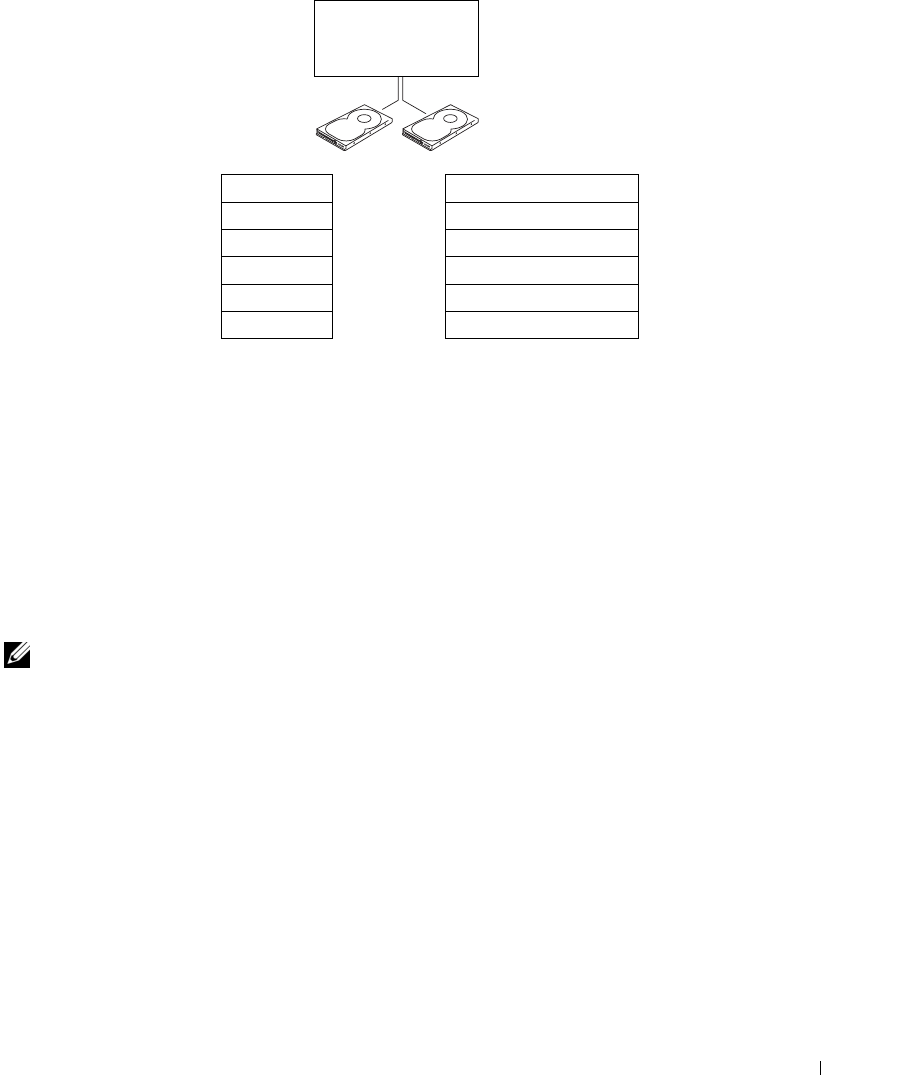
System Setup Program 117
If a drive failure occurs, subsequent read and write operations are directed to the surviving drive. A
replacement drive can then be rebuilt using the data from the surviving drive. Also, because data is
duplicated on both drives, a RAID level 1 configuration using two 120-GB hard drives collectively has a
maximum of 120 GB on which to store data.
Configuring Your Computer for RAID
At some point you may want to configure your computer for RAID if you did not select a RAID
configuration when you purchased your computer. You must have at least two hard drives installed in
your computer to set up a RAID configuration.
NOTE: Your computer was configured with RAID On as the default, whether or not you ordered RAID.
You can use one of two methods to configure RAID hard drive volumes. One method uses the Intel
RAID Option ROM utility and is performed before you install the operating system onto the hard drive.
The second method uses the Intel Matrix Storage Manager, or Intel Matrix Storage Console, and this
method is performed after you have installed the operating system and the Intel Matrix Storage Console.
Both methods require that you set your computer to RAID-enabled mode before starting any of the
RAID configuration procedures in this document.
Setting Your Computer to RAID-Enabled Mode
1
Enter system setup (see page 113).
2
Press the up- and down-arrow keys to highlight
Onboard Devices
, and press <Enter>.
3
Press the up- and down-arrow keys to highlight
SATA Operation
, and press <Enter>.
hard drive 1
segment 1
segment 2
segment 3
hard drive 2
segment 4
segment 5
segment 6
segment 1 duplicated
segment 2 duplicated
segment 3 duplicated
segment 4 duplicated
segment 5 duplicated
segment 6 duplicated
serial ATA RAID
configured for
RAID level 1

118 System Setup Program
4
Press the left- and right-arrow keys to highlight
RAID On
, and press <Enter>.
5
If the setting was changed
from
RAID Autodetect/ATA
to
RAID On
, a pop-up window displays. If the
pop-up window displays, press the left- and right-arrow keys to highlight
Yes
, and press <Enter>.
If the setting didn’t change
, the pop-up window will not display. Go on to step 6.
6
Press <Esc>.
NOTE: For more information about RAID options, see "System Setup Screens" on page 114.
7
Press the left- and right-arrow keys to highlight
Save/Exit
, and press <Enter> to exit system setup and
resume the boot process.
Configuring for RAID Using the Intel RAID Option ROM Utility
NOTE: Although any size drives may be used to create a RAID configuration using the Intel RAID Option ROM
utility, ideally the drives should be of equal size. In a RAID level 0 configuration, the size of the configuration will be
the size of the smallest drive multiplied by the number (two) of drives in the configuration. In a RAID level 1
configuration, the size of the configuration will be the smaller of the two drives used. If you want to migrate existing
data, see "Configuring for RAID Using the Intel Matrix Storage Manager" on page 119.
Creating a RAID Level 0 or a RAID Level 1 Configuration
NOTICE: You will lose any data on your hard drives when you create a RAID configuration using the following
procedure. Back up data you want to keep before continuing.
NOTE: Use the following procedure only if you are reinstalling your operating system. Do not use the following
procedure to migrate an existing storage configuration to RAID level 0 configuration.
1
Set your computer to RAID-enabled mode (see page 117).
2
Press <Ctrl><i> when you are prompted to enter the Intel
RAID Option ROM utility.
3
Press the up- and down-arrow keys to highlight
Create RAID Volume
, and press <Enter>.
4
Enter a RAID volume name or accept the default, and press <Enter>.
5
For RAID 0, press the up- and down-arrow keys to select
RAID0(Stripe)
, and press <Enter>.
For RAID 1, press the up- and down-arrow keys to select
RAID1(Mirror)
, and press <Enter>.
6
Press the up- and down-arrow keys and spacebar to select the two or three drives you want to use to
make up your configuration, and then press <Enter>.
NOTE: For RAID 0, select the strip size closest to the size of the average file you want to store on the RAID volume.
If you do not know the average file size, choose 128 KB as your strip size.
7
For RAID 0, press the up- and down-arrow keys to change the strip size, and press <Enter>.
For RAID 1, skip to step 8.
8
Select the desired capacity for the volume, and press <Enter>. The default value is the maximum
available size.
9
Press <Enter> to create the volume.
10
Press <y> to confirm that you want to create the RAID volume.

System Setup Program 119
11
Confirm that the correct volume configuration is displayed on the main Intel RAID Option ROM
utility screen.
12
Press the up- and down-arrow keys to select
Exit
, and press <Enter>.
13
Install the operating system.
Deleting a RAID Volume
NOTE: When you perform this operation, all data on the RAID drives will be lost.
NOTE: For RAID 0 only, if your computer currently boots to RAID and you delete the RAID volume in the Intel RAID
Option ROM utility, your computer will become unbootable.
1
Press <Ctrl><i> when you are prompted to enter the Intel RAID Option ROM utility.
2
Use the up- and down-arrow keys to highlight
Delete RAID Volume
, and press <Enter>.
3
Use the up- and down-arrow keys to highlight the RAID volume you want to delete, and press
<Delete>.
4
Press <y> to confirm the deletion of the RAID volume.
5
Press <Esc> to exit the Intel RAID Option ROM utility.
Configuring for RAID Using the Intel Matrix Storage Manager
If you already have one hard drive with the operating system installed on it, and you want to add a second
hard drive and reconfigure both drives into a RAID volume without losing the existing operating system
and any data, you need to use the migrating option (see "Migrating to a RAID Level 0 or a RAID Level 1
Configuration" on page 119).
Deleting a RAID Volume
NOTE: While this procedure deletes the RAID 1 volume, it also splits the RAID 1 volume into two non-RAID hard
drives with a partition, and leaves any existing data files intact.
1
Click the
Start
button and point to
All Programs
→
Intel Matrix Storage Manager
→
Intel Matrix
Storage Console
to launch the Intel Storage Console.
2
Right-click the
Volume
icon of the RAID volume you want to delete, and select
Delete Volume
.
3
On the
Delete RAID Volume Wizard
screen, click
Next
.
4
Highlight the RAID volume you want to delete in the
Available
box, click the right-arrow button to
move the highlighted RAID volume into the
Selected
box, and then click
Next
.
5
Click
Finish
to delete the volume.
Migrating to a RAID Level 0 or a RAID Level 1 Configuration
1
Set your computer to RAID-enabled mode (see page 117).
2
Click the
Start
button and point to
All Programs
→
Intel Matrix Storage Manager
→
Intel Matrix
Storage Console
to launch the Intel Storage Console.

120 System Setup Program
NOTE: If you do not see an Actions menu option, you have not yet set your computer to RAID-enabled mode (see
page 117).
3
On the
Actions
menu, select
Create RAID Volume From Existing Hard Drive
to
launch the
Migration Wizard.
4
Click
Next
on the Migration Wizard screen.
5
Enter a RAID volume name or accept the default.
6
For RAID 0, select
RAID 0
as the RAID level from the drop-down box
.
For RAID 1, select
RAID 1
as the RAID level from the drop-down box.
NOTE: Select the strip size closest to the size of the average file you want to store on the RAID volume. If you do
not know the average file size, choose 128 KB as your strip size.
7
For RAID 0, select the appropriate strip size from the drop-down box, and then click
Next
.
For RAID 1, skip to step 8.
NOTE: Select the hard drive that you want to use as your source hard drive (it should be the hard drive containing
the data or operating system files that you want to keep on the RAID volume).
8
On the
Select Source Hard Drive
screen, double-click the hard drive from which you want to migrate,
and click
Next
.
9
On the
Select Member Hard Drive
screen, double-click the hard drive to select the member drive to
span the array and click
Next
.
10
For RAID 0, on the
Specify Volume Size
screen, select the
Volume Size
you want, and click
Next
.
For RAID 1, skip to step 11.
NOTE: In the following step, you will lose all data contained on the member drive.
11
Click
Finish
to start migrating, or click
Back
to make changes. You can use your computer normally
during the migration process.
Rebuilding a Degraded RAID Level 1 Configuration
If your computer has reported a degraded RAID level 1 volume, contact Dell about replacing your hard
drive. See "Contacting Dell" on page 154.
You can manually rebuild the computer’s redundancy mirror to a new hard drive by performing the
following steps:
1
Click the
Start
button and point to
All Programs
→
Intel Matrix Storage Manager
→
Intel Matrix
Storage Console
to launch the Intel Storage Console.
2
Right-click the available hard drive to which you want to rebuild the RAID level 1 volume, and click
Rebuild to this Disk
.
You can use your computer while the computer is rebuilding the RAID level 1 volume.

Traveling With Your Computer 121
Traveling With Your Computer
Identifying Your Computer
• Attach a name tag or business card to the computer.
• Write down your Service Tag and store it in a safe place away from the computer or carrying case.
Use the Service Tag, which is located in the battery compartment of your computer (see
"Removing the Battery" on page 59), if you need to report a loss or theft to law enforcement
officials and to Dell. See "If Your Computer is Lost or Stolen" on page 89.
• Create a file on the Microsoft
®
Windows
®
desktop called
if_found
. Place information such as
your name, address, and phone number in this file.
• Contact your credit card company and ask if it offers coded identification tags.
Packing the Computer
• Remove any external devices attached to the computer and store them in a safe place.
• Fully charge the main battery and any spare batteries that you plan to carry with you.
• Shut down the computer.
• Disconnect the AC adapter.
NOTICE: When the display is closed, extraneous items on the keyboard or palm rest could damage the
display.
• Remove any extraneous items, such as paper clips, pens, and paper, from the keyboard and palm
rest and close the display.
• Use the optional Dell™ carrying case to pack the computer and its accessories together safely.
• Avoid packing the computer with items such as shaving cream, colognes, perfumes, or food.
NOTICE: If the computer has been exposed to extreme temperatures, allow it to acclimate to room
temperature for one hour before turning it on.
• Protect the computer, the batteries, and the hard drive from hazards such as extreme temperatures
and overexposure to sunlight, dirt, dust, or liquids.
• Pack the computer so that it does not slide around in the trunk of your car or in an overhead
storage compartment.

122 Traveling With Your Computer
Travel Tips
NOTICE: Do not move the computer while using the optical drive to prevent loss of data.
NOTE: Check with your airline when planning a trip. Due to the physical dimensions of your computer, it may not
qualify as carry-on luggage. If your computer does not qualify as carry-on luggage, purchase a hard-sided travel
case commonly available for shipping fragile electronics to enable you to check the computer as baggage.
• Consider disabling wireless activity on your computer to maximize battery operating time. To disable
wireless activity, press<Fn><F2>.
• Consider changing your power management options to maximize battery operating time. See
"Configuring Power Management Settings" on page 65.
• If you are traveling internationally, carry proof of ownership—or of your right to use the computer if it
is company-owned—to speed your passage through customs. Investigate the customs regulations of
the countries you plan to visit, and consider acquiring an international carnet (also known as a
merchandise passport
) from your government.
• Find out what type of electrical outlets are used in the countries you will visit, and have appropriate
power adapters.
• Check with your credit card company for information about the kinds of emergency travel assistance it
offers to users of portable computers.
Traveling by Air
NOTICE: Do not walk the computer through a metal detector. Send the computer through an X-ray machine or
have it hand-inspected.
CAUTION: Use On Aircraft: Regulations of the FCC and FAA prohibit airborne operation of radio-frequency
wireless devices because their signals could interfere with critical aircraft instruments.
• Ensure that you have a charged battery available in case you are asked to turn on the computer.
• Some airlines forbid the use of electronic devices during flight. All airlines forbid the use of electronic
devices during takeoff and landing.

Reinstalling Software 123
Reinstalling Software
Drivers
What Is a Driver?
A driver is a program that controls a device such as a printer, mouse, or keyboard. All devices require
a driver program.
A driver acts like a translator between the device and any other programs that use the device. Each
device has its own set of specialized commands that only its driver recognizes.
Dell ships your computer to you with required drivers already installed—no further installation or
configuration is needed.
NOTICE: The Drivers and Utilities CD may contain drivers for operating systems that are not on your
computer. Ensure that you are installing software appropriate for your operating system.
Many drivers, such as the keyboard driver, come with your Microsoft® Windows® operating system.
You may need to install drivers if you:
• Upgrade your operating system.
• Reinstall your operating system.
• Connect or install a new device.
Identifying Drivers
If you experience a problem with any device, identify whether the driver is the source of your
problem and, if necessary, update the driver.
1
Click the
Start
button and click
Control Panel
.
2
Under
Pick a Category
, click
Performance and Maintenance
.
3
Click
System
.
4
In the
System Properties
window, click the
Hardware
tab.
5
Click
Device Manager
.
6
Scroll down the list to see if any device has an exclamation point (a yellow circle with a [
!]
) on the
device icon.
If an exclamation point is next to the device name, you may need to reinstall the driver or install a
new driver. See "Reinstalling Drivers and Utilities" on page 124.

124 Reinstalling Software
Reinstalling Drivers and Utilities
NOTICE: The Dell Support website at support.dell.com and your Drivers and Utilities CD provide approved drivers
for Dell™ computers. If you install drivers obtained from other sources, your computer might not work correctly.
Using Windows XP Device Driver Rollback
If a problem occurs on your computer after you install or update a driver, use Windows XP Device Driver
Rollback to replace the driver with the previously installed version.
1
Click the
Start
button and click
Control Panel
.
2
Under
Pick a Category
, click
Performance and Maintenance
.
3
Click
System
.
4
In the
System Properties
window, click the
Hardware
tab.
5
Click
Device Manager
.
6
Right-click the device for which the new driver was installed and click
Properties
.
7
Click the
Drivers
tab.
8
Click
Roll Back Driver
.
If Device Driver Rollback does not resolve the problem, then use System Restore to return your
computer to the operating state that existed before you installed the new driver. See "Using Microsoft
Windows XP System Restore" on page 126.
Using the Drivers and Utilities CD
If using Device Driver Rollback or System Restore does not resolve the problem, then reinstall the driver
from the Drivers and Utilities CD (also known as the ResourceCD).
1
With the Windows desktop displayed, insert the
Drivers and Utilities CD
.
If this is your first time to use the
Drivers and Utilities CD
, go to step 2. If not, go to step 5.
2
When the
Drivers and Utilities CD
installation program starts, follow the prompts on the screen.
3
When the
InstallShield Wizard Complete
window appears, remove the
Drivers and Utilities CD
and
click
Finish
to restart the computer.
4
When you see the Windows desktop, reinsert the
Drivers and Utilities CD
.
5
At the
Welcome Dell System Owner
screen, click
Next
.
NOTE: The Drivers and Utilities CD displays drivers only for hardware that came installed in your computer. If
you installed additional hardware, the drivers for the new hardware might not be displayed by the Drivers and
Utilities CD. If those drivers are not displayed, exit the Drivers and Utilities CD program. For drivers information, see
the documentation that came with the device.
A message stating that the
Drivers and Utilities CD
is detecting hardware in your computer appears.

Reinstalling Software 125
The drivers that are used by your computer are automatically displayed in the
My Drivers—The
ResourceCD has identified these components in your system
window.
6
Click the driver that you want to reinstall and follow the instructions on the screen.
If a particular driver is not listed, then that driver is not required by your operating system.
1
Save and close any open files, and exit any open programs.
2
Insert the
Drivers and Utilities
CD.
In most cases, the CD starts running automatically. If it does not, start Windows Explorer, click your
CD drive directory to display the CD contents, and then double-click the
autorcd.exe
file. The first
time that you run the CD, it might prompt you to install setup files. Click
OK
, and follow the
instructions on the screen to continue.
3
From the
Language
drop-down menu in the toolbar, select your preferred language for the driver or
utility (if available). A welcome screen appears.
4
Click
Next
.
The CD automatically scans your hardware to detect drivers and utilities used by your computer.
5
After the CD completes the hardware scan, you can also detect other drivers and utilities. Under
Search Criteria
, select the appropriate categories from the
System Model
,
Operating System
, and
Topic
drop-down menus.
A link or links appear(s) for the specific drivers and utilities used by your computer.
6
Click the link of a specific driver or utility to display information about the driver or utility that you
want to install.
7
Click the
Install
button (if present) to begin installing the driver or utility. At the welcome screen,
follow the screen prompts to complete the installation.
If no
Install
button is present, automatic installation is not an option. For installation instructions,
either see the appropriate instructions in the following subsections, or click
Extract
, follow the
extracting instructions, and then read the readme file.
If instructed to navigate to the driver files, click the CD directory on the driver information window to
display the files associated with that driver.
Manually Reinstalling Drivers
1
After extracting the driver files to your hard drive as described in the previous section, click the
Start
button and right-click
My Computer
.
2
Click
Properties
.
3
Click the
Hardware
tab and click
Device Manager
.
4
Double-click the type of device for which you are installing the driver (for example,
Modems
or
Infrared devices
).
5
Double-click the name of the device for which you are installing the driver.

126 Reinstalling Software
6
Click the
Driver
tab and click
Update Driver
.
7
Click
Install from a list or specific location (Advanced)
and click
Next
.
8
Click
Browse
and browse to the location to which you previously copied the driver files.
9
When the name of the appropriate driver appears, click
Next
.
10
Click
Finish
and restart your computer.
Resolving Software and Hardware Incompatibilities
If a device is either not detected during the operating system setup or is detected but incorrectly
configured, you can use the Hardware Troubleshooter to resolve the incompatibility.
1
Click the
Start
button and click
Help and Support
.
2
Ty p e
hardware troubleshooter
in the
Search
field and click the arrow to start the search.
3
Click
Hardware Troubleshooter
in the
Search Results
list.
4
In the
Hardware Troubleshooter
list, click
I need to resolve a hardware conflict on my computer
, and
click
Next
.
Restoring Your Operating System
You can restore your operating system in the following ways:
• Microsoft Windows XP System Restore returns your computer to an earlier operating state without
affecting data files. Use System Restore as the first solution for restoring your operating system and
preserving data files.
• If you received an
Operating System
CD with your computer, you can use it to restore your operating
system. However, using the
Operating System
CD also deletes all data on the hard drive. Use the CD
only
if System Restore did not resolve your operating system problem.
Using Microsoft Windows XP System Restore
The Microsoft Windows XP operating system provides System Restore to allow you to return your
computer to an earlier operating state (without affecting data files) if changes to the hardware, software,
or other system settings have left the computer in an undesirable operating state. See the Windows Help
and Support Center for information on using System Restore. To access the Windows Help and Support
Center, see "Windows Help and Support Center" on page 15.
NOTICE: Make regular backups of your data files. System Restore does not monitor your data files or recover
them.
NOTE: The procedures in this document were written for the Windows default view, so they may not apply if you
set your Dell computer to the Windows Classic view.

Reinstalling Software 127
Creating a Restore Point
1
Click the
Start
button and click
Help and Support
.
2
Click the task for
System Restore
.
3
Follow the instructions on the screen.
Restoring the Computer to an Earlier Operating State
If problems occur after you install a device driver, use Device Driver Rollback (see page 124) to resolve
the problem. If that is unsuccessful, then use System Restore.
NOTICE: Before you restore the computer to an earlier operating state, save and close any open files and exit any
open programs. Do not alter, open, or delete any files or programs until the system restoration is complete.
1
Click the
Start
button, point to
All Programs
→
Accessories
→
System Tools
, and then click
System
Restore
.
2
Ensure that
Restore my computer to an earlier time
is selected and click
Next
.
3
Click a calendar date to which you want to restore your computer.
The
Select a Restore Point
screen provides a calendar that allows you to see and select restore points.
All calendar dates with available restore points appear in boldface type.
4
Select a restore point and click
Next
.
If a calendar date has only one restore point, then that restore point is automatically selected. If two or
more restore points are available, click the restore point that you prefer.
5
Click
Next
.
The
Restoration Complete
screen appears after System Restore finishes collecting data and then the
computer restarts.
6
After the computer restarts, click
OK
.
To change the restore point, you can either repeat the steps using a different restore point, or you can
undo the restoration.
Undoing the Last System Restore
NOTICE: Before you undo the last system restore, save and close all open files and exit any open programs. Do not
alter, open, or delete any files or programs until the system restoration is complete.
1
Click the
Start
button, point to
All Programs
→
Accessories
→
System Tools
, and then click
System
Restore
.
2
Click
Undo my last restoration
and click
Next
.

128 Reinstalling Software
Enabling System Restore
If you reinstall Windows XP with less than 200 MB of free hard-disk space available, System Restore is
automatically disabled. To see if System Restore is enabled:
1
Click the
Start
button and click
Control
Panel
.
2
Click
Performance and Maintenance
.
3
Click
System
.
4
Click the
System Restore
tab.
5
Ensure that
Turn off System Restore
is unchecked.
Using the Operating System CD
Before You Begin
If you are considering reinstalling the Windows XP operating system to correct a problem with a newly
installed driver, first try using Windows XP Device Driver Rollback. See "Using Windows XP Device
Driver Rollback" on page 124. If Device Driver Rollback does not resolve the problem, then use
System
Restore
to return your operating system to the operating state it was in before you installed the new
device driver. See "Using Microsoft Windows XP System Restore" on page 126.
NOTICE: Before performing the installation, back up all data files on your primary hard drive. For conventional
hard drive configurations, the primary hard drive is the first drive detected by the computer.
To reinstall Windows XP, you need the following items:
• Dell
Operating System
CD
•Dell
Drivers and Utilities
CD
NOTE: The Drivers and Utilities CD contains drivers that were installed during assembly of the computer. Use the
Drivers and Utilities CD to load any required drivers, including the drivers required if your computer has a RAID
controller. Depending on the region from where you ordered your computer, or whether you requested the CDs, the
Drivers and Utilities CD and Operating System CD may not ship with your system.
Reinstalling Windows XP
The reinstallation process can take one to two hours to complete. After you reinstall the operating
system, you must also reinstall the device drivers, virus protection program, and other software.
NOTICE: The Operating System CD provides options for reinstalling Windows XP. The options can overwrite files
and possibly affect programs installed on your hard drive. Therefore, do not reinstall Windows XP unless a Dell
technical support representative instructs you to do so.
1
Save and close any open files and exit any open programs.
2
Insert the
Operating System
CD. Click
Exit
if the
Install Windows XP
message appears.
3
Restart the computer.

Reinstalling Software 129
4
Press <F2> immediately after the DELL™ logo appears.
If the operating system logo appears, wait until you see the Windows desktop, and then shut down the
computer and try again.
5
Follow the instructions on the screen to complete the installation.

130 Reinstalling Software

Adding and Replacing Parts 131
Adding and Replacing Parts
Before You Begin
This chapter provides procedures for removing and installing the components in your computer.
Unless otherwise noted, each procedure assumes that the following conditions exist:
• You have performed the steps in "Turning Off Your Computer" on page 131 and "Before Working
Inside Your Computer" on page 131.
• You have read the safety information in your Dell™
Product Information Guide.
Recommended Tools
The procedures in this document may require the following tools:
• Small flat-blade screwdriver
• Philips screwdriver
• Flash BIOS update (see the Dell Support website at
support.dell.com
)
Turning Off Your Computer
NOTICE: To avoid losing data, save and close any open files and exit any open programs before you turn off
your computer.
1
Shut down the operating system:
a
Save and close any open files, exit any open programs, click the
Start
button, and then click
Turn Off Computer
.
b
In the
Turn off computer
window, click
Turn o ff
.
The computer turns off after the operating system shutdown process finishes.
2
Ensure that the computer and any attached devices are turned off. If your computer and attached
devices did not automatically turn off when you shut down your operating system, press and hold
the power button for at least 8–10 seconds until the computer turns off.
Before Working Inside Your Computer
Use the following safety guidelines to help protect your computer from potential damage and to
help ensure your own personal safety.
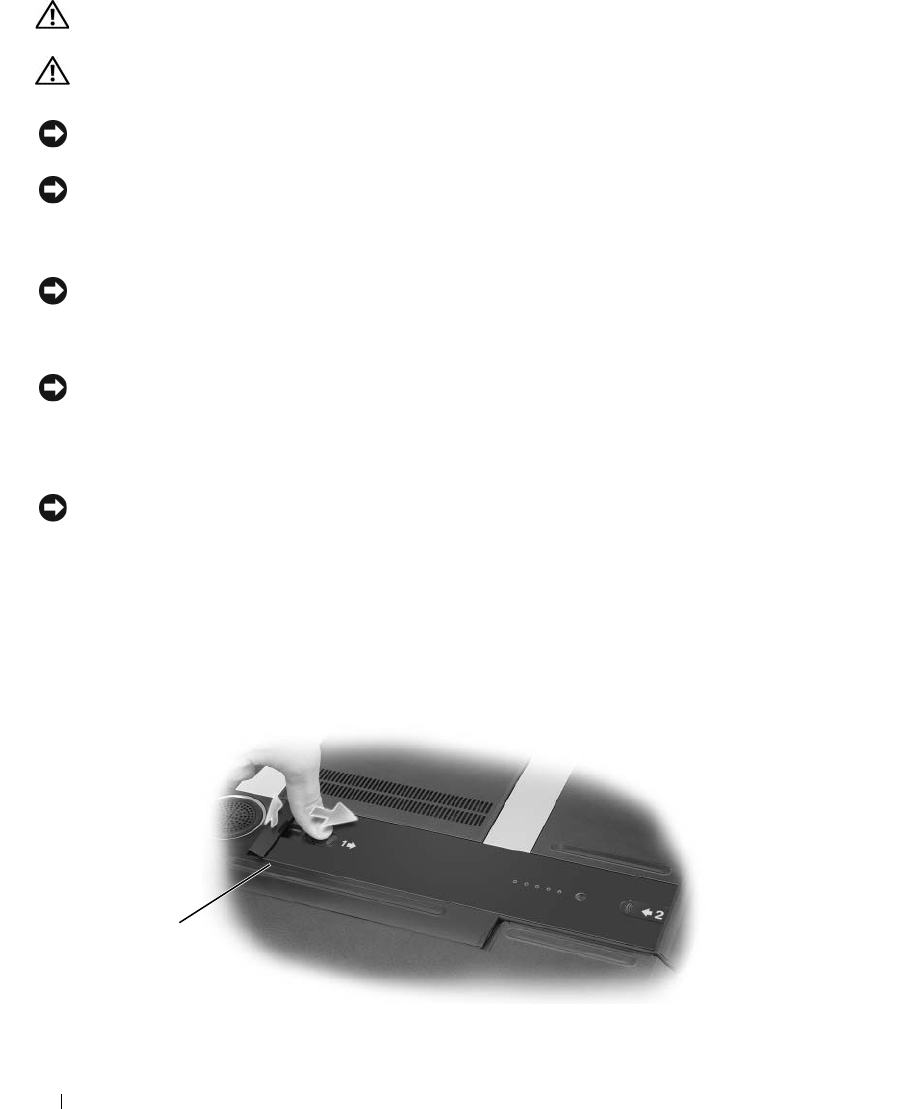
132 Adding and Replacing Parts
CAUTION: Before you begin any of the procedures in this section, follow the safety instructions in the Product
Information Guide.
CAUTION: Handle components and cards with care. Do not touch the components or contacts on a card. Hold a card
by its edges or by its metal mounting bracket. Hold a component such as a processor by its edges, not by its pins.
NOTICE: Only a certified service technician should perform repairs on your computer. Damage due to servicing
that is not authorized by Dell is not covered by your warranty.
NOTICE: When you disconnect a cable, pull on its connector or on its strain-relief loop, not on the cable itself.
Some cables have a connector with locking tabs; if you are disconnecting this type of cable, press in on the locking
tabs before you disconnect the cable. As you pull connectors apart, keep them evenly aligned to avoid bending any
connector pins. Also, before you connect a cable, ensure that both connectors are correctly oriented and aligned.
NOTICE: To avoid damaging the computer, perform the following steps before you begin working inside the computer.
1
Ensure the work surface is clean and flat to prevent the computer cover from being scratched.
2
Turn off your computer. See "Turning Off Your Computer" on page 131.
NOTICE: To disconnect a network cable, first unplug the cable from your computer and then unplug it from the
network wall jack.
3
Disconnect any telephone or network cables from the computer.
4
Disconnect your computer and all attached devices from their electrical outlets.
NOTICE: To avoid damaging the system board, you must remove the main battery before you service the computer.
5
Remove the system battery.
a
Ensure the keyboard is securely attached and the display is closed and latched before turning the
computer over. See "Closing the Display Panel" on page 51. Then place the computer upside down
on the work surface.
b
Slide the battery-bay latch release lock on the bottom of the computer in the direction of the #1
arrow. The battery access door will pop up.
1battery access door
1
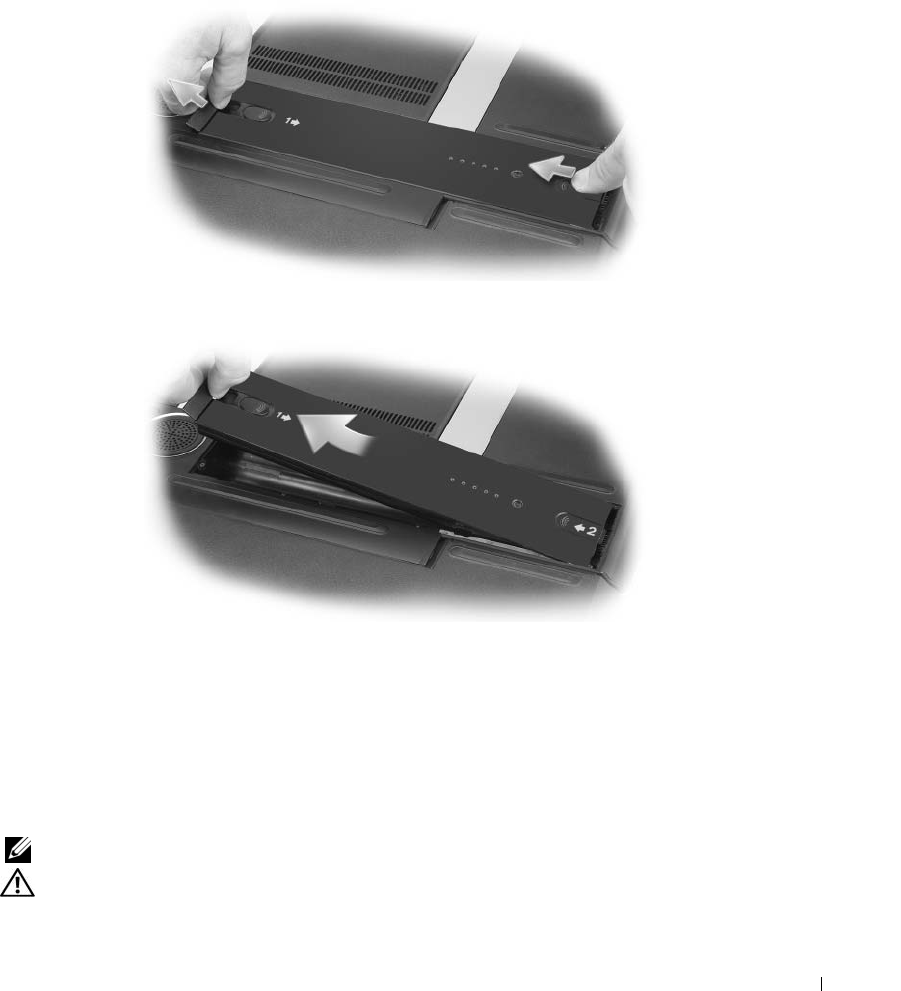
Adding and Replacing Parts 133
c
Using your thumbs, slide the battery in the direction of the #2 arrow by inserting one thumb into
the recess next to the battery access door and the other thumb into the indention surrounding
the #2.
d
Lift the battery straight up and out of the computer.
6
Press the power button to ground the system board.
7
Remove any installed ExpressCards or media memory cards. See "Removing a Card" on page 85.
Memory
You can increase your computer memory by installing memory modules on the system board. See
"Specifications" on page 141 for information on the memory supported by your computer. Install only
memory modules that are intended for your computer.
NOTE: Memory modules purchased from Dell are covered under your computer warranty.
CAUTION: Before you begin any of the procedures in this section, follow the safety instructions in the Product
Information Guide.
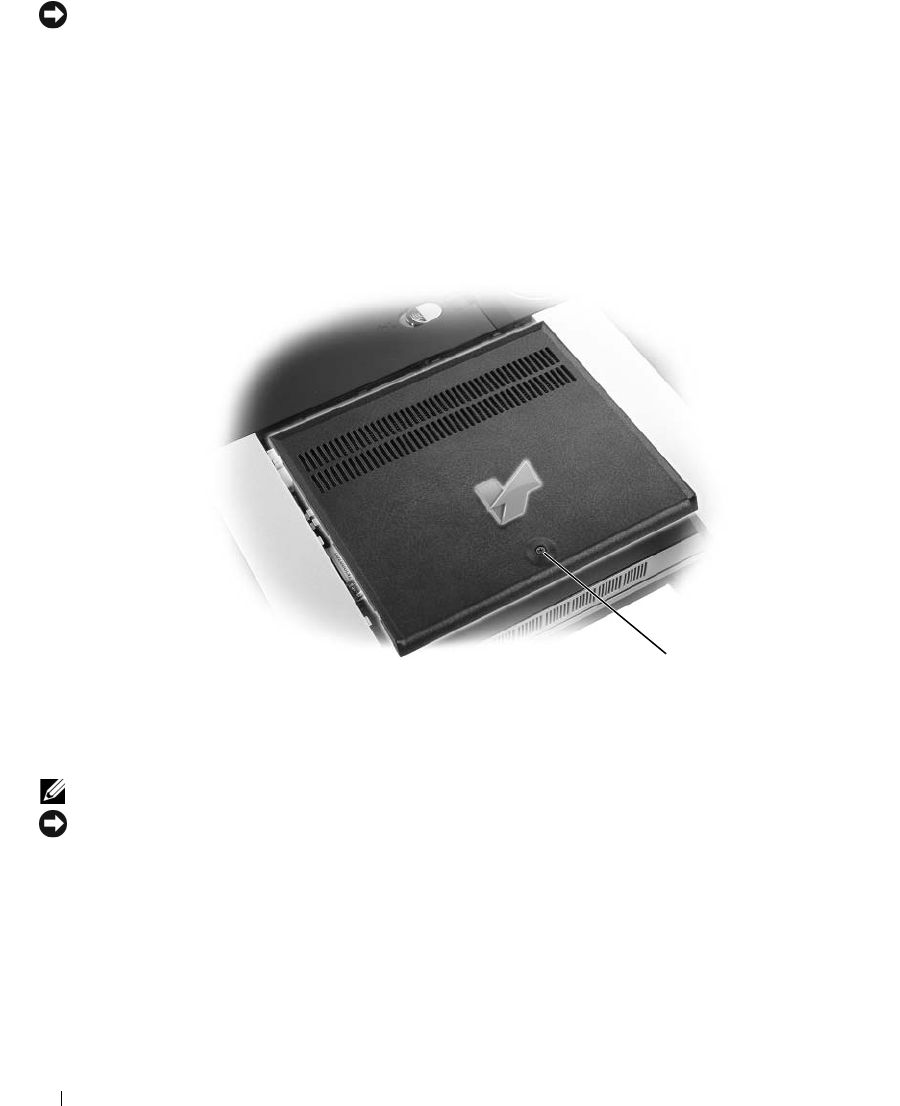
134 Adding and Replacing Parts
NOTICE: To avoid damaging the system board, you must remove the main battery before you begin working inside
the computer. See "Replacing the Battery" on page 57.
The computer has two memory slots, DIMM A and DIMM B, located under the memory module cover.
If you replace or upgrade the memory in your computer, both memory modules must be the same size.
To install a memory module in DIMM A or DIMM B:
1
Follow the procedures in "Before You Begin" on page 131.
2
Turn the computer over, loosen the captive screw on the memory cover, and then remove the cover by
sliding it toward the back of the computer to disengage the tabs on the base from the notches in the
cover, then lifting the cover off.
3
Ground yourself by touching one of the metal connectors on the back of the computer.
NOTE: If you leave the area, ground yourself again when you return to the computer.
NOTICE: To prevent damage to the memory module connector, do not use tools to spread the memory-module
securing clips.
4
If you are replacing a memory module, remove the existing module:
a
Use your fingertips to carefully spread apart the securing clips on each end of the memory module
connector until the module pops up.
b
Remove the module from the connector.
1captive screw
1
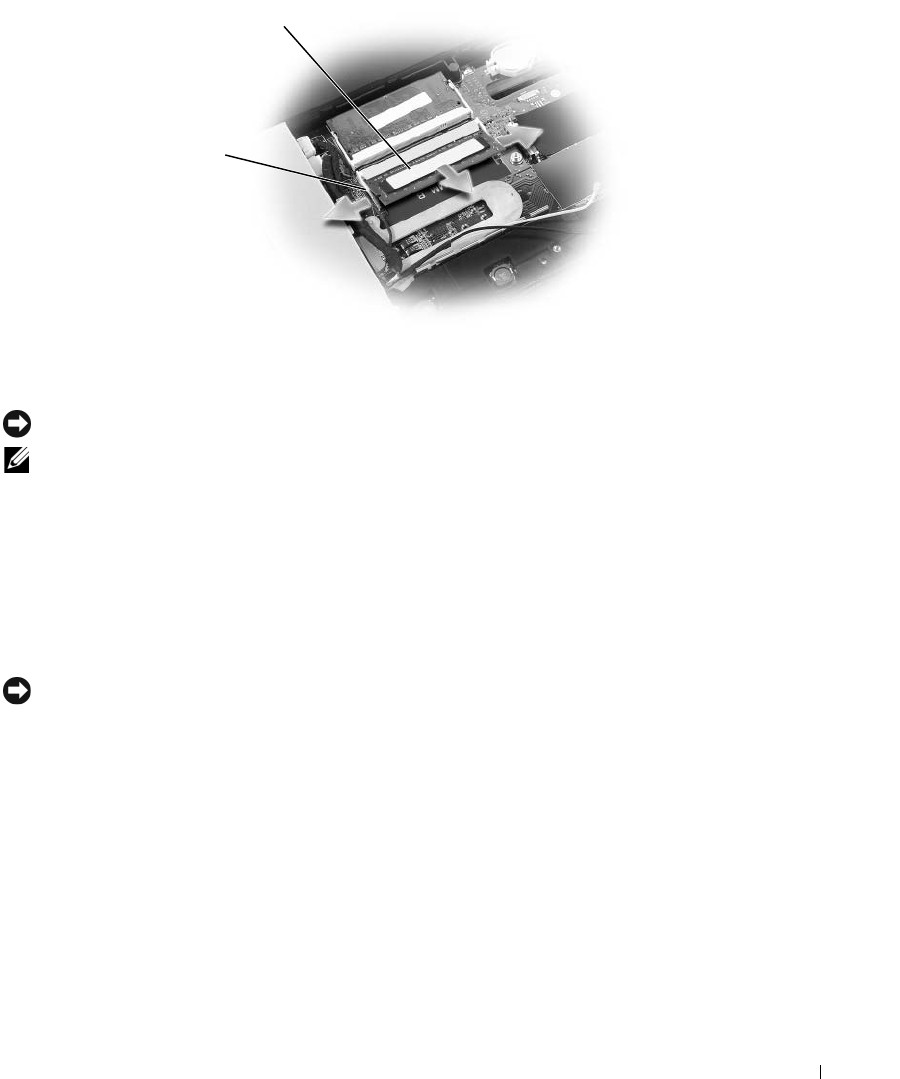
Adding and Replacing Parts 135
NOTICE: Insert memory modules at a 45-degree angle to avoid damaging the connector.
NOTE: If the memory module is not installed properly, the computer may not boot properly. No error message
indicates this failure.
5
Ground yourself and install the new memory module:
a
Align the notch in the module edge connector with the tab in the connector slot.
b
Slide the module firmly into the slot at a 45-degree angle, and rotate the module down until it
clicks into place. If you do not feel the click, remove the module and reinstall it.
6
Replace the memory cover by aligning the notches in the cover with the tabs on the base and sliding
the cover toward the front of the computer, then tighten the screw.
NOTICE: If the cover is difficult to close, remove the module and reinstall it. Forcing the cover to close may
damage your computer.
7
Insert the battery into the battery bay, or connect the AC adapter to your computer and an electrical
outlet.
8
Turn on the computer.
As the computer boots, it detects the additional memory and automatically updates the system
configuration information.
To confirm the amount of memory installed in the computer, click the Start button, click Help and
Support, and then click Computer Information.
1securing clips (2 per
connector)
2memory module
1
2
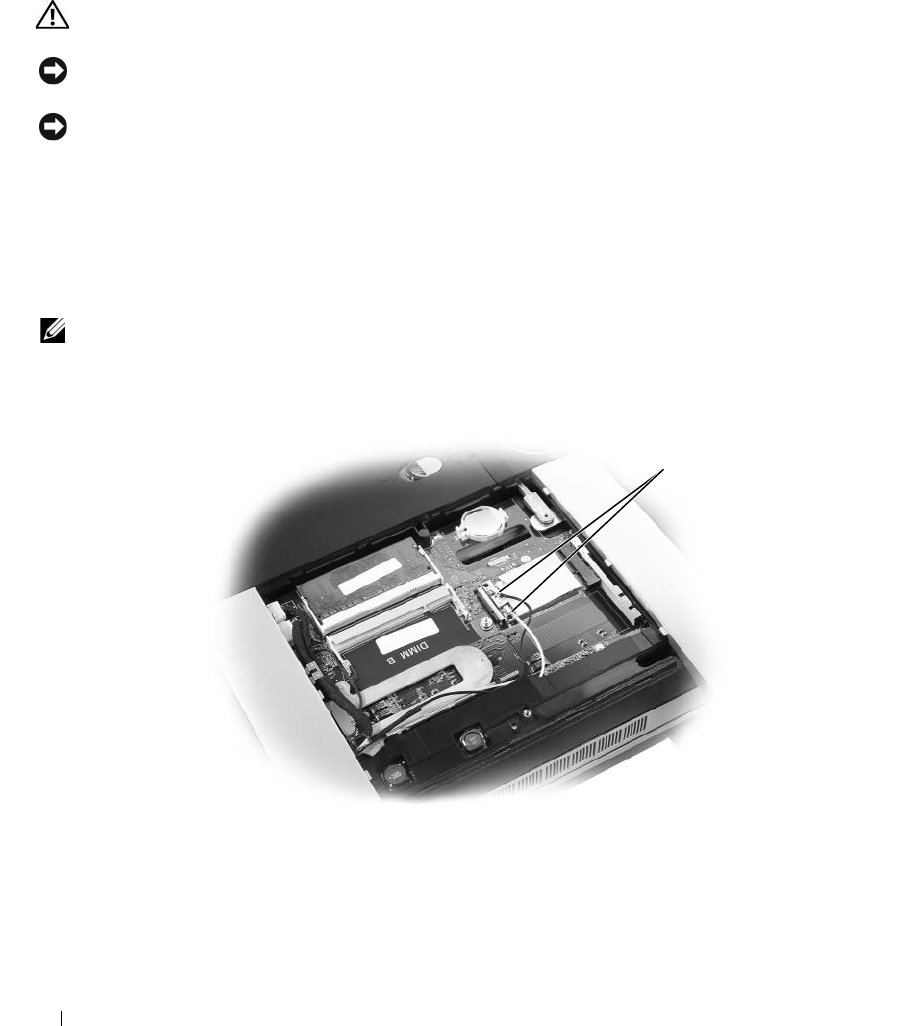
136 Adding and Replacing Parts
Mini PCI-e Card
If you ordered a wireless LAN (WLAN) card with your computer, the card is already installed.
CAUTION: Before you begin any of the procedures in this section, follow the safety instructions in the Product
Information Guide.
NOTICE: To avoid electrostatic discharge, ground yourself by using a wrist grounding strap or by periodically
touching a connector on the back panel of the computer.
NOTICE: To avoid damaging the system board, you must remove the main battery before you begin working inside
the computer.
WLAN Cards
1
Follow the procedures in "Before You Begin" on page 131.
2
Remove the memory cover. See "Memory" on page 133.
3
Ground yourself by touching one of the metal connectors on the back of the computer.
NOTE: If you leave the area, ground yourself again when you return to the computer.
4
If a card is not already installed, go to step 5. If you are replacing a card, remove the existing card:
a
Disconnect the antenna cables from the card.
1antenna cables
1
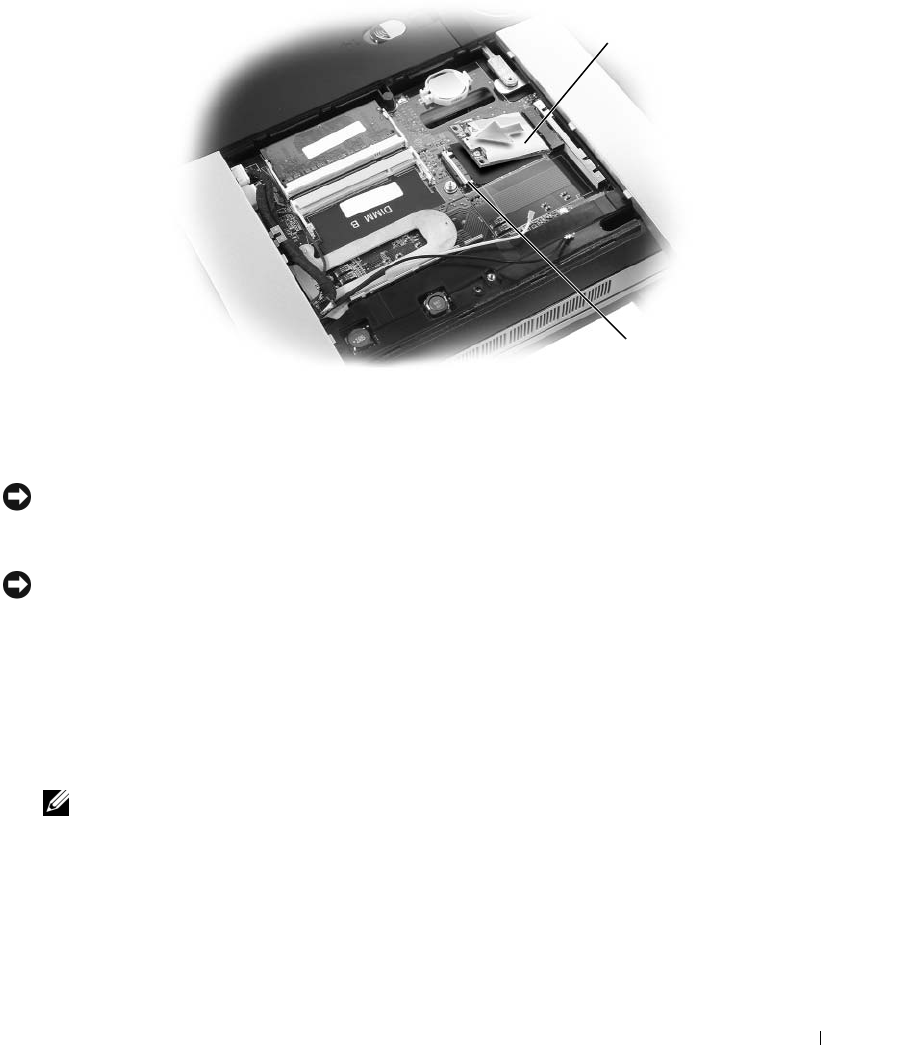
Adding and Replacing Parts 137
b
Release the card by pressing the metal securing tabs until the card pops up slightly.
c
Lift the card out of its connector.
NOTICE: The connectors are keyed to ensure correct insertion. If you feel resistance, check the connectors and
realign the card.
5
Install the card:
NOTICE: To avoid damaging the card, ensure that the antenna cable is not under the card when you click the card
into place.
a
Align the card with the connector at a 45-degree angle, and press the card into the connector until
it clicks.
b
Connect the antenna cable to the antenna connector on the mini-card by matching the color of
the cable to the color of the triangle above the connector. Connect the main cable (white) to the
antenna connector with the white triangle. Connect the auxiliary cable (black) to the antenna
connector with the black triangle.
NOTE: If your computer has a gray cable, connect it to the connector with the gray triangle, if one is available
on your card.
6
Replace the memory cover. See "Memory" on page 133.
7
Insert the battery into the battery bay, or connect the AC adapter to your computer and an electrical
outlet.
8
Turn on the computer.
1Mini-PCI-e card 2metal securing tabs (2)
1
2
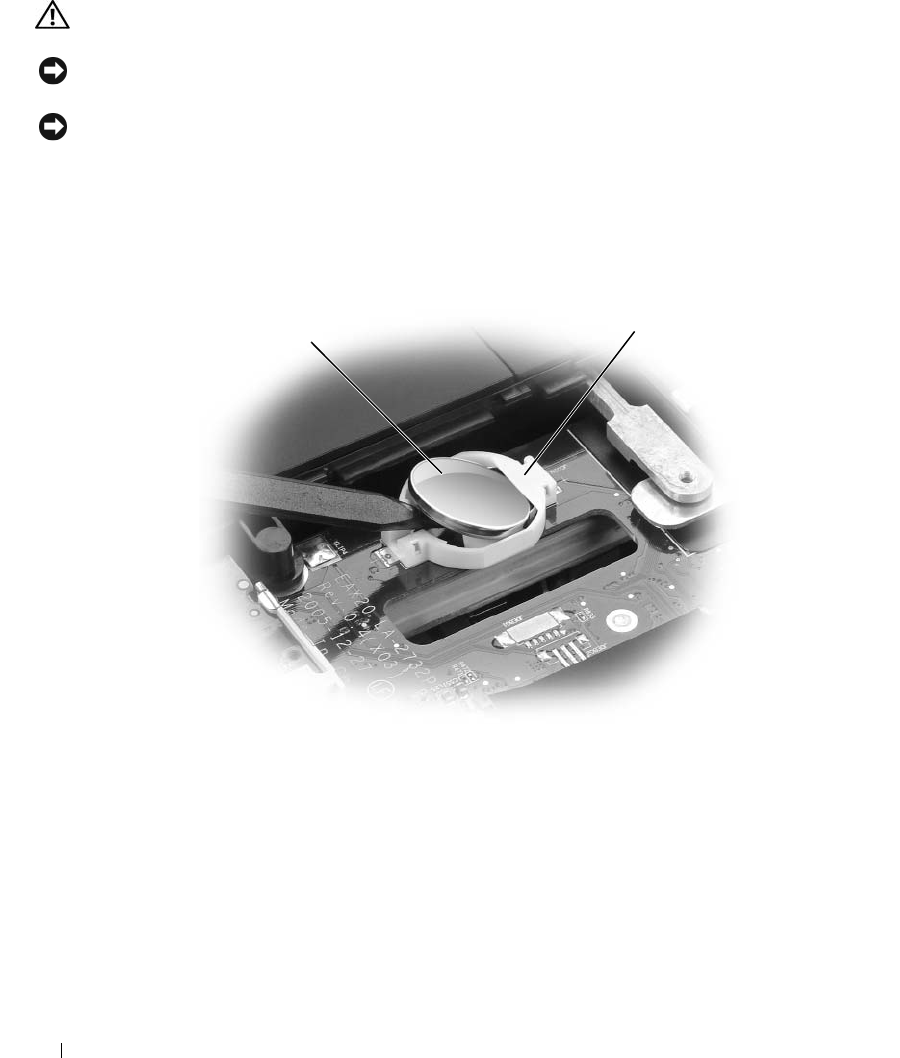
138 Adding and Replacing Parts
Coin-Cell Battery
CAUTION: Before performing the following procedures, follow the safety instructions in your Product
Information Guide.
NOTICE: To avoid electrostatic discharge, ground yourself by using a wrist grounding strap or by periodically
touching a connector on the back panel of the computer.
NOTICE: To avoid damaging the system board, you must remove the main battery before you begin working inside
the computer.
To remove the coin-cell battery:
1
Follow the procedures in "Before You Begin" on page 131.
2
Remove the memory cover. See "Memory" on page 133.
3
Remove the battery from the compartment on the system board by using a small screwdriver to lift one
side of the battery at the notch in the plastic connector, being careful not to break the plastic.
4
Grasp the battery and pull out it of the battery compartment.
To install the coin-cell battery:
1
Insert the edge of the coin-cell battery into the plastic battery compartment under the lip on the
compartment.
2
Carefully press the coin-cell battery into the compartment, being careful not to break the plastic.
1coin-cell battery 2battery compartment
2
1

Dell QuickSet 139
Dell QuickSet
NOTE: This feature may not be available on your computer.
Dell™ QuickSet provides you with easy access to configure or view the following types of settings:
• Network connectivity
• Power management
•Display
• System information
Depending on what you want to do in Dell QuickSet, you can start it by either clicking, double-
clicking, or right-clicking the QuickSet icon, , in the Microsoft® Windows® taskbar. The taskbar
is located in the lower-right corner of your screen.
For more information about QuickSet, right-click the QuickSet icon and select Help.

140 Dell QuickSet

Specifications 141
Specifications
Processor
Processor type Intel® Core™ Duo processor
L1 cache 64 KB (internal)
L2 cache 2 MB (on die)
External bus frequency 533 or 667 MHz
System Information
System chipset Mobile Intel 945
Data bus width 64 bits
DRAM bus width 64 bits
Processor address bus width 36 bits
Memory
Memory module connector two user-accessible SODIMM sockets
Memory module capacities 256, 512, 1024 MB; 2 GB
Memory type dual channel 533/667 DDRII SDRAM
Minimum memory 512 MB
Maximum memory 4 GB
Ports and Connectors
Audio microphone-in connector, stereo
headphones/speakers connector
IEEE 1394a 4-pin mini, nonpowered connector
Modem RJ-11 port
Network adapter RJ-45 port
S-video TV-out 7-pin mini-DIN connector (optional S-video
to composite video adapter cable; optional
S-video to component video adapter cable)
USB four 4-pin USB 2.0-compliant connectors

142 Specifications
DVI-I (Digital Video Interface) 24-pin connector
Audio/IR blaster connector
Communications
Modem:
Ty p e
v.92 56K MDC
Controller
softmodem
Interface
Intel HDA bus
Network adapter 1 GB Ethernet LAN on system board
Wireless internal WLAN and Bluetooth® wireless
support, WWAN via ExpressCard,
Graphics
Controller ATI Radeon Mobility X1800
Data bus PCI Express X16
Video memory 256MB DDR3
LCD interface LVDS
TV support NTSC and PAL (s-video, composite, or
component-out); HDTV (component-out or
DVI with HDCP)
Audio
Audio type High Definition Audio (Soft Audio)
Audio controller SigmaTel STAC9220
Stereo conversion 24-bit (stereo digital-to-analog),
24-bit (stereo analog-to-digital)
Interfaces:
Internal
High Definition Audio Bus (HDA)
External
microphone miniconnector, stereo
headphones/speakers miniconnector
Speaker Eight 4-ohm speakers (16 ohm total) in the
display
One 12-ohm subwoofer speaker in the base
Ports and Connectors (continued)

Specifications 143
Internal speaker amplifier 5-W/channel into 16 ohm in the display
(10 W total)
5-W/channel into 12 ohm subwoofer in the
base (5 W total)
15 W total system power
Volume controls Keyboard shortcuts or program menus
Display
Type (active-matrix TFT) WSXGA+
Dimensions:
Height
453.5 mm typ (17.85 inches)
Width
294.5 typ (11.59 inches)
Diagonal
511.1 typ (20.1 inches)
Operating angle 0° (closed) to 180°
Viewing angles:
Horizontal
85/85°
Vertical
85/85°
Aspect ratio 16:10
Pixel pitch 0.2588 mm
Supports RGB the international standard of color
reproduction
8-bit color depth 16.7 M colors
Surface treatment Glare polarizer
Power Consumption (
panel with
backlight)
16.6 W (typ)
Controls brightness can be controlled through
keyboard shortcuts
Audio (continued)

144 Specifications
Keyboard
Wireless interface to system base with Bluetooth wireless technology
Number of keys 100 (U.S.); 101 (Europe); 105 (Japan)
Key travel:
Regular keys
3.0 mm ± 0.3 mm (0.12 inch ± 0.01 inch)
Hot keys
1.5 mm ± 0.2 mm (0.59 inch ± 0.01 inch)
Touch pad buttons
1.5 mm ± 0.2 mm(0.59 inch ± 0.01 inch)
Key spacing 19.05 mm ± 0.3 mm (0.75 inch ± 0.012
inch)
Layout QWERTY/AZERTY/Kanji
Touch Pad
X/Y position resolution
(graphics table mode) 1000 dpi
Size:
Width
60.75-mm (2.39-inch) sensor-active area
Height
44.64-mm (1.60-inch) rectangle
Battery
Dual 6-cell lithium-ion battery pack
2.6 Ahr cells
Dimensions:
Depth
296.3 mm (11.67 inches)
Height
31.7 mm (1.25 inch)
Width
65.4 mm (2.57 inches)
Weight 0.730 kg (1.61 lb) typical
Voltage 14.8 VDC
Operating time varies depending on operating conditions
and can be significantly reduced under
certain power-intensive conditions
See "Battery Performance" on page 60 for
more information.
Life span (approximate) 300 discharge/charge cycles

Specifications 145
Temperature range:
Operating
0° to 35°C (32° to 95°F)
Storage
–40° to 65°C (–40° to 149°F)
AC Adapter
Input voltage 100–240 VAC
Input current (maximum) 2.5 A
Input frequency 50–60 Hz
Output current 7.7 A
Output power 150 W
Rated output voltage 19.5 VDC
Dimensions:
Height
40 mm (1.57 inches)
Width
85 mm (3.35 inches)
Length
170 mm (6.69 inches)
Weight (with cables) 1 kg (2.2 lb)
Temperature range:
Operating
0° to 35°C (32° to 95°F)
Storage
–40° to 65°C (–40° to 149°F)
Physical
Height 75.3 mm (2.9 inches)
Width 470 mm (18.5 inches)
Depth 405.6 mm (15.9 inches)
Weight approximately 18.1 lb depending upon
configuration
Battery (continued)

146 Specifications
ExpressCard
NOTE: The ExpressCard slot is designed only for ExpressCards. It does NOT support
PC Cards.
ExpressCard connector one ExpressCard slot (54 mm)
1.5 V and 3.3 V
Cards supported ExpressCard/34 (34 mm) and
ExpressCard/54 (54 mm)
ExpressCard connector size 26 pins
Media Memory Card Reader
Media memory card reader with two slots (13 in 2)
Media memory card controller Ricoh R5C832
Media memory card connector combo card connector
Cards supported MS
MS Duo
MS Duo Pro
SD/SDIO
MiniSD
MMC
RSMMC
xD
CF Type I/II
Microdrive
Camera
Type Logitech 1.3 MP Camera Module
Sensor type 1.3 megapixel CMOS with RightLight low
light enhancement technology
Video capture resolution Up to 640x480 pixels (VGA)
Still image capture resolution True 1280x960 pixels (1.3 megapixels); up to
4 megapixels software-enhanced
Frame rate Up to 30 frames per second
Field of view 58 degrees (measured diagonally)
Interface Internal USB 2.0 high-speed
Activity light Blue LED to indicate video streaming
Manual tilt range -15 degrees down/+35 degrees up (vertical)
Software Logitech QuickCam

Specifications 147
Environmental
Temperature range:
Operating
0° to 35°C (32° to 95°F)
Storage
–40° to 65°C (–40° to 149°F)
Relative humidity (maximum):
Operating
10% to 90% (noncondensing)
Storage
5% to 95% (noncondensing)
Maximum vibration (using a
random-vibration spectrum that
simulates user environment):
Operating
0.66 GRMS
Storage
1.30 GRMS
Maximum shock (measured with
hard drive in head-parked position
and a 2-ms half-sine pulse):
Operating
122 G
Storage
163 G
Altitude (maximum):
Operating
–15.2 to 3048 m (–50 to 10,000 ft)
Storage
–15.2 to 10,668 m (–50 to 35,000 ft)

148 Specifications

Obtaining Assistance 149
Obtaining Assistance
CAUTION: If you need to remove the computer covers, first disconnect the computer power and modem
cables from all electrical outlets.
1
Complete the procedures in "Troubleshooting" on page 91.
2
Run the Dell Diagnostics (see "Dell Diagnostics" on page 91).
3
Make a copy of the Diagnostics Checklist (see "Diagnostics Checklist" on page 153) and fill it out.
Note that your Service Tag is located in the battery compartment of your computer (see
"Removing the Battery" on page 59).
4
Use Dell's extensive suite of online services available at Dell Support (
support.dell.com
) for help
with installation and troubleshooting procedures.
5
If the preceding steps have not resolved the problem, contact Dell.
NOTE: Call the support service from a telephone near or at the computer so that the support staff can assist you
with any necessary procedures.
NOTE: Dell's Express Service Code system may not be available in all countries.
When prompted by Dell's automated telephone system, enter your Express Service Code to route
the call directly to the proper support personnel. If you do not have an Express Service Code, open
the Dell Accessories folder, double-click the Express Service Code icon, and follow the directions.
For instructions on using the support service, see "Support Service" on page 150.
NOTE: Some of the following services are not always available in all locations outside the continental U.S. Call your
local Dell representative for information on availability.
Online Services
You can access Dell Support at support.dell.com. Select your region on the WELCOME TO DELL
SUPPORT page, and fill in the requested details to access help tools and information.
You can contact Dell electronically using the following addresses:
• World Wide Web
www.dell.com/
www.dell.com/ap/
(Asian/Pacific countries only)
www.dell.com/jp
(Japan only)
www.euro.dell.com
(Europe only)

150 Obtaining Assistance
www.dell.com/la/
(Latin American countries)
www.dell.ca
(Canada only)
• Anonymous file transfer protocol (FTP)
ftp.dell.com/
Log in as user
anonymous
, and use your e-mail address as your password.
• Electronic Support Service
mobile_support@us.dell.com
support@us.dell.com
apsupport@dell.com
(Asian/Pacific countries only)
support.jp.dell.com
(Japan only)
support.euro.dell.com
(Europe only)
• Electronic Quote Service
apmarketing@dell.com
(Asian/Pacific countries only)
sales_canada@dell.com (Canada only)
AutoTech Service
Dell's automated support service—AutoTech—provides recorded answers to the questions most
frequently asked by Dell customers about their portable and desktop computers.
When you call AutoTech, use your touch-tone telephone to select the subjects that correspond to your
questions.
The AutoTech service is available 24 hours a day, 7 days a week. You can also access this service through
the support service. For the telephone number to call for your region, see "Contacting Dell" on page 154.
Automated Order-Status Service
To check on the status of any Dell™ products that you have ordered, you can go to support.dell.com, or
you can call the automated order-status service. A recording prompts you for the information needed to
locate and report on your order. For the telephone number to call for your region, see "Contacting Dell"
on page 154.
Support Service
Dell's support service is available 24 hours a day, 7 days a week, to answer your questions about Dell
hardware. Our support staff uses computer-based diagnostics to provide fast, accurate answers.

Obtaining Assistance 151
To contact Dell's support service, see "Obtaining Assistance" on page 149 and then call the number for
your country as listed in "Contacting Dell" on page 154.
Problems With Your Order
If you have a problem with your order, such as missing parts, wrong parts, or incorrect billing, contact
Dell for customer assistance. Have your invoice or packing slip handy when you call. For the telephone
number to call for your region, see "Contacting Dell" on page 154.
Product Information
If you need information about additional products available from Dell, or if you would like to place an
order, visit the Dell website at www.dell.com. For the telephone number to call for your region or to speak
to a sales specialist, see "Contacting Dell" on page 154.
Returning Items for Warranty Repair or Credit
Prepare all items being returned, whether for repair or credit, as follows:
1
Call Dell to obtain a Return Material Authorization Number, and write it clearly and prominently on
the outside of the box.
For the telephone number to call for your region, see "Contacting Dell" on page 154.
2
Include a copy of the invoice and a letter describing the reason for the return.
3
Include a copy of the Diagnostics Checklist (see "Diagnostics Checklist" on page 153), indicating the
tests that you have run and any error messages reported by the Dell Diagnostics (see "Dell Diagnostics"
on page 91).
4
Include any accessories that belong with the item(s) being returned (power cables, software floppy
disks, guides, and so on) if the return is for credit.
5
Pack the equipment to be returned in the original (or equivalent) packing materials.
You are responsible for paying shipping expenses. You are also responsible for insuring any product
returned, and you assume the risk of loss during shipment to Dell. Collect On Delivery (C.O.D.)
packages are not accepted.
Returns that are missing any of the preceding requirements will be refused at Dell's receiving dock and
returned to you.

152 Obtaining Assistance
Before You Call
NOTE: Have your Express Service Code ready when you call. The code helps Dell’s automated-support telephone system
direct your call more efficiently.
Remember to fill out the Diagnostics Checklist (see "Diagnostics Checklist" on page 153). If possible,
turn on your computer before you call Dell for assistance and call from a telephone at or near the
computer. You may be asked to type some commands at the keyboard, relay detailed information during
operations, or try other troubleshooting steps possible only at the computer itself. Ensure that the
computer documentation is available.
CAUTION: Before working inside your computer, read the safety instructions in your Product Information Guide.

Obtaining Assistance 153
Diagnostics Checklist
Name:
Date:
Address:
Phone number:
Service Tag (bar code located in the battery compartment):
Express Service Code:
Return Material Authorization Number (if provided by Dell support technician):
Operating system and version:
Devices:
Expansion cards:
Are you connected to a network? Yes No
Network, version, and network adapter:
Programs and versions:
See your operating system documentation to determine the contents of the system’s start-up
files. If the computer is connected to a printer, print each file. Otherwise, record the contents
of each file before calling Dell.
Error message, beep code, or diagnostic code:
Description of problem and troubleshooting procedures you performed:

154 Obtaining Assistance
Contacting Dell
To contact Dell electronically, you can access the following websites:
• www.dell.com
•
support.dell.com
(support)
For specific web addresses for your country, find the appropriate country section in the table below.
NOTE: Toll-free numbers are for use within the country for which they are listed.
NOTE: In certain countries, support specific to Dell™ XPS™ computers is available at a separate telephone
number listed for participating countries. If you do not see a telephone number listed that is specific for XPS
computers, you may contact Dell through the support number listed and your call will be routed appropriately.
When you need to contact Dell, use the electronic addresses, telephone numbers, and codes provided in
the following table. If you need assistance in determining which codes to use, contact a local or an
international operator.
NOTE: The contact information provided was deemed correct at the time that this document went to print and is
subject to change.
Country (City)
International Access Code
Country Code
City Code
Department Name or Service Area,
Website and E-Mail Address
Area Codes,
Local Numbers, and
Toll-Free Numbers
Anguilla General Support
toll-free: 800-335-0031
Antigua and Barbuda General Support
1-800-805-5924
Argentina (Buenos Aires)
International Access Code: 00
Country Code: 54
City Code: 11
Website: www.dell.com.ar
E-mail: us_latin_services@dell.com
E-mail for desktop and portable computers:
la-techsupport@dell.com
E-mail for servers and EMC
®
storage products:
la_enterprise@dell.com
Customer Care
toll-free: 0-800-444-0730
Technical Support
toll-free: 0-800-444-0733
Technical Support Services
toll-free: 0-800-444-0724
Sales
0-810-444-3355
Aruba General Support
toll-free: 800-1578
Australia (Sydney)
International Access Code: 0011
Country Code: 61
City Code: 2
Website: support.ap.dell.com
E-mail: support.ap.dell.com/contactus
General Support
13DELL-133355

Obtaining Assistance 155
Austria (Vienna)
International Access Code: 900
Country Code: 43
City Code: 1
Website: support.euro.dell.com
E-mail: tech_support_central_europe@dell.com
Home/Small Business Sales
0820 240 530 00
Home/Small Business Fax
0820 240 530 49
Home/Small Business Customer Care
0820 240 530 14
Preferred Accounts/Corporate Customer Care
0820 240 530 16
Support for XPS
0820 240 530 81
Home/Small Business Support for all other Dell
computers
0820 240 530 17
Preferred Accounts/Corporate Support
0660 8779
Switchboard
0820 240 530 00
Bahamas General Support
toll-free: 1-866-278-6818
Barbados General Support
1-800-534-3066
Belgium (Brussels)
International Access Code: 00
Country Code: 32
City Code: 2
Website: support.euro.dell.com
Tech Support for XPS
02 481 92 96
Tech Support for all other Dell computers
02 481 92 88
Tech Support Fax
02 481 92 95
Customer Care
02 713 15 65
Corporate Sales
02 481 91 00
Fax
02 481 92 99
Switchboard
02 481 91 00
Bermuda General Support
1-800-342-0671
Bolivia General Support
toll-free: 800-10-0238
Brazil
International Access Code: 00
Country Code: 55
City Code: 51
Website: www.dell.com/br
Customer Support, Tech Support
0800 90 3355
Technical Support Fax
51 481 5470
Customer Care Fax
51 481 5480
Sales
0800 90 3390
British Virgin Islands General Support
toll-free: 1-866-278-6820
Country (City)
International Access Code
Country Code
City Code
Department Name or Service Area,
Website and E-Mail Address
Area Codes,
Local Numbers, and
Toll-Free Numbers

156 Obtaining Assistance
Brunei
Country Code: 673
Technical Support (Penang, Malaysia)
604 633 4966
Customer Care (Penang, Malaysia)
604 633 4888
Transaction Sales (Penang, Malaysia)
604 633 4955
Canada (North York, Ontario)
International Access Code: 011
Online Order Status: www.dell.ca/ostatus
AutoTech (automated Hardware and Warranty
Support)
toll-free: 1-800-247-9362
Customer Service (Home Sales/Small Business)
toll-free: 1-800-847-4096
Customer Service (med./large business,
government)
toll-free: 1-800-326-9463
Customer Service (printers, projectors, televisions,
handhelds, digital jukebox, and wireless)
toll-free: 1-800-847-4096
Hardware Warranty Support (Home Sales/Small
Business)
toll-free: 1-800-906-3355
Hardware Warranty Support (med./large bus.,
government)
toll-free: 1-800-387-5757
Hardware Warranty Support (printers, projectors,
televisions, handhelds, digital jukebox, and wireless)
1-877-335-5767
Sales (Home Sales/Small Business)
toll-free: 1-800-387-5752
Sales (med./large bus., government)
toll-free: 1-800-387-5755
Spare Parts Sales & Extended Service Sales
1 866 440 3355
Cayman Islands General Support
1-800-805-7541
Chile (Santiago)
Country Code: 56
City Code: 2
Sales and Customer Support
toll-free: 1230-020-4823
Country (City)
International Access Code
Country Code
City Code
Department Name or Service Area,
Website and E-Mail Address
Area Codes,
Local Numbers, and
Toll-Free Numbers

Obtaining Assistance 157
China (Xiamen)
Country Code: 86
City Code: 592
Technical Support website: support.dell.com.cn
Technical Support E-mail: cn_support@dell.com
Customer Care E-mail: customer_cn@dell.com
Technical Support Fax
592 818 1350
Technical Support (Dell™ Dimension™ and
Inspiron)
toll-free: 800 858 2968
Technical Support (OptiPlex™, Latitude™, and
Dell Precision™)
toll-free: 800 858 0950
Technical Support (servers and storage)
toll-free: 800 858 0960
Technical Support (projectors, PDAs, switches,
routers, and so on)
toll-free: 800 858 2920
Technical Support (printers)
toll-free: 800 858 2311
Customer Care
toll-free: 800 858 2060
Customer Care Fax
592 818 1308
Home and Small Business
toll-free: 800 858 2222
Preferred Accounts Division
toll-free: 800 858 2557
Large Corporate Accounts GCP
toll-free: 800 858 2055
Large Corporate Accounts Key Accounts
toll-free: 800 858 2628
Large Corporate Accounts North
toll-free: 800 858 2999
Large Corporate Accounts North Government and
Education
toll-free: 800 858 2955
Large Corporate Accounts East
toll-free: 800 858 2020
Large Corporate Accounts East Government and
Education
toll-free: 800 858 2669
Large Corporate Accounts Queue Team
toll-free: 800 858 2572
Large Corporate Accounts South
toll-free: 800 858 2355
Large Corporate Accounts West
toll-free: 800 858 2811
Large Corporate Accounts Spare Parts
toll-free: 800 858 2621
Colombia General Support
980-9-15-3978
Costa Rica General Support
0800-012-0435
Country (City)
International Access Code
Country Code
City Code
Department Name or Service Area,
Website and E-Mail Address
Area Codes,
Local Numbers, and
Toll-Free Numbers

158 Obtaining Assistance
Czech Republic (Prague)
International Access Code: 00
Country Code: 420
Website: support.euro.dell.com
E-mail: czech_dell@dell.com
Technical Support
22537 2727
Customer Care
22537 2707
Fax
22537 2714
Technical Fax
22537 2728
Switchboard
22537 2711
Denmark (Copenhagen)
International Access Code: 00
Country Code: 45
Website: support.euro.dell.com
Technical Support for XPS
7010 0074
Technical Support for all other Dell computers
7023 0182
Customer Care (Relational)
7023 0184
Home/Small Business Customer Care
3287 5505
Switchboard (Relational)
3287 1200
Switchboard Fax (Relational)
3287 1201
Switchboard (Home/Small Business)
3287 5000
Switchboard Fax (Home/Small Business)
3287 5001
Dominica General Support
toll-free: 1-866-278-6821
Dominican Republic General Support
1-800-148-0530
Ecuador General Support
toll-free: 999-119
El Salvador General Support
01-899-753-0777
Finland (Helsinki)
International Access Code: 990
Country Code: 358
City Code: 9
Website: support.euro.dell.com
E-mail: fi_support@dell.com
Technical Support
0207 533 555
Customer Care
0207 533 538
Switchboard
0207 533 533
Sales under 500 employees
0207 533 540
Fax
0207 533 530
Sales over 500 employees
0207 533 533
Fax
0207 533 530
Country (City)
International Access Code
Country Code
City Code
Department Name or Service Area,
Website and E-Mail Address
Area Codes,
Local Numbers, and
Toll-Free Numbers

Obtaining Assistance 159
France (Paris) (Montpellier)
International Access Code: 00
Country Code: 33
City Codes: (1) (4)
Website: support.euro.dell.com
Home and Small Business
Technical Support for XPS
0825 387 129
Technical Support for all other Dell computers
0825 387 270
Customer Care
0825 823 833
Switchboard
0825 004 700
Switchboard (calls from outside of France)
04 99 75 40 00
Sales
0825 004 700
Fax
0825 004 701
Fax (calls from outside of France)
04 99 75 40 01
Corporate
Technical Support
0825 004 719
Customer Care
0825 338 339
Switchboard
01 55 94 71 00
Sales
01 55 94 71 00
Fax
01 55 94 71 01
Germany (Langen)
International Access Code: 00
Country Code: 49
City Code: 6103
Website: support.euro.dell.com
E-mail: tech_support_central_europe@dell.com
Technical Support for XPS
069 9792 7222
Technical Support for all other Dell computers
069 9792-7200
Home/Small Business Customer Care
0180-5-224400
Global Segment Customer Care
06103 766-9570
Preferred Accounts Customer Care
06103 766-9420
Large Accounts Customer Care
06103 766-9560
Public Accounts Customer Care
06103 766-9555
Switchboard
06103 766-7000
Country (City)
International Access Code
Country Code
City Code
Department Name or Service Area,
Website and E-Mail Address
Area Codes,
Local Numbers, and
Toll-Free Numbers

160 Obtaining Assistance
Greece
International Access Code: 00
Country Code: 30
Website: support.euro.dell.com
Technical Support
00800-44 14 95 18
Gold Service Technical Support
00800-44 14 00 83
Switchboard
2108129810
Gold Service Switchboard
2108129811
Sales
2108129800
Fax
2108129812
Grenada General Support
toll-free: 1-866-540-3355
Guatemala General Support
1-800-999-0136
Guyana General Support
toll-free: 1-877-270-4609
Hong Kong
International Access Code: 001
Country Code: 852
Website: support.ap.dell.com
Technical Support E-mail: HK_support@Dell.com
Technical Support (Dimension and Inspiron)
2969 3188
Technical Support (OptiPlex, Latitude, and Dell
Precision)
2969 3191
Technical Support (PowerApp™, PowerEdge™,
PowerConnect™, and PowerVault™)
2969 3196
Customer Care
3416 0910
Large Corporate Accounts
3416 0907
Global Customer Programs
3416 0908
Medium Business Division
3416 0912
Home and Small Business Division
2969 3105
India E-mail: india_support_desktop@dell.com
india_support_notebook@dell.com
india_support_Server@dell.com
Technical Support
1600338045
and 1600448046
Sales (Large Corporate Accounts)
1600 33 8044
Sales (Home and Small Business)
1600 33 8046
Country (City)
International Access Code
Country Code
City Code
Department Name or Service Area,
Website and E-Mail Address
Area Codes,
Local Numbers, and
Toll-Free Numbers

Obtaining Assistance 161
Ireland (Cherrywood)
International Access Code: 00
Country Code: 353
City Code: 1
Website: support.euro.dell.com
E-mail: dell_direct_support@dell.com
Sales
Ireland Sales
01 204 4444
Dell Outlet
1850 200 778
Online Ordering HelpDesk
1850 200 778
Customer Care
Home User Customer Care
01 204 4014
Small Business Customer Care
01 204 4014
Corporate Customer Care
1850 200 982
Technical Support
Technical Support for XPS
1850 200 722
Technical Support for all other Dell computers
1850 543 543
At-Home-Service — Technical Support Queries
1850 200 889
General
Fax/Sales Fax
01 204 0103
Switchboard
01 204 4444
U.K. Technical Support (dial within U.K. only)
0870 353 0800
U.K. Customer Care (dial within U.K. only)
0870 353 0202
Corporate Customer Care (dial within U.K. only)
0870 353 0240
U.K. Sales (dial within U.K. only)
0870 353 4000
Country (City)
International Access Code
Country Code
City Code
Department Name or Service Area,
Website and E-Mail Address
Area Codes,
Local Numbers, and
Toll-Free Numbers

162 Obtaining Assistance
Italy (Milan)
International Access Code: 00
Country Code: 39
City Code: 02
Website: support.euro.dell.com
Home and Small Business
Technical Support
02 577 826 90
Customer Care
02 696 821 14
Fax
02 696 821 13
Switchboard
02 696 821 12
Corporate
Technical Support
02 577 826 90
Customer Care
02 577 825 55
Fax
02 575 035 30
Switchboard
02 577 821
Jamaica General Support (dial from within Jamaica only)
1-800-682-3639
Country (City)
International Access Code
Country Code
City Code
Department Name or Service Area,
Website and E-Mail Address
Area Codes,
Local Numbers, and
Toll-Free Numbers

Obtaining Assistance 163
Japan (Kawasaki)
International Access Code: 001
Country Code: 81
City Code: 44
Website: support.jp.dell.com
Technical Support (servers)
toll-free: 0120-198-498
Technical Support outside of Japan (servers)
81-44-556-4162
Technical Support (Dimension and Inspiron)
toll-free: 0120-198-226
Technical Support outside of Japan (Dimension and
Inspiron)
81-44-520-1435
Technical Support (Dell Precision, OptiPlex, and
Latitude)
toll-free:0120-198-433
Technical Support outside of Japan (Dell Precision,
OptiPlex, and Latitude)
81-44-556-3894
Technical Support (PDAs, projectors, printers,
routers)
toll-free: 0120-981-690
Technical Support outside of Japan (PDAs,
projectors, printers, routers)
81-44-556-3468
Faxbox Service
044-556-3490
24-Hour Automated Order Status Service
044-556-3801
Customer Care
044-556-4240
Business Sales Division (up to 400 employees)
044-556-1465
Preferred Accounts Division Sales (over 400
employees)
044-556-3433
Public Sales (government agencies, educational
institutions, and medical institutions)
044-556-5963
Global Segment Japan
044-556-3469
Individual User
044-556-1760
Switchboard
044-556-4300
Korea (Seoul)
International Access Code: 001
Country Code: 82
City Code: 2
E-mail: krsupport@dell.com
Support
toll-free: 080-200-3800
Support (Dimension, PDA, Electronics and
Accessories)
toll-free: 080-200-3801
Sales
toll-free: 080-200-3600
Fax
2194-6202
Switchboard
2194-6000
Country (City)
International Access Code
Country Code
City Code
Department Name or Service Area,
Website and E-Mail Address
Area Codes,
Local Numbers, and
Toll-Free Numbers

164 Obtaining Assistance
Latin America Customer Technical Support (Austin, Texas,
U.S.A.)
512 728-4093
Customer Service (Austin, Texas, U.S.A.)
512 728-3619
Fax (Technical Support and Customer Service)
(Austin, Texas, U.S.A.)
512 728-3883
Sales (Austin, Texas, U.S.A.)
512 728-4397
SalesFax (Austin, Texas, U.S.A.)
512 728-4600
or 512 728-3772
Luxembourg
International Access Code: 00
Country Code: 352
Website: support.euro.dell.com
Support
3420808075
Home/Small Business Sales
+32 (0)2 713 15 96
Corporate Sales
26 25 77 81
Customer Care
+32 (0)2 481 91 19
Fax
26 25 77 82
Macao
Country Code: 853
Technical Support
toll-free: 0800 105
Customer Service (Xiamen, China)
34 160 910
Transaction Sales (Xiamen, China)
29 693 115
Malaysia (Penang)
International Access Code: 00
Country Code: 60
City Code: 4
Website: support.ap.dell.com
Technical Support (Dell Precision, OptiPlex, and
Latitude)
toll-free: 1 800 880 193
Technical Support (Dimension, Inspiron, and
Electronics and Accessories)
toll-free: 1 800 881 306
Technical Support (PowerApp, PowerEdge,
PowerConnect, and PowerVault)
toll-free: 1800 881 386
Customer Care
toll-free:
1800 881 306
(option 6)
Transaction Sales
toll-free: 1 800 888 202
Corporate Sales
toll-free: 1 800 888 213
Country (City)
International Access Code
Country Code
City Code
Department Name or Service Area,
Website and E-Mail Address
Area Codes,
Local Numbers, and
Toll-Free Numbers

Obtaining Assistance 165
Mexico
International Access Code: 00
Country Code: 52
Customer Technical Support
001-877-384-8979
or 001-877-269-3383
Sales
50-81-8800
or 01-800-888-3355
Customer Service
001-877-384-8979
or 001-877-269-3383
Main
50-81-8800
or 01-800-888-3355
Montserrat General Support
toll-free: 1-866-278-6822
Netherlands Antilles General Support
001-800-882-1519
Netherlands (Amsterdam)
International Access Code: 00
Country Code: 31
City Code: 20
Website: support.euro.dell.com
Technical Support for XPS
020 674 45 94
Technical Support for all other Dell computers
020 674 45 00
Technical Support Fax
020 674 47 66
Home/Small Business Customer Care
020 674 42 00
Relational Customer Care
020 674 4325
Home/Small Business Sales
020 674 55 00
Relational Sales
020 674 50 00
Home/Small Business Sales Fax
020 674 47 75
Relational Sales Fax
020 674 47 50
Switchboard
020 674 50 00
Switchboard Fax
020 674 47 50
New Zealand
International Access Code: 00
Country Code: 64
Website: support.ap.dell.com
E-mail: support.ap.dell.com/contactus
General Support
0800 441 567
Nicaragua General Support
001-800-220-1006
Country (City)
International Access Code
Country Code
City Code
Department Name or Service Area,
Website and E-Mail Address
Area Codes,
Local Numbers, and
Toll-Free Numbers

166 Obtaining Assistance
Norway (Lysaker)
International Access Code: 00
Country Code: 47
Website: support.euro.dell.com
Technical Support for XPS
815 35 043
Technical Support for all other Dell products
671 16882
Relational Customer Care
671 17575
Home/Small Business Customer Care
23162298
Switchboard
671 16800
Fax Switchboard
671 16865
Panama General Support
001-800-507-0962
Peru General Support
0800-50-669
Poland (Warsaw)
International Access Code: 011
Country Code: 48
City Code: 22
Website: support.euro.dell.com
E-mail: pl_support_tech@dell.com
Customer Service Phone
57 95 700
Customer Care
57 95 999
Sales
57 95 999
Customer Service Fax
57 95 806
Reception Desk Fax
57 95 998
Switchboard
57 95 999
Portugal
International Access Code: 00
Country Code: 351
Website: support.euro.dell.com
Technical Support
707200149
Customer Care
800 300 413
Sales
800 300 410 or 800 300 411 or
800 300 412 or 21 422 07 10
Fax
21 424 01 12
Puerto Rico General Support
1-800-805-7545
St. Kitts and Nevis General Support
toll-free: 1-877-441-4731
St. Lucia General Support
1-800-882-1521
St. Vincent and the Grenadines General Support
toll-free: 1-877-270-4609
Country (City)
International Access Code
Country Code
City Code
Department Name or Service Area,
Website and E-Mail Address
Area Codes,
Local Numbers, and
Toll-Free Numbers

Obtaining Assistance 167
Singapore (Singapore)
International Access Code: 005
Country Code: 65
NOTE: The phone numbers in this section should be
called from within Singapore or Malaysia only.
Website: support.ap.dell.com
Technical Support (Dimension, Inspiron, and
Electronics and Accessories)
toll-free:18003947430
Technical Support (OptiPlex, Latitude, and Dell
Precision)
toll-free:18003947488
Technical Support (PowerApp, PowerEdge,
PowerConnect, and PowerVault)
toll-free:18003947478
Customer Care
toll-free:
1 800 394 7430
(option 6)
Transaction Sales
toll-free:18003947412
Corporate Sales
toll-free:18003947419
Slovakia (Prague)
International Access Code: 00
Country Code: 421
Website: support.euro.dell.com
E-mail: czech_dell@dell.com
Technical Support
02 5441 5727
Customer Care
420 22537 2707
Fax
02 5441 8328
Tech Fax
02 5441 8328
Switchboard (Sales)
02 5441 7585
South Africa (Johannesburg)
International Access Code:
09/091
Country Code: 27
City Code: 11
Website: support.euro.dell.com
E-mail: dell_za_support@dell.com
Gold Queue
011 709 7713
Technical Support
011 709 7710
Customer Care
011 709 7707
Sales
011 709 7700
Fax
011 706 0495
Switchboard
011 709 7700
Southeast Asian and Pacific
Countries
Technical Support, Customer Service, and Sales
(Penang, Malaysia)
604 633 4810
Country (City)
International Access Code
Country Code
City Code
Department Name or Service Area,
Website and E-Mail Address
Area Codes,
Local Numbers, and
Toll-Free Numbers

168 Obtaining Assistance
Spain (Madrid)
International Access Code: 00
Country Code: 34
City Code: 91
Website: support.euro.dell.com
Home and Small Business
Technical Support
902 100 130
Customer Care
902 118 540
Sales
902 118 541
Switchboard
902 118 541
Fax
902 118 539
Corporate
Technical Support
902 100 130
Customer Care
902 115 236
Switchboard
91 722 92 00
Fax
91 722 95 83
Sweden (Upplands Vasby)
International Access Code: 00
Country Code: 46
City Code: 8
Website: support.euro.dell.com
Technical Support for XPS
0771 340 340
Technical Support for all other Dell products
08 590 05 199
Relational Customer Care
08 590 05 642
Home/Small Business Customer Care
08 587 70 527
Employee Purchase Program (EPP) Support
020 140 14 44
Technical Support Fax
08 590 05 594
Sales
08 590 05 185
Switzerland (Geneva)
International Access Code: 00
Country Code: 41
City Code: 22
Website: support.euro.dell.com
E-mail: Tech_support_central_Europe@dell.com
Technical Support for XPS
0848 33 88 57
Technical Support (Home and Small Business) for
all other Dell products
0844 811 411
Technical Support (Corporate)
0844 822 844
Customer Care (Home and Small Business)
0848 802 202
Customer Care (Corporate)
0848 821 721
Fax
022 799 01 90
Switchboard
022 799 01 01
Country (City)
International Access Code
Country Code
City Code
Department Name or Service Area,
Website and E-Mail Address
Area Codes,
Local Numbers, and
Toll-Free Numbers

Obtaining Assistance 169
Tai wa n
International Access Code: 002
Country Code: 886
Website: support.ap.dell.com
E-mail: ap_support@dell.com
Technical Support (OptiPlex, Latitude, Inspiron,
Dimension, and Electronics and Accessories)
toll-free: 00801 86 1011
Technical Support (PowerApp, PowerEdge,
PowerConnect, and PowerVault)
toll-free: 00801 60 1256
Customer Care
toll-free:
00801 60 1250
(option 5)
Transaction Sales
toll-free: 00801 65 1228
Corporate Sales
toll-free: 00801 651 227
Thailand
International Access Code: 001
Country Code: 66
Website: support.ap.dell.com
Technical Support (OptiPlex, Latitude, and Dell
Precision)
toll-free: 1800 0060 07
Technical Support (PowerApp, PowerEdge,
PowerConnect, and PowerVault)
toll-free: 1800 0600 09
Customer Care
toll-free:
1800 006 007
(option 7)
Corporate Sales
toll-free: 1800 006 009
Transaction Sales
toll-free: 1800 006 006
Trinidad/Tobago General Support
1-800-805-8035
Turks and Caicos Islands General Support
toll-free: 1-866-540-3355
Country (City)
International Access Code
Country Code
City Code
Department Name or Service Area,
Website and E-Mail Address
Area Codes,
Local Numbers, and
Toll-Free Numbers

170 Obtaining Assistance
U.K. (Bracknell)
International Access Code: 00
Country Code: 44
City Code: 1344
Website: support.euro.dell.com
E-mail: dell_direct_support@dell.com
Customer Care website:
support.euro.dell.com/uk/en/ECare/form/home.asp
Sales
Home and Small Business Sales
0870 907 4000
Corporate/Public Sector Sales
01344 860 456
Customer Care
Home and Small Business Customer Care
0870 906 0010
Corporate Customer Care
01344 373 185
Preferred Accounts (500–5000 employees)
Customer Care
0870 906 0010
Global Accounts Customer Care
01344 373 186
Central Government Customer Care
01344 373 193
Local Government & Education Customer Care
01344 373 199
Health Customer Care
01344 373 194
Technical Support
Technical Support for XPS
0870 366 4180
Technical Support (Corporate/Preferred
Accounts/PAD [1000+ employees])
0870 908 0500
General
Technical Support for all other products
0870 908 0800
Home and Small Business Fax
0870 907 4006
Uruguay General Support
toll-free: 000-413-598-2521
Country (City)
International Access Code
Country Code
City Code
Department Name or Service Area,
Website and E-Mail Address
Area Codes,
Local Numbers, and
Toll-Free Numbers

Obtaining Assistance 171
U.S.A. (Austin, Texas)
International Access Code: 011
Country Code: 1
Automated Order-Status Service
toll-free: 1-800-433-9014
AutoTech (portable and desktop computers)
toll-free: 1-800-247-9362
Hardware and Warranty Support (Dell TV,
Printers, and Projectors) for Relationship
customers
toll-free: 1-877-459-7298
Americas Consumer XPS Support
toll-free: 1-800-232-8544
Consumer (Home and Home Office) Support for
all other Dell products
toll-free: 1-800-624-9896
Customer Service
toll-free: 1-800-624-9897
Employee Purchase Program (EPP) Customers
toll-free: 1-800-695-8133
Financial Services website:
www.dellfinancialservices.com
Financial Services (lease/loans)
toll-free: 1-877-577-3355
Financial Services (Dell Preferred Accounts [DPA])
toll-free: 1-800-283-2210
Business
Customer Service and Support
toll-free: 1-800-456-3355
Employee Purchase Program (EPP) Customers
toll-free: 1-800-695-8133
Support for printers, projectors, PDAs, and MP3
players
toll-free: 1-877-459-7298
Public (government, education, and healthcare)
Customer Service and Support
toll-free: 1-800-456-3355
Employee Purchase Program (EPP) Customers
toll-free: 1-800-695-8133
Dell Sales
toll-free: 1-800-289-3355
or toll-free: 1-800-879-3355
Dell Outlet Store (Dell refurbished computers)
toll-free: 1-888-798-7561
Software and Peripherals Sales
toll-free: 1-800-671-3355
Spare Parts Sales
toll-free: 1-800-357-3355
Extended Service and Warranty Sales
toll-free: 1-800-247-4618
Fax
toll-free: 1-800-727-8320
Dell Services for the Deaf, Hard-of-Hearing, or
Speech-Impaired
toll-free: 1-877-DELLTTY
(1-877-335-5889)
Country (City)
International Access Code
Country Code
City Code
Department Name or Service Area,
Website and E-Mail Address
Area Codes,
Local Numbers, and
Toll-Free Numbers

172 Obtaining Assistance
U.S. Virgin Islands General Support
1-877-673-3355
Venezuela General Support
8001-3605
Country (City)
International Access Code
Country Code
City Code
Department Name or Service Area,
Website and E-Mail Address
Area Codes,
Local Numbers, and
Toll-Free Numbers

Appendix 173
Appendix
Caution Regarding Safety and Bluetooth devices
The Dell™ Bluetooth® Module, like other radio devices, emits radio frequency electromagnetic
energy. The level of energy emitted by these devices, however, is less than the electromagnetic energy
emitted by other wireless devices such as mobile phones. The Dell Bluetooth Module wireless
devices operates within the guidelines found in radio frequency safety standards and
recommendations. These standards and recommendations reflect the consensus of the scientific
community and result from deliberations of panels and committees of scientists who continually
review and interpret the extensive research literature. In some situations or environments, the use of
the Dell Bluetooth Module wireless devices may be restricted by the proprietor of the building or
responsible representatives of the applicable organization.
Examples of such situations include the following:
• Using the Dell Bluetooth Module equipment on board airplanes, or
• Using the Dell Bluetooth Module equipment in any other environment where the risk of
interference with other devices or services is perceived or identified as being harmful.
If you are uncertain of the policy that applies to the use of wireless devices in a specific organization
or environment (an airport, for example), you are encouraged to ask for authorization to use the
wireless device before you turn it on.
CAUTION: Explosive Device Proximity Warning: Do not operate a portable transmitter (such as a wireless
network device) near unshielded blasting caps or in an explosive environment unless the device has been
modified to be qualified for such use.
CAUTION: Use On Aircraft: Regulations of the FCC and FAA prohibit airborne operation of radio-frequency
wireless devices because their signals could interfere with critical aircraft instruments.
Cleaning Your Computer
CAUTION: Before you begin any of the procedures in this section, follow the safety instructions located in
the Product Information Guide.

174 Appendix
Computer, Keyboard, and Display
CAUTION: Before you clean your computer, disconnect the computer from the electrical outlet and remove any
installed batteries. Clean your computer with a soft cloth dampened with water. Do not use liquid or aerosol
cleaners, which may contain flammable substances.
• Use a can of compressed air to remove dust from between the keys on the keyboard.
NOTICE: To avoid damaging the computer or display, do not spray cleaning solution directly onto the display. Only
use products specifically designed for cleaning displays, and follow the instructions that are included with the
product.
• Moisten a soft, lint-free cloth with either water or a display cleaner, and wipe the display until it is
clean.
• Moisten a soft, lint-free cloth with water and wipe the computer and keyboard. Do not allow water
from the cloth to seep between the touch pad and the surrounding palm rest.
Touch Pad
1
Shut down and turn off your computer.
2
Disconnect any attached devices from the computer and from their electrical outlets.
3
Remove any installed batteries. See "Replacing the Battery" on page 57.
4
Moisten a soft, lint-free cloth with water, and wipe it gently across the surface of the touch pad. Do not
allow water from the cloth to seep between the touch pad and the surrounding palm rest.
CDs and DVDs
NOTICE: Always use compressed air to clean the lens in the DVD drive, and follow the instructions that come with
the compressed-air product. Never touch the lens in the drive.
If you notice problems, such as skipping, with the playback quality of your CDs or DVDs, try cleaning
the discs.
1
Hold the disc by its outer edge. You can also touch the inside edge of the center hole.
NOTICE: To avoid damaging the surface, do not wipe in a circular motion around the disc.
2
With a soft, lint-free cloth, gently wipe the bottom of the disc (the unlabeled side) in a straight line
from the center to the outer edge of the disc.
For stubborn dirt, try using water or a diluted solution of water and mild soap. You can also purchase
commercial products that clean discs and provide some protection from dust, fingerprints, and
scratches. Cleaning products for CDs are also safe to use on DVDs.

Appendix 175
Macrovision Product Notice
This product incorporates copyright protection technology that is protected by U.S. patents and other
intellectual property rights. Use of this copyright protection technology must be authorized by
Macrovision, and is intended for home and other limited viewing uses only unless otherwise authorized
by Macrovision. Reverse engineering or disassembly is prohibited.
FCC Notice (U.S. Only)
FCC Class B
This equipment generates, uses, and can radiate radio frequency energy and, if not installed and used in
accordance with the manufacturer’s instruction manual, may cause interference with radio and television
reception. This equipment has been tested and found to comply with the limits for a Class B digital
device pursuant to Part 15 of the FCC Rules.
This device complies with Part 15 of the FCC Rules. Operation is subject to the following two
conditions:
1
This device may not cause harmful interference.
2
This device must accept any interference received, including interference that may cause undesired
operation.
NOTICE: The FCC regulations provide that changes or modifications not expressly approved by Dell Inc. could void
your authority to operate this equipment.
These limits are designed to provide reasonable protection against harmful interference in a residential
installation. However, there is no guarantee that interference will not occur in a particular installation. If
this equipment does cause harmful interference with radio or television reception, which can be
determined by turning the equipment off and on, you are encouraged to try to correct the interference by
one or more of the following measures:
• Reorient the receiving antenna.
• Relocate the system with respect to the receiver.
• Move the system away from the receiver.
• Plug the system into a different outlet so that the system and the receiver are on different branch
circuits.

176 Appendix
If necessary, consult a representative of Dell Inc. or an experienced radio/television technician for
additional suggestions.
The following information is provided on the device or devices covered in this document in compliance
with the FCC regulations:
Product name: Dell™ XPS™ M2010
Model number: PP03X
Company name: Dell Inc.
Worldwide Regulatory Compliance & Environmental
Affairs
One Dell Way
Round Rock, TX 78682 USA
512-338-4400

Glossary 177
Glossary
Terms in this Glossary are provided for
informational purposes only and may or may not
describe features included with your particular
computer.
A
AC — alternating current — The form of electricity that
powers your computer when you plug the AC adapter
power cable in to an electrical outlet.
ACPI — advanced configuration and power interface —
A power management specification that enables
Microsoft® Windows® operating systems to put a
computer in standby or hibernate mode to conserve the
amount of electrical power allocated to each device
attached to the computer.
AGP — accelerated graphics port — A dedicated graphics
port that allows system memory to be used for video-
related tasks. AGP delivers a smooth, true-color video
image because of the faster interface between the video
circuitry and the computer memory.
AHCI — Advanced Host Controller Interface — An
interface for a SATA hard drive Host Controller which
allows the storage driver to enable technologies such as
Native Command Queuing (NCQ) and hot plug.
ALS — ambient light sensor.
antivirus software — A program designed to identify,
quarantine, and/or delete viruses from your computer.
ASF — alert standards format — A standard to define a
mechanism for reporting hardware and software alerts to a
management console. ASF is designed to be independent
of the platform and operating system.
B
battery life span — The length of time (years) during
which a portable computer battery is able to be depleted
and recharged.
battery operating time — The length of time (minutes or
hours) that a portable computer battery powers the
computer.
BIOS — basic input/output system — A program (or
utility) that serves as an interface between the computer
hardware and the operating system. Unless you
understand what effect these settings have on the
computer, do not change them. Also referred to as system
setup.
bit — The smallest unit of data interpreted by your
computer.
Bluetooth® wireless technology — A wireless technology
standard for short-range (9 m [29 feet]) networking
devices that allows for enabled devices to automatically
recognize each other.
boot sequence — Specifies the order of the devices from
which the computer attempts to boot.
bootable CD — A CD that you can use to start your
computer. In case your hard drive is damaged or your
computer has a virus, ensure that you always have a
bootable CD or floppy disk available. Your Drivers and
Utilities or ResourceCD is a bootable CD.
bootable disk — A disk that you can use to start your
computer. In case your hard drive is damaged or your
computer has a virus, ensure that you always have a
bootable CD or floppy disk available.
bps — bits per second — The standard unit for measuring
data transmission speed.
BTU — British thermal unit — A measurement of heat
output.

178 Glossary
bus — A communication pathway between the
components in your computer.
bus speed — The speed, given in MHz, that indicates how
fast a bus can transfer information.
byte — The basic data unit used by your computer. A byte
is usually equal to 8 bits.
C
C — Celsius — A temperature measurement scale where
0° is the freezing point and 100° is the boiling point of
water.
cache — A special high-speed storage mechanism that
can be either a reserved section of main memory or an
independent high-speed storage device. The cache
enhances the efficiency of many processor operations.
L1 cache — Primary cache stored inside the processor.
L2 cache — Secondary cache that can either be external
to the processor or incorporated into the processor
architecture.
carnet — An international customs document that
facilitates temporary imports into foreign countries. Also
known as a merchandise passport.
CD-R — CD recordable — A recordable version of a CD.
Data can be recorded only once onto a CD-R. Once
recorded, the data cannot be erased or written over.
CD-RW — CD rewritable — A rewritable version of a
CD. Data can be written to a CD-RW disc, and then
erased and written over (rewritten).
CD-RW drive — A drive that can read CDs and write to
CD-RW (rewritable CDs) and CD-R (recordable CDs)
discs. You can write to CD-RW discs multiple times, but
you can write to CD-R discs only once.
CD-RW/DVD drive — A drive, sometimes referred to as a
combo drive, that can read CDs and DVDs and write to
CD-RW (rewritable CDs) and CD-R (recordable CDs)
discs. You can write to CD-RW discs multiple times, but
you can write to CD-R discs only once.
clock speed — The speed, given in MHz, that indicates
how fast computer components that are connected to the
system bus operate.
COA — Certificate of Authenticity — The Windows
alpha-numeric code located on a sticker on your
computer. Also referred to as the Product Key or
Product ID.
Control Panel — A Windows utility that allows you to
modify operating system and hardware settings, such as
display settings.
controller — A chip that controls the transfer of data
between the processor and memory or between the
processor and devices.
CRIMM — continuity rambus in-line memory module
— A special module that has no memory chips and is used
to fill unused RIMM slots.
cursor — The marker on a display or screen that shows
where the next keyboard, touch pad, or mouse action will
occur. It often is a blinking solid line, an underline
character, or a small arrow.
D
DDR SDRAM — double-data-rate SDRAM — A type of
SDRAM that doubles the data burst cycle, improving
system performance.
DDR2 SDRAM — double-data-rate 2 SDRAM — A type
of DDR SDRAM that uses a 4-bit prefetch and other
architectural changes to boost memory speed to over
400 MHz.
device — Hardware such as a disk drive, printer, or
keyboard that is installed in or connected to your
computer.
device driver — See driver.
DIMM — dual in-line memory module — A circuit board
with memory chips that connects to a memory module on
the system board.
DIN connector — A round, six-pin connector that
conforms to DIN (Deutsche Industrie-Norm) standards;
it is typically used to connect PS/2 keyboard or mouse
cable connectors.
disk striping — A technique for spreading data over
multiple disk drives. Disk striping can speed up operations
that retrieve data from disk storage. Computers that use

Glossary 179
disk striping generally allow the user to select the data
unit size or stripe width.
DMA — direct memory access — A channel that allows
certain types of data transfer between RAM and a device
to bypass the processor.
docking device — See APR.
DMTF — Distributed Management Task Force — A
consortium of hardware and software companies who
develop management standards for distributed desktop,
network, enterprise, and Internet environments.
domain — A group of computers, programs, and devices
on a network that are administered as a unit with common
rules and procedures for use by a specific group of users. A
user logs on to the domain to gain access to the resources.
DRAM — dynamic random-access memory — Memory
that stores information in integrated circuits containing
capacitors.
driver — Software that allows the operating system to
control a device such as a printer. Many devices do not
work properly if the correct driver is not installed in the
computer.
DSL — Digital Subscriber Line — A technology that
provides a constant, high-speed Internet connection
through an analog telephone line.
dual-core — An Intel® technology in which two physical
computational units exist inside a single processor
package, thereby increasing computing efficiency and
multi-tasking ability.
dual display mode — A display setting that allows you to
use a second monitor as an extension of your display. Also
referred to as extended display mode.
DVD-R — DVD recordable — A recordable version of a
DVD. Data can be recorded only once onto a DVD-R.
Once recorded, the data cannot be erased or written over.
DVD+RW — DVD rewritable — A rewritable version of
a DVD. Data can be written to a DVD+RW disc, and
then erased and written over (rewritten). (DVD+RW
technology is different from DVD-RW technology.)
DVD+RW drive — drive that can read DVDs and most
CD media and write to DVD+RW (rewritable DVDs)
discs.
DVI — digital video interface — A standard for digital
transmission between a computer and a digital video
display.
E
ECC — error checking and correction — A type of
memory that includes special circuitry for testing the
accuracy of data as it passes in and out of memory.
ECP — extended capabilities port — A parallel connector
design that provides improved bidirectional data
transmission. Similar to EPP, ECP uses direct memory
access to transfer data and often improves performance.
EIDE — enhanced integrated device electronics — An
improved version of the IDE interface for hard drives and
CD drives.
EMI — electromagnetic interference — Electrical
interference caused by electromagnetic radiation.
ENERGY STAR® — Environmental Protection Agency
requirements that decrease the overall consumption of
electricity.
EPP — enhanced parallel port — A parallel connector
design that provides bidirectional data transmission.
ESD — electrostatic discharge — A rapid discharge of
static electricity. ESD can damage integrated circuits
found in computer and communications equipment.
expansion card — A circuit board that installs in an
expansion slot on the system board in some computers,
expanding the capabilities of the computer. Examples
include video, modem, and sound cards.
expansion slot — A connector on the system board (in
some computers) where you insert an expansion card,
connecting it to the system bus.
ExpressCard — A removable I/O card adhering to the
PCMCIA standard. Modems and network adapters are
common types of ExpressCards. ExpressCards support
both the PCI Express and USB 2.0 standard.
Express Service Code — A numeric code located on a
sticker on your Dell™ computer. Use the Express Service
Code when contacting Dell for assistance. Express Service
Code service may not be available in some countries.

180 Glossary
extended display mode — A display setting that allows
you to use a second monitor as an extension of your
display. Also referred to as dual display mode.
extended PC Card — A PC Card that extends beyond the
edge of the PC Card slot when installed.
F
Fahrenheit — A temperature measurement scale where
32° is the freezing point and 212° is the boiling point of
water.
FBD — fully-buffered DIMM — A DIMM with DDR2
DRAM chips and an Advanced Memory Buffer (AMB)
that speeds communication between the DDR2 SDRAM
chips and the system.
FCC — Federal Communications Commission — A U.S.
agency responsible for enforcing communications-related
regulations that state how much radiation computers and
other electronic equipment can emit.
fingerprint reader — A strip sensor that uses your unique
fingerprint to authenticate your user identity to help
secure your computer.
folder — A term used to describe space on a disk or drive
where files are organized and grouped. Files in a folder can
be viewed and ordered in various ways, such as
alphabetically, by date, and by size.
format — The process that prepares a drive or disk for file
storage. When a drive or disk is formatted, the existing
information on it is lost.
FSB — front side bus — The data path and physical
interface between the processor and RAM.
FTP — file transfer protocol — A standard Internet
protocol used to exchange files between computers
connected to the Internet.
G
G — gravity — A measurement of weight and force.
GB — gigabyte — A measurement of data storage that
equals 1024 MB (1,073,741,824 bytes). When used to
refer to hard drive storage, the term is often rounded to
1,000,000,000 bytes.
GHz — gigahertz — A measurement of frequency that
equals one thousand million Hz, or one thousand MHz.
The speeds for computer processors, buses, and interfaces
are often measured in GHz.
graphics mode — A video mode that can be defined as x
horizontal pixels by y vertical pixels by z colors. Graphics
modes can display an unlimited variety of shapes and
fonts.
GUI — graphical user interface — Software that interacts
with the user by means of menus, windows, and icons.
Most programs that operate on the Windows operating
systems are GUIs.
H
hard drive — A drive that reads and writes data on a hard
disk. The terms hard drive and hard disk are often used
interchangeably.
heat sink — A metal plate on some processors that helps
dissipate heat.
hibernate mode — A power management mode that saves
everything in memory to a reserved space on the hard
drive and then turns off the computer. When you restart
the computer, the memory information that was saved to
the hard drive is automatically restored.
HTTP — hypertext transfer protocol — A protocol for
exchanging files between computers connected to the
Internet.
Hyper-Threading — Hyper-Threading is an Intel®
technology that can enhance overall computer
performance by allowing one physical processor to
function as two logical processors, capable of performing
certain tasks simultaneously.

Glossary 181
Hz — hertz — A unit of frequency measurement that
equals one cycle per second. Computers and electronic
devices are often measured in kilohertz (kHz), megahertz
(MHz), gigahertz (GHz), or terahertz (THz).
I
IC — integrated circuit — A semiconductor wafer, or
chip, on which thousands or millions of tiny electronic
components are fabricated for use in computer, audio, and
video equipment.
IDE — integrated device electronics — An interface for
mass storage devices in which the controller is integrated
into the hard drive or CD drive.
IEEE 1394 — Institute of Electrical and Electronics
Engineers, Inc. — A high-performance serial bus used to
connect IEEE 1394-compatible devices, such as digital
cameras and DVD players, to the computer.
infrared sensor — A port that allows you to transfer data
between the computer and infrared-compatible devices
without using a cable connection.
integrated — Usually refers to components that are
physically located on the computer’s system board. Also
referred to as built-in.
I/O — input/output — An operation or device that enters
and extracts data from your computer. Keyboards and
printers are I/O devices.
I/O address — An address in RAM that is associated with
a specific device (such as a serial connector, parallel
connector, or expansion slot) and allows the processor to
communicate with that device.
IrDA — Infrared Data Association — The organization
that creates international standards for infrared
communications.
IRQ — interrupt request — An electronic pathway
assigned to a specific device so that the device can
communicate with the processor. Each device connection
must be assigned an IRQ. Although two devices can share
the same IRQ assignment, you cannot operate both
devices simultaneously.
ISP — Internet service provider — A company that allows
you to access its host server to connect directly to the
Internet, send and receive e-mail, and access websites.
The ISP typically provides you with a software package,
user name, and access phone numbers for a fee.
K
Kb — kilobit — A unit of data that equals 1024 bits. A
measurement of the capacity of memory integrated
circuits.
KB — kilobyte — A unit of data that equals 1024 bytes
but is often referred to as 1000 bytes.
key combination — A command requiring you to press
multiple keys at the same time.
kHz — kilohertz — A measurement of frequency that
equals 1000 Hz.
L
LAN — local area network — A computer network
covering a small area. A LAN usually is confined to a
building or a few nearby buildings. A LAN can be
connected to another LAN over any distance through
telephone lines and radio waves to form a wide area
network (WAN).
LCD — liquid crystal display — The technology used by
portable computer and flat-panel displays.
LED — light-emitting diode — An electronic component
that emits light to indicate the status of the computer.
local bus — A data bus that provides a fast throughput for
devices to the processor.
LPT — line print terminal — The designation for a
parallel connection to a printer or other parallel device.
M
Mb — megabit — A measurement of memory chip
capacity that equals 1024 Kb.
Mbps — megabits per second — One million bits per
second. This measurement is typically used for
transmission speeds for networks and modems.

182 Glossary
MB — megabyte — A measurement of data storage that
equals 1,048,576 bytes. 1 MB equals 1024 KB. When used
to refer to hard drive storage, the term is often rounded to
1,000,000 bytes.
MB/sec — megabytes per second — One million bytes
per second. This measurement is typically used for data
transfer ratings.
media bay — A bay that supports devices such as optical
drives, a second battery, or a Dell TravelLite™ module.
memory — A temporary data storage area inside your
computer. Because the data in memory is not permanent,
it is recommended that you frequently save your files
while you are working on them, and always save your files
before you shut down the computer. Your computer can
contain several different forms of memory, such as RAM,
ROM, and video memory. Frequently, the word memory is
used as a synonym for RAM.
memory address — A specific location where data is
temporarily stored in RAM.
memory mapping — The process by which the computer
assigns memory addresses to physical locations at start-up.
Devices and software can then identify information that
the processor can access.
memory module — A small circuit board containing
memory chips, which connects to the system board.
MHz — megahertz — A measure of frequency that equals
1 million cycles per second. The speeds for computer
processors, buses, and interfaces are often measured in
MHz.
modem — A device that allows your computer to
communicate with other computers over analog
telephone lines. Three types of modems include: external,
PC Card, and internal. You typically use your modem to
connect to the Internet and exchange e-mail.
module bay — See media bay.
ms — millisecond — A measure of time that equals one
thousandth of a second. Access times of storage devices
are often measured in ms.
N
network adapter — A chip that provides network
capabilities. A computer may include a network adapter
on its system board, or it may contain a PC Card with an
adapter on it. A network adapter is also referred to as a
NIC (network interface controller).
NIC — See network adapter.
notification area — The section of the Windows taskbar
that contains icons for providing quick access to programs
and computer functions, such as the clock, volume
control, and print status. Also referred to as system tray.
ns — nanosecond — A measure of time that equals one
billionth of a second.
NVRAM — nonvolatile random access memory — A type
of memory that stores data when the computer is turned
off or loses its external power source. NVRAM is used for
maintaining computer configuration information such as
date, time, and other system setup options that you
can set.
O
optical drive — A drive that uses optical technology to
read or write data from CDs, DVDs, or DVD+RWs.
Example of optical drives include CD drives, DVD drives,
CD-RW drives, and CD-RW/DVD combo drives.
P
parallel connector — An I/O port often used to connect a
parallel printer to your computer. Also referred to as an
LPT port.
partition — A physical storage area on a hard drive that is
assigned to one or more logical storage areas known as
logical drives. Each partition can contain multiple logical
drives.
PC Card — A removable I/O card adhering to the
PCMCIA standard. Modems and network adapters are
common types of PC Cards.

Glossary 183
PCI — peripheral component interconnect — PCI is a
local bus that supports 32-and 64-bit data paths,
providing a high-speed data path between the processor
and devices such as video, drives, and networks.
PCI Express — A modification to the PCI interface that
boosts the data transfer rate between the processor and
the devices attached to it. PCI Express can transfer data at
speeds from 250 MB/sec to 4 GB/sec. If the PCI Express
chip set and the device are capable of different speeds,
they will operate at the slower speed.
PCMCIA — Personal Computer Memory Card
International Association — The organization that
establishes standards for PC Cards.
PIO — programmed input/output — A method of
transferring data between two devices through the
processor as part of the data path.
pixel — A single point on a display screen. Pixels are
arranged in rows and columns to create an image. A video
resolution, such as 800 x 600, is expressed as the number
of pixels across by the number of pixels up and down.
Plug-and-Play — The ability of the computer to
automatically configure devices. Plug-and-Play provides
automatic installation, configuration, and compatibility
with existing hardware if the BIOS, operating system, and
all devices are Plug-and-Play compliant.
POST — power-on self-test — Diagnostics programs,
loaded automatically by the BIOS, that perform basic
tests on the major computer components, such as
memory, hard drives, and video. If no problems are
detected during POST, the computer continues the
start-up.
processor — A computer chip that interprets and executes
program instructions. Sometimes the processor is referred
to as the CPU (central processing unit).
PS/2 — personal system/2 — A type of connector for
attaching a PS/2-compatible keyboard, mouse, or keypad.
PXE — pre-boot execution environment — A WfM
(Wired for Management) standard that allows networked
computers that do not have an operating system to be
configured and started remotely.
R
RAID — redundant array of independent disks — A
method of providing data redundancy. Some common
implementations of RAID include RAID 0, RAID 1,
RAID 5, RAID 10, and RAID 50.
RAM — random-access memory — The primary
temporary storage area for program instructions and data.
Any information stored in RAM is lost when you shut
down your computer.
readme file — A text file included with a software package
or hardware product. Typically, readme files provide
installation information and describe new product
enhancements or corrections that have not yet been
documented.
read-only — Data and/or files you can view but cannot
edit or delete. A file can have read-only status if:
• It resides on a physically write-protected floppy disk,
CD, or DVD.
• It is located on a network in a directory and the
system administrator has assigned rights only to
specific individuals.
refresh rate — The frequency, measured in Hz, at which
your screen's horizontal lines are recharged (sometimes
also referred to as its vertical frequency). The higher the
refresh rate, the less video flicker can be seen by the
human eye.
resolution — The sharpness and clarity of an image
produced by a printer or displayed on a monitor. The
higher the resolution, the sharper the image.
RFI — radio frequency interference — Interference that
is generated at typical radio frequencies, in the range of
10 kHz to 100,000 MHz. Radio frequencies are at the
lower end of the electromagnetic frequency spectrum and
are more likely to have interference than the higher
frequency radiations, such as infrared and light.
ROM — read-only memory — Memory that stores data
and programs that cannot be deleted or written to by the
computer. ROM, unlike RAM, retains its contents after
you shut down your computer. Some programs essential to
the operation of your computer reside in ROM.

184 Glossary
RPM — revolutions per minute — The number of
rotations that occur per minute. Hard drive speed is often
measured in rpm.
RTC — real time clock — Battery-powered clock on the
system board that keeps the date and time after you shut
down the computer.
RTCRST — real-time clock reset — A jumper on the
system board of some computers that can often be used
for troubleshooting problems.
S
SAS — serial attached SCSI — A faster, serial version of
the SCSI interface (as opposed to the original SCSI
parallel architecture).
SATA — serial ATA — A faster, serial version of the ATA
(IDE) interface.
ScanDisk — A Microsoft utility that checks files, folders,
and the hard disk’s surface for errors. ScanDisk often runs
when you restart the computer after it has stopped
responding.
SCSI — small computer system interface — A high-speed
interface used to connect devices to a computer, such as
hard drives, CD drives, printers, and scanners. The SCSI
can connect many devices using a single controller. Each
device is accessed by an individual identification number
on the SCSI controller bus.
SDRAM — synchronous dynamic random-access memory
— A type of DRAM that is synchronized with the optimal
clock speed of the processor.
serial connector — An I/O port often used to connect
devices such as a handheld digital device or digital camera
to your computer.
Service Tag — A bar code label on your computer that
identifies your computer when you access Dell Support at
support.dell.com or when you call Dell for customer
service or technical support.
setup program — A program that is used to install and
configure hardware and software. The setup.exe or
install.exe program comes with most Windows software
packages. Setup program differs from system setup.
shortcut — An icon that provides quick access to
frequently used programs, files, folders, and drives. When
you place a shortcut on your Windows desktop and
double-click the icon, you can open its corresponding
folder or file without having to find it first. Shortcut icons
do not change the location of files. If you delete a
shortcut, the original file is not affected. Also, you can
rename a shortcut icon.
smart card — A card that is embedded with a processor
and a memory chip. Smart cards can be used to
authenticate a user on computers equipped for smart
cards.
S/PDIF — Sony/Philips Digital Interface — An audio
transfer file format that allows the transfer of audio from
one file to another without converting it to and from an
analog format, which could degrade the quality of the file.
standby mode — A power management mode that shuts
down all unnecessary computer operations to save energy.
surge protectors — Prevent voltage spikes, such as those
that may occur during an electrical storm, from entering
the computer through the electrical outlet. Surge
protectors do not protect against lightning strikes or
against brownouts, which occur when the voltage drops
more than 20 percent below the normal AC-line voltage
level.
Network connections cannot be protected by surge
protectors. Always disconnect the network cable from the
network connector during electrical storms.
SIM — Subscriber Identity Module. A SIM card contains
a microchip that encrypts voice and data transmissions.
SIM cards can be used in phones or portable computers.
SVGA — super-video graphics array — A video standard
for video cards and controllers. Typical SVGA resolutions
are 800 x 600 and 1024 x 768.
The number of colors and resolution that a program
displays depends on the capabilities of the monitor, the
video controller and its drivers, and the amount of video
memory installed in the computer.
S-video TV-out — A connector used to attach a TV or
digital audio device to the computer.

Glossary 185
SXGA — super-extended graphics array — A video
standard for video cards and controllers that supports
resolutions up to 1280 x 1024.
SXGA+ — super-extended graphics array plus — A video
standard for video cards and controllers that supports
resolutions up to 1400 x 1050.
system board — The main circuit board in your computer.
Also known as the motherboard.
system setup — A utility that serves as an interface
between the computer hardware and the operating
system. System setup allows you to configure user-
selectable options in the BIOS, such as date and time or
system password. Unless you understand what effect the
settings have on the computer, do not change the settings
for this program.
T
TAPI — telephony application programming interface —
Enables Windows programs to operate with a wide variety
of telephony devices, including voice, data, fax, and video.
text editor — A program used to create and edit files that
contain only text; for example, Windows Notepad uses a
text editor. Text editors do not usually provide word wrap
or formatting functionality (the option to underline,
change fonts, and so on).
TPM — trusted platform module — A hardware-based
security feature that when combined with security
software enhances network and computer security by
enabling features such as file and e-mail protection.
travel module — A plastic device designed to fit inside
the module bay of a portable computer to reduce the
weight of the computer.
U
UMA — unified memory allocation — System memory
dynamically allocated to video.
UPS — uninterruptible power supply — A backup power
source used when the electrical power fails or drops to an
unacceptable voltage level. A UPS keeps a computer
running for a limited amount of time when there is no
electrical power. UPS systems typically provide surge
suppression and may also provide voltage regulation.
Small UPS systems provide battery power for a few
minutes to enable you to shut down your computer.
USB — universal serial bus — A hardware interface for a
low-speed device such as a USB-compatible keyboard,
mouse, joystick, scanner, set of speakers, printer,
broadband devices (DSL and cable modems), imaging
devices, or storage devices. Devices are plugged directly in
to a 4-pin socket on your computer or in to a multi-port
hub that plugs in to your computer. USB devices can be
connected and disconnected while the computer is turned
on, and they can also be daisy-chained together.
UTP — unshielded twisted pair — Describes a type of
cable used in most telephone networks and some
computer networks. Pairs of unshielded wires are twisted
to protect against electromagnetic interference, rather
than relying on a metal sheath around each pair of wires to
protect against interference.
UXGA — ultra extended graphics array — A video
standard for video cards and controllers that supports
resolutions up to 1600 x 1200.
V
video controller — The circuitry on a video card or on the
system board (in computers with an integrated video
controller) that provides the video capabilities—in
combination with the monitor—for your computer.
video memory — Memory that consists of memory chips
dedicated to video functions. Video memory is usually
faster than system memory. The amount of video memory
installed primarily influences the number of colors that a
program can display.
video mode — A mode that describes how text and
graphics are displayed on a monitor. Graphics-based
software, such as Windows operating systems, displays in
video modes that can be defined as x horizontal pixels by y
vertical pixels by z colors. Character-based software, such
as text editors, displays in video modes that can be
defined as x columns by y rows of characters.
video resolution — See resolution.

186 Glossary
virus — A program that is designed to inconvenience you
or to destroy data stored on your computer. A virus
program moves from one computer to another through an
infected disk, software downloaded from the Internet, or
e-mail attachments. When an infected program starts, its
embedded virus also starts.
A common type of virus is a boot virus, which is stored in
the boot sectors of a floppy disk. If the floppy disk is left in
the drive when the computer is shut down and then
turned on, the computer is infected when it reads the
boot sectors of the floppy disk expecting to find the
operating system. If the computer is infected, the boot
virus may replicate itself onto all the floppy disks that are
read or written in that computer until the virus is
eradicated.
V — volt — The measurement of electric potential or
electromotive force. One V appears across a resistance of
one ohm when a current of one ampere flows through that
resistance.
W
W — watt — The measurement of electrical power. One
W is one ampere of current flowing at one volt.
WHr — watt-hour — A unit of measure commonly used
to indicate the approximate capacity of a battery. For
example, a 66-WHr battery can supply 66 W of power for
one hour or 33 W for two hours.
wallpaper — The background pattern or picture on the
Windows desktop. Change your wallpaper through the
Windows Control Panel. You can also scan in your favorite
picture and make it wallpaper.
WLAN — wireless local area network — A series of
interconnected computers that communicate with each
other over the air waves using access points or wireless
routers to provide Internet access.
write-protected — Files or media that cannot be changed.
Use write-protection when you want to protect data from
being changed or destroyed. To write-protect a 3.5-inch
floppy disk, slide its write-protect tab to the open
position.
WWAN — wireless wide area network — A wireless high-
speed data network using cellular technology and covering
a much larger geographic area than WLAN.
WXGA — wide-aspect extended graphics array — A video
standard for video cards and controllers that supports
resolutions up to 1280 x 800.
X
XGA — extended graphics array — A video standard for
video cards and controllers that supports resolutions up to
1024 x 768.
Z
ZIF — zero insertion force — A type of socket or
connector that allows a computer chip to be installed or
removed with no stress applied to either the chip or its
socket.
Zip — A popular data compression format. Files that have
been compressed with the Zip format are called Zip files
and usually have a filename extension of .zip. A special
kind of zipped file is a self-extracting file, which has a
filename extension of .exe. You can unzip a self-extracting
file by double-clicking it.
Zip drive — A high-capacity floppy drive developed by
Iomega Corporation that uses 3.5-inch removable disks
called Zip disks. Zip disks are slightly larger than regular
floppy disks, about twice as thick, and hold up to 100 MB
of data.

Index 187
Index
A
AC adapter connector
description, 25
system view, 24
adapter
AC, 145
Audio/IR blaster, 47
component video, 47
composite video, 46
air vents
description, 26
system view, 26
anti-virus software, 95, 97,
104
audio device
connecting, 45
enabling, 49
audio. See sound
Audio/IR blaster adapter
connector
description, 25
system view, 25
B
battery
charge gauge, 62
charging, 63
check health, 62
checking the charge, 61-62
coin cell, 138
conserving power, 63
battery (continued)
description, 27
inserting, 57
keyboard, 37
low warning, 63
performance, 60
power meter, 62
QuickSet battery meter, 62
removing, 59, 132
storing, 64
system view, 27
battery charge gauge
description, 27
system view, 27
battery latch release
description, 27
system view, 27
boot sequence, 114
brightness
adjusting, 52
broadband modem
connecting, 77
C
camera
description, 18
help, 55
recording a video, 56
set up, 55
system view, 18
taking a picture, 56
card reader
compact flash card reader, 83
ExpressCard reader, 84
media memory card reader, 83
cards
compact flash card reader, 83
ExpressCard reader, 84
extended, 84
installing, 84
media memory card reader, 83
removing, 85
supported, 83
troubleshooting, 106
carnet, 122
CDs
about, 42
cleaning, 174
Drivers and Utilities, 13
operating system, 16
ResourceCD, 13
Check Disk, 96
cleaning
CDs and DVDs, 174
touch pad, 174
coin-cell battery
installing, 138
removing, 138
Compact Flash card reader
description, 23
system view, 23

188 Index
188 Index
computer
before working inside, 131
cleaning, 173
crashes, 102-103
restore to previous state, 126
slow performance, 97, 104
specifications, 141
stops responding, 102
turning off, 131
conflicts
software and hardware
incompatibilities, 126
connecting
audio device, 45
TV, 45
copying CDs
general information, 42
helpful tips, 44
how to, 42
copying DVDs
general information, 42
helpful tips, 44
how to, 42
Cyberlink headphones
setting up, 50
D
Dell
contacting, 154
Dell Diagnostics
Drivers and Utilities CD, 92
starting from hard drive, 91
using, 91
Dell Media Center User’s
Guide, 16
Dell Media Experience
about, 44
help, 45
Dell MediaDirect
about, 44
help, 45
troubleshooting, 103
Dell support site, 15
device status lights
description, 20
system view, 20
diagnostics
Dell, 91
digital-video interface. See
DVI
display
adjusting brightness, 52
adjusting the panel, 52
closing, 51
description, 18
dual display operation, 53
opening, 51
primary and secondary, 54
resolution, 53
switching the video image, 53
system view, 18
troubleshooting, 110
display latch
description, 18
system view, 18
display latch release
description, 22
system view, 22
documentation
Dell Media Center User’s
Guide, 16
End User License
Agreement, 13
ergonomics, 13
online, 15
Product Information
Guide, 13
regulatory, 13
remote control, 16
safety, 13
warranty, 13
drivers
about, 123
Drivers and Utilities CD, 13
identifying, 123
reinstalling, 124
Drivers and Utilities CD
about, 13
Dell Diagnostics, 91
using, 124
drives
RAID, 115
troubleshooting, 95
DVD drive
description, 21
system view, 21
troubleshooting, 95-96
DVDs
about, 42
cleaning, 174
DVI monitor connector
description, 25
system view, 25

Index 189
E
End User License
Agreement, 13
ergonomics information, 13
error messages, 98
ExpressCard reader
description, 23
system view, 23
F
fan air vents
description, 27
system view, 27
FCC notice, 175
Files and Settings Transfer
Wizard, 68
firewall
Windows XP, 81
firewire
description, 23
firewire. See IEEE 1394
G
glossary, 177
H
hard drive
troubleshooting, 96
hardware
conflicts, 126
Dell Diagnostics, 91
hardware (continued)
drives, RAID
configuration, 115
Hardware Troubleshooter, 126
headphone connector
description, 22
system view, 22
Help and Support Center, 15
help file
Windows Help and Support
Center, 15
hibernate mode
about, 65
I
IEEE 1394
description, 23
system view, 23
troubleshooting, 101
infrared sensor
description, 21
system view, 21
Internet connection
about, 67
options, 67
setting up, 67
IRQ conflicts, 126
K
keyboard
battery, 37
description, 20
numeric keypad, 33
keyboard (continued)
pairing, 29
shortcuts, 34
system view, 20
troubleshooting, 101
using, 29
keyboard battery
replacing, 37
keyboard status lights
description, 18
system view, 18
keypad
numeric, 33
L
labels
Microsoft Windows, 14
Service Tag, 14, 57, 89, 93,
121, 149, 153
lost computer, 89
M
Macrovision product
notice, 175
media control buttons
Dell MediaDirect button, 44
description, 19
system view, 19
media memory card reader
description, 23
system view, 23

190 Index
190 Index
MediaDirect button
description, 18
system view, 18
memory
installing, 133
removing, 134
memory module cover
description, 27
system view, 27
messages
error, 98
microphone connector
description, 22
system view, 22
Microsoft Windows XP Media
Center Edition, 16, 44
mini PCI-e card
See WLAN card
Mobile Broadband Network
(WWAN)
about, 80
card, 80
connecting, 81
ExpressCards, 81
network connections, 80
modem connector (RJ-11)
description, 24
system view, 24
mouse
customizing, 36
description, 19
pairing, 31
system view, 19
troubleshooting, 109
using, 29
N
network
about, 75
connecting, 75
firewall, 81
Mobile Broadband Network
(WWAN), 80
Network Setup Wizard, 75
troubleshooting, 105
Wireless Local Area Network
(WLAN), 76
wireless network card, 76
Wireless Wide Area Network
(WWAN), 80
network connector
description, 24
system view, 24
O
operating system
reinstalling, 16
reinstalling Windows XP, 126
Operating System CD, 16
P
passwords
about, 87
administrator, 87-88
forgetting, 88
primary, 87-88
security, 87
picture
adjusting, 42
power
hibernate mode, 65
line conditioners, 72
protection devices, 72
standby mode, 64
surge protectors, 72
troubleshooting, 106
UPS, 72
power button
description, 18
system view, 18
power light
conditions, 106
power management
about, 64
hibernate mode, 65
settings, 65
standby mode, 64
printer
cable, 71
connecting, 71
setting up, 71
troubleshooting, 107
USB, 71
problems
conflicts, 126
restore to previous state, 126
Product Information
Guide, 13
Q
QuickSet
about, 139
battery meter, 62
help, 16, 139

Index 191
R
RAID
configuring, 115
RAM. See memory
regulatory information, 13
reinstalling
Windows XP, 126
remote control
instructions, 16
resolution
setting, 53
ResourceCD, 124
about, 13
See also Drivers and Utilities
CD
S
S/PDIF digital audio
enabling, 49
safety
Bluetooth devices, 173
instructions, 13
scanner
troubleshooting, 108
security cable slot
description, 21
system view, 21
Service Tag, 14, 57, 89, 93,
121, 149, 153
software
computer tracking, 89
conflicts, 126
problems, 102
troubleshooting, 103
sound
troubleshooting, 108
volume, 108
speaker
troubleshooting, 108
volume, 108
speakers
description, 18
system view, 18
specifications, 141
spyware, 97, 104
standby mode
about, 64
stolen computer, 89
subwoofer cover
description, 27
system view, 27
support
contacting Dell, 154
support website, 15
S-video TV-out connector
connecting a TV, 25
description, 25
System Restore, 126
system setup program
commonly used options, 114
purpose, 113
screens, 114
viewing, 113
system views
back, 24
bottom, 26
front, 17
left side, 21
right side, 22
T
touch pad
about, 35
buttons, 20, 35
cleaning, 174
customizing, 36
description, 20
system view, 20
troubleshooting, 109
transferring information to a
new computer, 68
traveling with the computer
by air, 122
identification tag, 121
packing, 121
tips, 122
troubleshooting
blue screen, 103
cards, 106
computer crashes, 102-103

192 Index
192 Index
troubleshooting (continued)
computer does not start, 102
computer stops
responding, 102
conflicts, 126
Dell Diagnostics, 91
Dell MediaDirect, 103
drives, 95
DVD drive, 95-96
error messages, 98
external keyboard
problems, 101
hard drive, 96
Hardware Troubleshooter, 126
Help and Support Center, 15
IEEE 1394, 101
keyboard, 101
lockups, 102
mouse, 109
network, 105
power, 106
power light conditions, 106
printer, 107
program crashes, 102
program stops responding, 102
programs and Windows
compatibility, 102
restore to previous state, 126
scanner, 108
slow computer
performance, 97, 104
software, 102-103
sound and speakers, 108
speaker, 108
spyware, 97, 104
touch pad, 109
video and display, 110
TV
connecting, 45
U
uninterruptible power supply.
See UPS
UPS, 72
USB connectors
description, 22
system view, 22
V
video
troubleshooting, 110
volume
adjusting, 41, 109
W
warranty information, 13
Windows Firewall, 81
Windows XP
Device Driver Rollback, 124
Files and Settings Transfer
Wizard, 68
Hardware Troubleshooter, 126
Help and Support Center, 15
hibernate mode, 65
Program Compatibility
Wizard, 102
reinstalling, 16, 126
Windows XP (continued)
standby mode, 64
System Restore, 126
Windows Firewall, 81
wireless connection button
description, 22
system view, 22
Wireless Local Area Network
(WLAN)
connecting, 76, 78
set up, 77
wireless network device
manager, 78
wireless network card
enabling/disabling, 79
status, 80
wireless router
connecting, 77
Wireless Wide Area Network
(WWAN)
about, 80
wizards
Files and Settings Transfer
Wizard, 68
Network Setup Wizard, 75
Program Compatibility
Wizard, 102
WLAN card
installing, 137
replacing, 136